




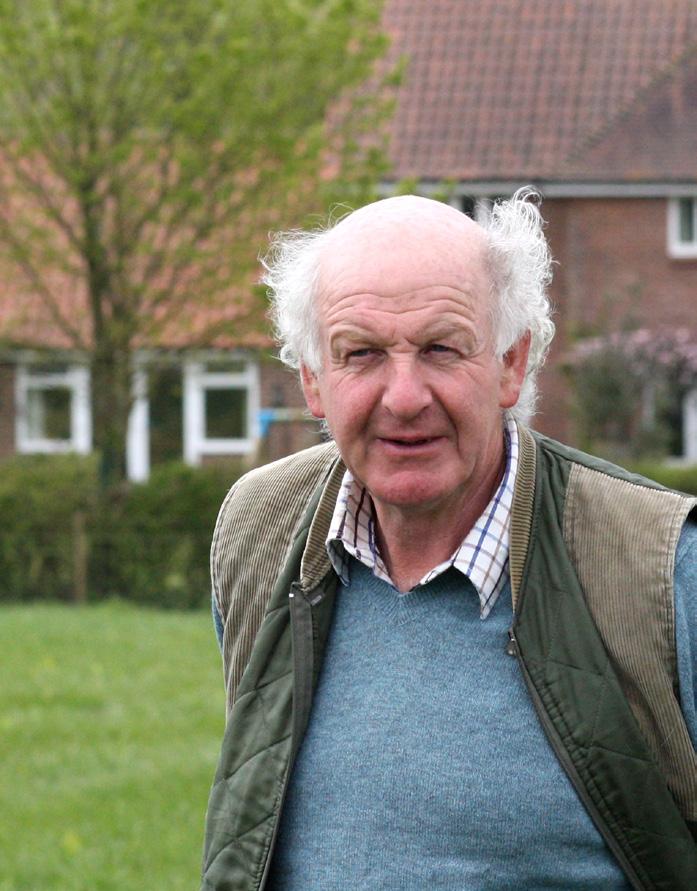
Five generations of wellies at the door –Wakely Cox’s family have farmed in Puddletown for almost a century | Page 16

This month’s Future Farmer is 13-year-old Seb Carr | Page 66

Front cover: Spring fox by Shazz
Hooper
Stalbridge turns out to cheer their European Champion Ruby Else-White! | Page 4

Bill Batty-Smith: 30th March 1929 – 30th March 2024 ‘A proper action man. He was a professional engineer and an old school do-er. | Page 10
There’s 20 pages of What’s On events and arts news this month. Did someone say spring has sprung? | Page 24
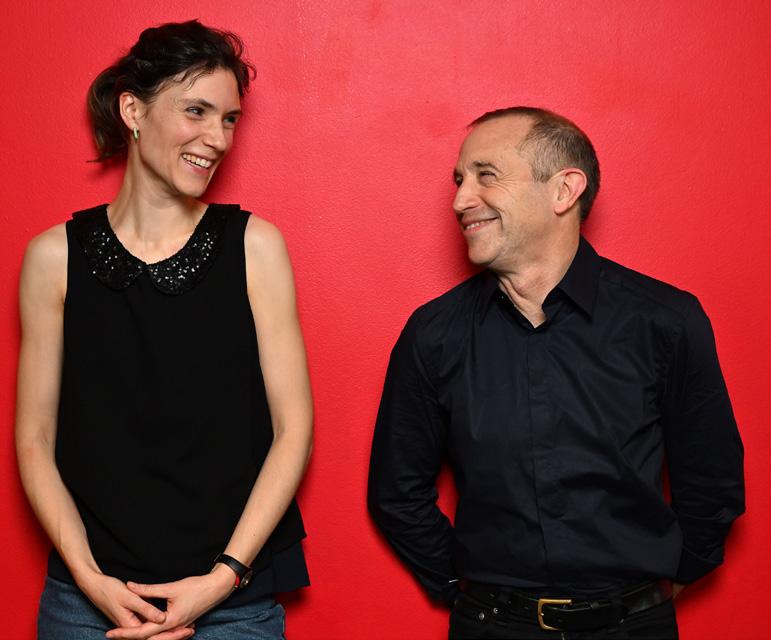

Sally Cooper shares Rodney’s recent medical saga | Page 80
We know, it’s a HUGE magazine, and the page order changes month to month. So we make it easy for you – exactly like grabbing the sections you like best from the Sunday papers, just click the number below to jump straight to the section you want. Or you can just go make yourself a mug of tea and start from the beginning...

Regular readers will have noticed the absence of election-focused content in our latest issues (to be fair, it’s probably a refreshing break given the local election results dominating every news outlet as we publish!). It’s not that we’re antipolitics – FAR from it. In fact we strongly believe in listening, learning and building opinions.
But we’ll never partake in party politics – instead we prioritise firmly balanced, factual reporting around important local issues. For what it’s worth, though, I don’t see local elections as a mud-slinging warm-up act for general elections –they are crucial chapters in our democracy. This month we heard we have been shortlisted in a SECOND major award – the AOP’s Grand Prix award of ‘Small Digital Publisher of the Year.’ To any business, simply being considered in the top five for a major national award – which is judged by the leaders of your industry – is a massive achievement. For our tiny team it’s like getting an invite to the cool kids party. It also tells our current clients and potential new ones that we’re among the best at what we do.
Contact The BV Team: 01258 472572
Editor: Laura Hitchcock
editor@BVmagazine.co.uk
Advertising: Courtenay Hitchcock
advertising@BVmagazine.co.uk
Sub-editors:
Gay Pirrie-Weir
Fanny Charles
Everything else:
Try Courtenay, he’s the organised one...
So I want to take this opportunity to encourage other small businesses to enter the Dorset Business Awards (see Ian Girling’s column on p100). Whether it’s your first time or you’re a seasoned applicant, these awards offer a chance to showcase your hard work and creativity to your peers and your community. Don’t underestimate the value of the recognition — it can open doors to new partnerships and opportunities. Finally, with those judges looking at us right now, it would be a really good time to leave a nice review on Google for us! It’s a small act that can make a huge difference, just by clicking this link, and leaving us some stars (*whispers* five happens to be my favourite number, obviously…) Did you know that from a starting audience of zero in 2020, more than 250,000 people* every single month see something we’ve written? Over the last almost-four years The BV has grown and developed into a publication we’re incredibly proud of. Hopefully you love reading it as much as we love creating it.

* And because we’re purely digital, there’s no guesswork in our stats!
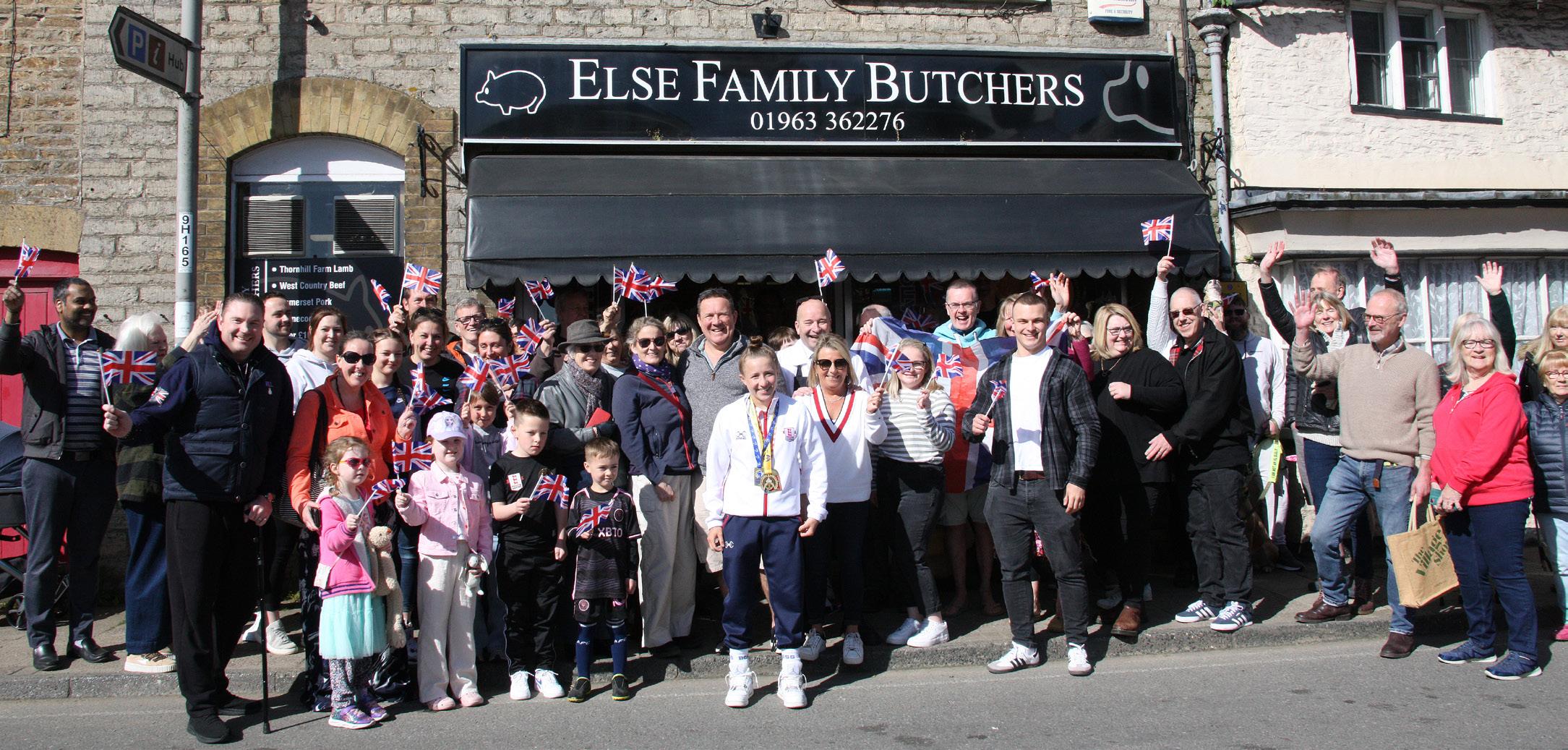
Seventeen-year-old Ruby, celebrating a win in Croatia, now dominates the EUBC Youth European Boxing Championship and ranks second in the world
Early in April, Stalbridge’s Olympic hopeful 17-yearold Ruby Else-White travelled to Croatia for the EUBC Youth European Boxing Championships in Poreč. Fighting in the Under 48kg category, Ruby beat the French junior champion Mathilda Fragnieres in the final by RSC*. The French Boxing Federation’s website, FFboxe, said of the bout:
‘The young Frenchwoman was dominated by an excellent English boxer, an undefeated and reigning European junior champion, who surprised her with her left hook and her speed of execution.’
Back in Dorset, residents of her small home town wanted to show their pride and affection for the teenager who has grown up in their midst and whose stepdad is the local butcher.
As the crowd lined the pavement of Stalbridge’s High Street, the chat was all about Ruby: ‘What an accomplishment! I remember when she was a little thing at Stalbridge Primary – and now look at her!
Second in the world! What an amazing girl she is, she’s worked so hard,’ said one resident. Another agreed: ‘Its not easy, with all the distractions a teenager faces. What a moment for her! The whole town is so proud of what she’s achieved.’
’She’s amazing,’ said another. ‘Coming from a little place like Stalbridge, and be second in the world!
That’s really something!’
Ruby walked up through the village with her mum, and hesitated when she saw the crowd cheering and applauding – overwhelmed that so many had
Stops

turned out to congratulate her on her win. Later, as she signed cards for well-wishers she said: ‘This is mad! It’s like I’m a celebrity!’
In an exclusive interview with The BV last month, her coach Shaun Weeks warned that Ruby would find the European tournament tough: ‘She could be coming up against girls who are well into their 18th year,’ he said. ‘She could be giving away nearly two years to the oldest girls in her new age bracket.’
Ruby is now ranked second in the world for her weight, and has been named Great Britain’s most hopeful Olympic athlete for 2028.
Ruby’s step-dad,Julian Else couldn’t disguise his joy as he wrapped her in a hug.
‘We’re just all so, so proud of her!’ he told The BV.
‘This is mad! It’s like I’m a celebrity!’
‘It’s amazing to see everyone out, supporting her. She’s worked so hard, and most of what she does goes unseen. So to have everyone turn out like this. It’s amazing. We just couldn’t be more proud of her.’
‘I’m just so full of pride. I’m still not sure she realises just how good she is!’ added Ruby’s mum Heidi. ‘My favourite saying is: “Let’s see what happens” … and it keeps on happening! Her focus is now on the TriNations – if anyone will get in the ring with her! And then it’s her dream – the Worlds in November.’
While letting Ruby enjoy her win, coach Shaun is looking keenly to the big year ahead: ‘After the TriNations, we have our eyes firmly fixed on the World Championships. We’re hoping Ruby will be boxing for a world title at the end of the year.’




This month a group of nine North Dorset ladies climbed Britain’s highest three peaks inside 24 hours – and enjoyed a prosecco at the top of each
They are usually found at the county’s steam engine rallies and vintage shows, driving old vehicles and maintaining machinery. However, over the past nine months, a group of ladies from North Dorset have been training for a gruelling charity challenge.
The Rally Girls swapped their overalls and spanners for hiking boots and walking poles, and spent weekends relentlessly training to climb the three peaks – Ben Nevis, Scafell Pike, and Snowdon –inside 24 hours.
The Mountain Challenge
The women planned to summit Ben Nevis first, Scotland’s highest peak at 4,409 ft. The total trekking route is nine miles, and there is currently snow at the summit. Next was Scafell Pike, England’s highest mountain at 3,209 ft. It’s a challenging climb at any time, but their ascent was to be in the middle of the night. The final mountain was Snowdon,
The nine Rally Girls with their guide, Josh, far right, setting out to tackle the first peak – Ben Nevis


or Yr Wyddfa, the highest peak in Wales at 3,560ft. Anyone climbing even one of these mountains needs to be fit, but all three of them in 24 hours? How did they do it?
Ten friends started the challenge: Jules Hunter, Holly Parsons-Fox, Kerry Antell, Laura Antell, Amey Butler, Selena Newman, Sara Beever, Sara Treeby, Charlotte Young and Trish Channon.
The plan initially took seed during last summer’s rally season – admittedly over a cocktail or two.




‘Each time we went to a rally we’d recruit one more person, said Kerry. ‘The steam rallies can be a very male-dominated environment, so when we got together we were intent on doing something for us.’
Nine months of training commenced as the group took the preparation for the challenge seriously,
Jules said:
‘We did some training on our own, and then the first meet up was the Blue Moon Swim –we went swimming in the sea at night. Then we did some group trips and long day hikes. We initially had a coach who was helping us – he tragically died on Crib Goch on Remembrance Day. He was
an ex-serviceman. Part of our training included a 21 mile memorial walk for him.’
completed marathons or tough mudder challenges but some were complete novices.
Don’t let fear rule your mind. Mental agility is just as important as physical ability
Amey explained how the group had managed their own training. ‘All of us have got kids – we just had to exercise around them. We even fitted walking in by doing it at 5 or 6am before the kids were up!’ Kerry admitted she’d found a lot of new places to walk: ‘I’ve lived in Dorset for 30-odd years, but there are lots of places I have never been. It was great to train on the hills and Jurassic Coast right here in Dorset.’
While Amey had previously done lots of mountain walking, Holly and Jules had never done any. Some of the group had
Holly was swift to share her biggest tip on what helped: ‘Blissful ignorance!’
Unfortunately, just one week before the challenge, Charlotte Young dropped a lawnmower battery on to her foot.
‘The battery is absolutely fine,’ her dad, Norman Young, was quick to reassure everyone. The group were down to nine.
‘It was important that all of the charities we’re supporting mean something to us,’ said Holly. ‘We self-funded all our costs – equipment, coaching and travel. So every penny is going to the charities. Because we’re all friends, we know all the same people – so it
made sense that instead of asking each person for money ten times we would just put everything together in one pot, and then divide it equally between the charities we had each chosen.’
The charities the group elected to support are Ducks and Drakes Cancer Trust, Dorset and Somerset Air Ambulance, STARS Appeal, Mouth Cancer Foundation, Endometriosis UK, Devon Air Ambulance, Ickle Pickles, MS Centre Dorset and The Salvation Army.
‘We were hopeful that if we could raise £500 for each charity we would have done really well. But we have exceeded that and donations are still coming in!’
The fundraising pot currently stands at more than £7,000.
The Rally Girls met Josh, their guide for the challenge, in Glasgow: ‘When he met us we were all drinking beer – he must have wondered what he had taken on,’ said Kerry.
‘But we loved Ben Nevis. The weather was really good to us and we got to the top and saw those views. We had planned ahead, and we had a tiny prosecco at the top of each
mountain! And our children had painted stones for us to leave at each peak.
‘It was beautiful up there, we could have stayed all day. But we knew we had two more peaks to climb in the 24 hour time. We actually slid on our bottoms down Ben Nevis on the snow – it was so much fun!
‘But as much as we had loved Ben Nevis, we hated Scafell more. It was dark, freezing cold and there were huge boulders. We found that very difficult. ‘And it sounds ridiculous, but it was really steep! I genuinely never want to go back there. But we kept going.’
Finally, the group climbed Snowdon via the famous Pyg Track. They reached the peak with time for a swift celebration before making the descent – you have to get back down again before the deadline.
‘It was insane,’ said Jules. ‘We just couldn’t believe we had done all this together. When we were on that very last bit of path from Snowdon we were like a pack of football hooligans. We had DONE IT! And then, on the coach on the way home, we were watching the donations come in ... it was just surreal.’


Done ... next?
After such a gruelling challenge, what advice have the Rally Girls got for others contemplating similar?
‘You have to put the training in to enjoy it,’ said Amey. ‘Then you know you’ve given it your best shot. And just keep going! We had a Whatsapp group chat to keep each other motivated, and a good support network helps. And don’t let fear rule your mind. Mental agility is just as important as physical ability for these challenges.’
Now that the Rally Girls have completed this impressive feat they are up for more fundraising challenges and are open to suggestions!
The group will next be together at the Three Okefords Rally in May, kicking off the summer season, and will soon begin planning the next adventure.
• Donate to the Rally Girls Peak Challenge here.
30th March 1929 – 30th March 2024
William (Bill) Batty-Smith died on his 95th birthday, 30th March 2024. Familiar to many as a North Dorset councillor, Bill was particularly known locally for his ability to chair the Planning Committee with a rod of iron. I first encountered Bill BattySmith at one of “his” North Dorset planning meetings. The air was tense as the room filled with local residents determined to give opinions on why affordable housing developments in Blandford and surrounding villages should not go ahead. What struck me was not only how Bill remained impassive and calm throughout the fiery debate, but also how he ensured council officers were protected from the wrath of the public gallery. It is testament to Bill’s leadership that those affordable homes are today full of young families and Dorset’s key workers.
A life in the East
Bill Batty-Smith was born in 1929 and was educated at Sandhurst Military Academy and the Royal Military College of Science. He


did his National Service in the Royal Scots Fusiliers, then was commissioned into the Corps of Royal Engineers, ending up with the rank of Captain. He spent much of the 1950s in Singapore, Malaya and Sarawak before a posting as aide-de-camp to the Commander of the British Forces in Hong Kong. Then he returned to the UK. After leaving the army, Bill worked extensively in the Middle East, specialising in oil and petrochemical health and safety. In 1977 he was awarded an MBE for services to the British community in Lebanon during the civil war. He was in Iran during the 1980 Revolution, and also in Jubail, Saudi Arabia, at the outbreak of the First Gulf War. From 1972 right up until he retired in 1995, he worked in Saudi Arabia, Lebanon, UAE, Bahrain, Oman, Qatar, Iran and Kuwait, plus another stint in the Far East in the northern province of North Sumatra in the early 80s. His work in Kuwait during and after the First Gulf War was mainly co-ordination, command and control of emergency services cover for the EOD (Explosive Ordnance Disposal) and oil fire-fighting teams, to ensure their safe passage in
and out and to ensure effective casualty evacuation cover in the case of an incident.
A tireless community man
In 1996 he found a new and very active role in local politics. He was elected to North Dorset District Council (NDDC) in 1999 as the representative for Stalbridge, and was twice reelected. He also served on the Dorset County Council Health Scrutiny committee for ten years, and worked as an independent chairman dealing with complaints against the NHS. Bill was also a member of the council of governors at University NHS Foundation Trust.
Victor Fox, former chairman of NDDC, worked with him for many years: ‘I first met Bill in 1999, when he and Ron Ash were Conservative candidates for Stalbridge in the North Dorset District Council elections. They won, and we went on to form a new ruling team with help from two independent candidates. Bill quickly became a member of the Planning Committee, where his wide experience of the construction industry was much appreciated by the other members ... if not always by the planning officers or developers!
‘I well remember being a member of the committee with Bill as chairman: he would deal with crowded meetings over many a difficult decision with resolute firmness. But he was always polite to everyone.’
Graham Carr-Jones also worked with Bill as a district councillor representing Stalbridge. ‘He knocked on my door one day and said “I need a running mate. What do you think?”
Unfortunately I didn’t say no fast enough!
‘We worked the patch together as a partnership in Stalbridge and we got a lot done. We achieved free car parking, and we got The Hub for the village. We also got the library and kept the public toilets open when Dorset Council was trying to close them. Bill got some affordable housing passed as well.’
Bill was invited to the Council cabinet, but declined the position, feeling he could be of more use in Planning: “Over the years I have served on almost every committee, and as chairman or vice chairman of most of them, but my main emphasis has been on Planning. This has had its amusing moments, such as the person who put in an application to divide a curtilage and then

when it came before committee, spoke eloquently against the division. There were also times when the agenda at full council was sleep-inducing. In my early days, I could rely on Angus Campbell to dig me in the ribs, but when this service was no longer available there was one occasion when Michael Oliver, in the chair, had to use his gavel to wake me up.”
He was a proper action man. He was a professional engineer and an old school do-er

When Bill stepped down from NDDC in 2019, just before his 90th birthday, his work was recognised with the title of Honorary Alderman. Bill was proud of the council’s work, and in his letter of thanks, he said “North Dorset has, I think, set a standard for not only the county of Dorset but for how local government should operate. Controversial items have been resolved by sensible discussion between members of all parties and there has been none of the childish and immature ‘slanging’ which seems to be fashionable in the higher levels of what passes for Government these days.”
It was acknowledged at the time that he had chaired the most difficult committee in the council – that of planning.
Daughter Jules Batty-Smith paid
tribute to her father: ‘Dad was the wisest and most knowledgeable man I have ever known, my idol and navigator in life. I miss him daily and the house is so quiet without him. He had such a hard time over the past eight months, but it has been my pleasure to spend every single day with him. He was a great distraction while I went through chemo – he waited until I got the all-clear from cancer, just two days before he passed, and until my daughter Georgia returned from university, before he asked to go. For him to leave this world on his 95th birthday, which was also his wedding anniversary, at home and surrounded by family ... it is just how he would have wanted it. On his terms, as always.
‘He married mum, Anne Buck, at St Mary The Boltons, London, on 30th March 1957. He met her in Borneo, while he was serving, and asked for her hand two weeks later. She said no, and he pursued her for two years before she gave in. Typical dad, always getting what he wanted in life.’
Bill is survived by four of his five children, and five grandchildren. Graham Carr-Jones summed up his friend: ‘Bill Batty-Smith was a proper action man. He was a professional engineer and an old school do-er. The Bills of this world are a generation we are losing. He was a proper bloke –The Chairman to the last.’
After a year of rigorous training and overcoming nerves, the young boxer showcases his potential and snatches his first national title
Freddie Norman turned up at the Sturminster Newton boxing gym with his dad just over a year ago.
‘He said he’d visited when we had our open sparring,’ says coach Shaun Weeks. ‘He just loved the feel of the club and the way it was run, and felt that this was the place he wanted to learn the rest of his trade.’
Now Freddie travels up from Parkstone three days a week to train with Shaun and his team – and in April he won his first national title.
Still a junior, 14-year-old Freddie boxes in the under 63kg category – a professional Lightweight.
‘When he came to us he’d had six bouts – won three lost three.’ says Shaun. ‘Since then, he’s had 12 bouts and won 11 of them. That single loss was his second contest, he was stopped in a national quarter finals by a lad called Reuben James.
‘And what was nice about the recent competition weekend at Loughborough was that he was pitched against Reuben James again in the semi-final – only this year Freddie got a points win!
‘He then faced Charlie Hewitt, an unbeaten lad from the north west who comes from an old-school boxing family. Freddie beat him on points too, giving him his first national title: National Junior Cadet Champion.’
Following his win, Freddie was invited to the England Boxing Talent pathway trials, but of the 90 boxers who attended only six were selected, and unfortunately Freddie missed out. However, the feedback from the coaches was really positive, and he’s been invited to attend the junior England prep camps for the European Championships and other competitions, to provide sparring practice and to help the competitors prepare.
The Junior bracket is a two-year window, currenty for boxers born in 2008 and 2009, and Freddie is right at the bottom of the age group. Selection was always a long shot, says Shaun. ‘And then when he was sparring, he missed his work a little bit. When we spoke afterwards, he admitted he’d been very nervous, it being his first time there. And he felt he rushed his work a little bit. But it’s a great learning curve – and the right people have seen him now. The fact that he’s been invited back to do sparring … It took me 18 months before they’d even look at Ruby Else-White, and she started the same way, by being

invited up to spar to aid the England team prepping for a competition.
‘So at least we’ve got our foot in the door. I’m confident he’ll end up boxing for England, he will win national titles in the future – he’s dedicated, and he’s a good lad.
‘And for a small rural club to have not one but TWO national champions! But the quality of the boxers coming through is amazing, we’ve got a great coaching team, a good working committee, and we’ve got lots of local support, which is excellent.’
For every competition the Sturminster Newton boxers enter, the club needs sponsors to help with costs: they are usually looking for ten businesses to donate around £200 each. They’ll get their logo on the event uniform T shirt, plus social media exposure. ‘Local trips aren’t so bad,’ says Shaun. ‘But we travel all over the country – we’re off to Sweden in November.
‘Other businesses support the kids with a regular monthly donation: whatever they can manage, even £20 helps, and that really helps to keep us ticking over. We only draw from it for travel costs, mainly for Ruby –and now Freddie – when they’re travelling to wherever the England camps are.’
If you’d like to get involved, contact Shaun on Sturabc@aol.com or 07817 243101
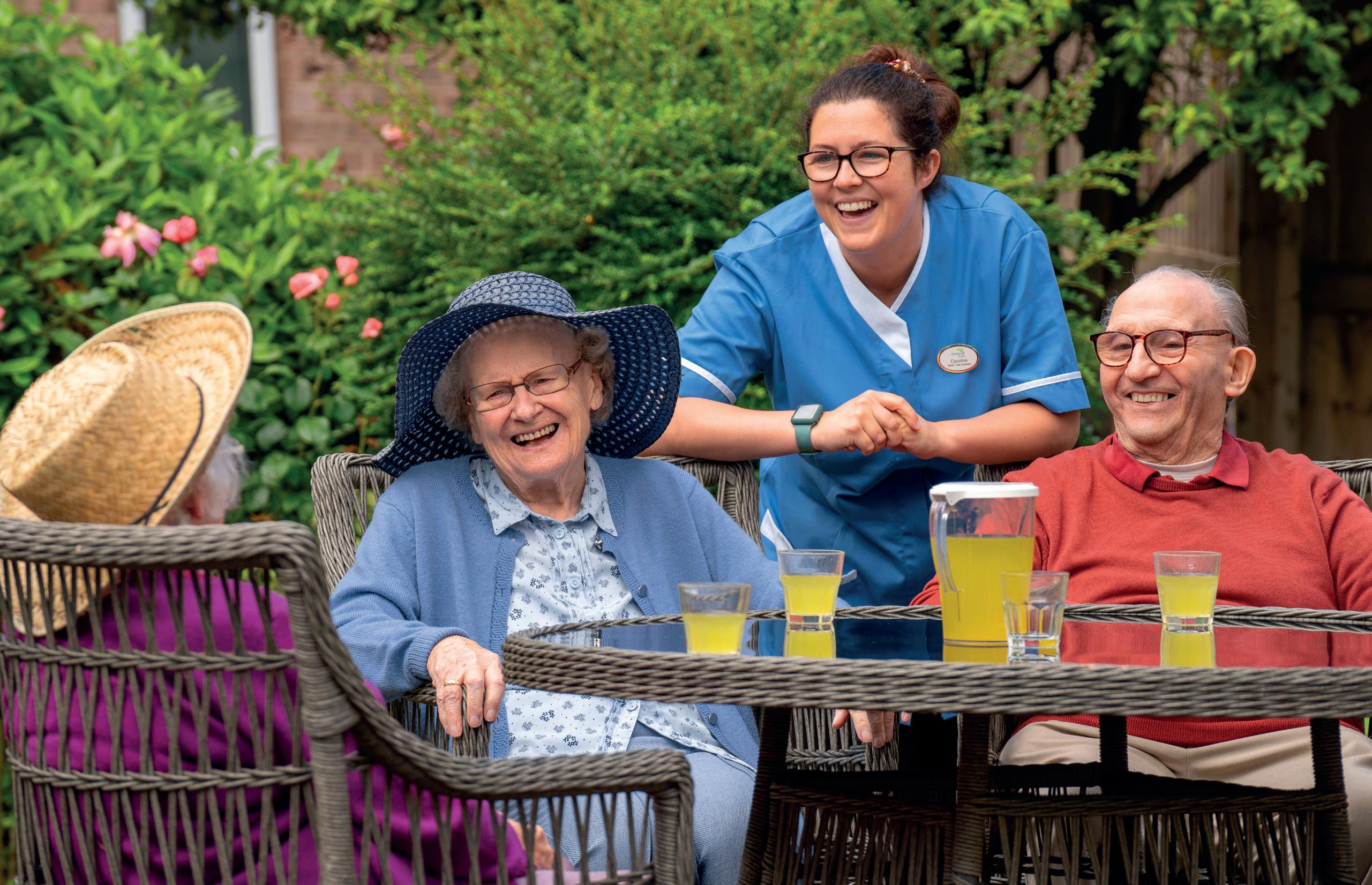










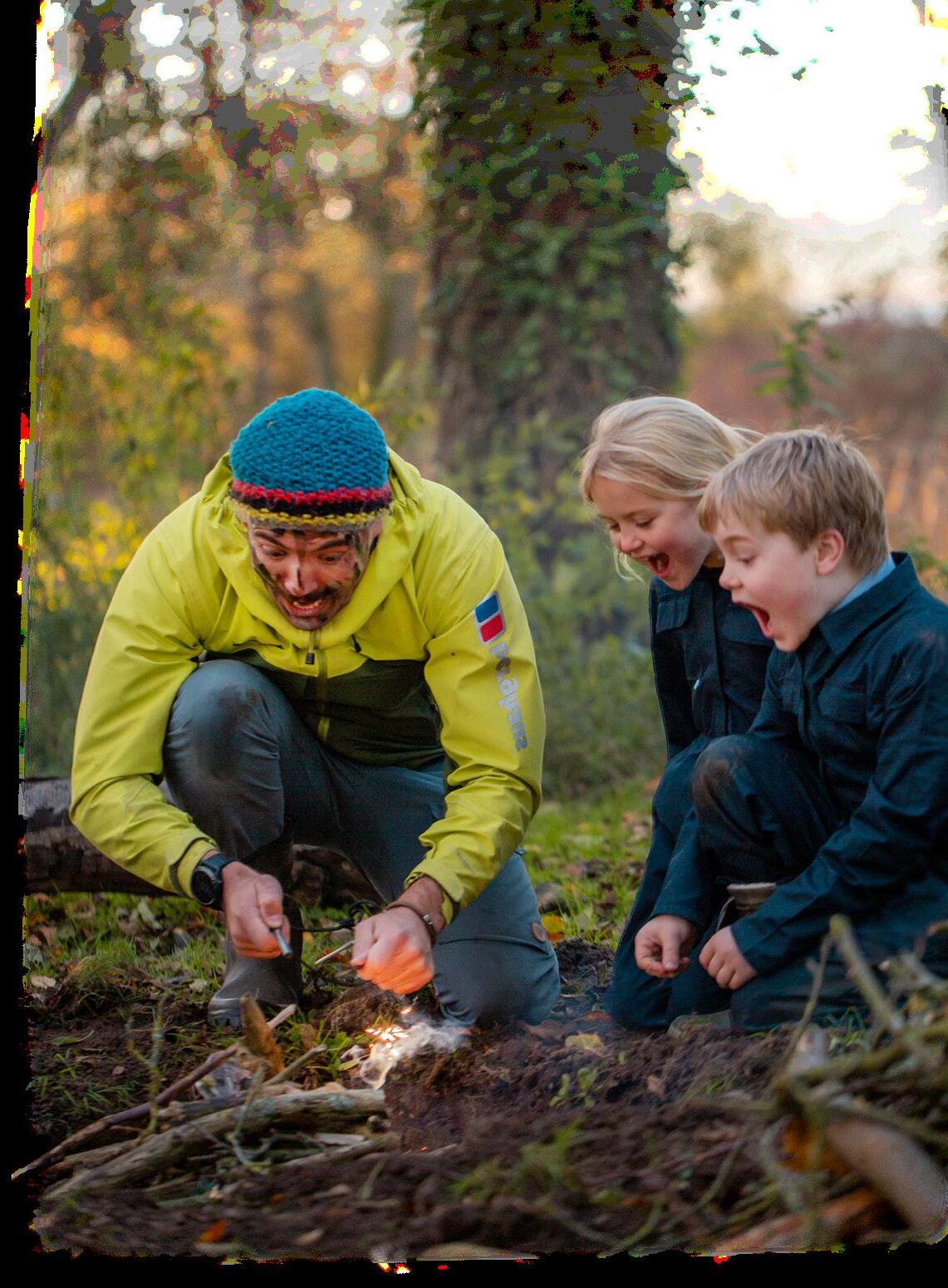
Wakely has a small flock of 130 sheep – his eldest son Anthony has a flock of 800. All images: Courtenay Hitchcock

Tracie Beardsley catches up with renowned Dorset farmer Wakely Cox, whose family have farmed in Puddletown for almost a century
Outside the farmhouse door, wellington boots of various sizes stand to attention. Dora, the golden labrador puppy, enthusiastically welcomes me into the kitchen where there’s a delicious smell of homemade scones. At a huge pine kitchen table, Wakely Cox chats with Anthony, his eldest son and a dead ringer for his dad. Anthony is a fifth generation Cox farmer – as are Wakely’s four other
sons: Edward, Rupert, Benjamin and James, ranging from 36 to 28 years.
Dorset farming is in the Cox genes. Wakely’s great grandparents, along with his grandparents Jack and Dorothy, moved from Beaminster to Puddletown in 1932 as tenant farmers at Stafford Park. After 20 years of hard graft, Jack and Dorothy managed to buy the farm.
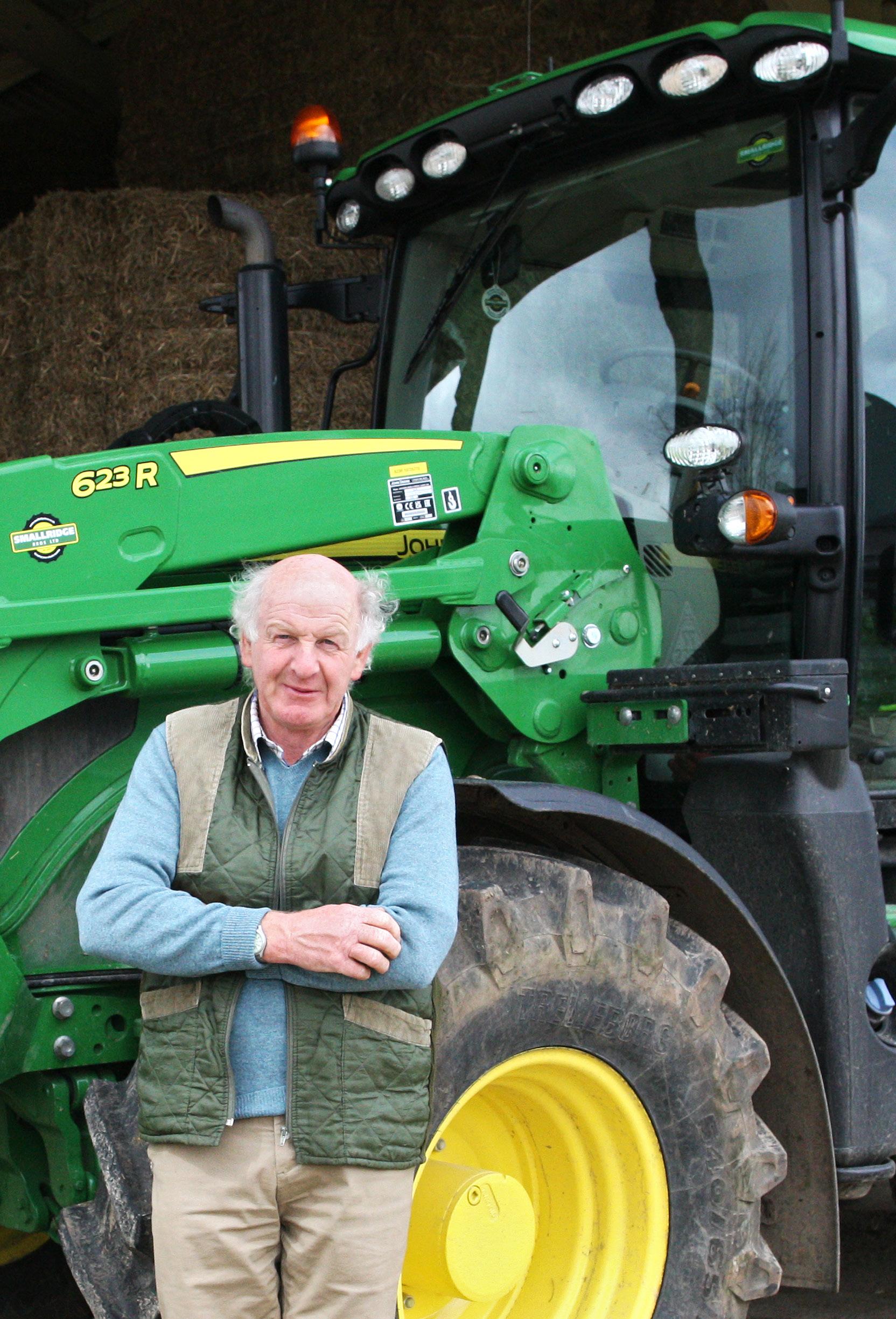

Wakely’s parents John and Mildred continued the legacy, and today, Wakely, his wife Caroline and their five sons farm 1,300 acres of mixed arable, cattle and sheep from their base at Warren Hill Farm.
History tends to repeat itself: Wakely’s parents met at Young Farmers, and so did he and Caroline: ‘Caroline represented Blandford and I was Dorchester. Our eyes met across a heated farming debate!’
Wakely recalls his childhood fondly: ‘I loved going in the Land Rover with Father to help feed the cattle. I was never keen on school, so as soon as I got home, I’d be out on the farm. There was always so much going on – lambs being born, cattle to be moved ... ‘More men worked on the farm then. I remember them whizzing home on their bikes for lunch. And the smell of a pipe instantly brings back my grandfather. Happy memories.’
After leaving school, Wakely worked on a farm near Upwey while studying agriculture at Kingston Maurward. Later, he returned to the family farm to work for his parents. He also found time to teach future farmers and employees at Kingston Maurward. ‘It was another income stream for me, but just as importantly, it got me off the farm and gave me another interest. I love what I do, but I knew I also needed to get off the farm and see other people.’
He still stands by that thinking today. He was chairman of the Dorchester Agricultural Society for many years, and now, as chair of Dorset NFU, he travels all over the country. ‘Once I’m in my truck and heading to a meeting, I leave the farm behind to concentrate on other things. Modern farming can be very
Wakely’s sheepdog Pops hitching a ride to check the calves – she broke her leg a few years ago and has limped ever since
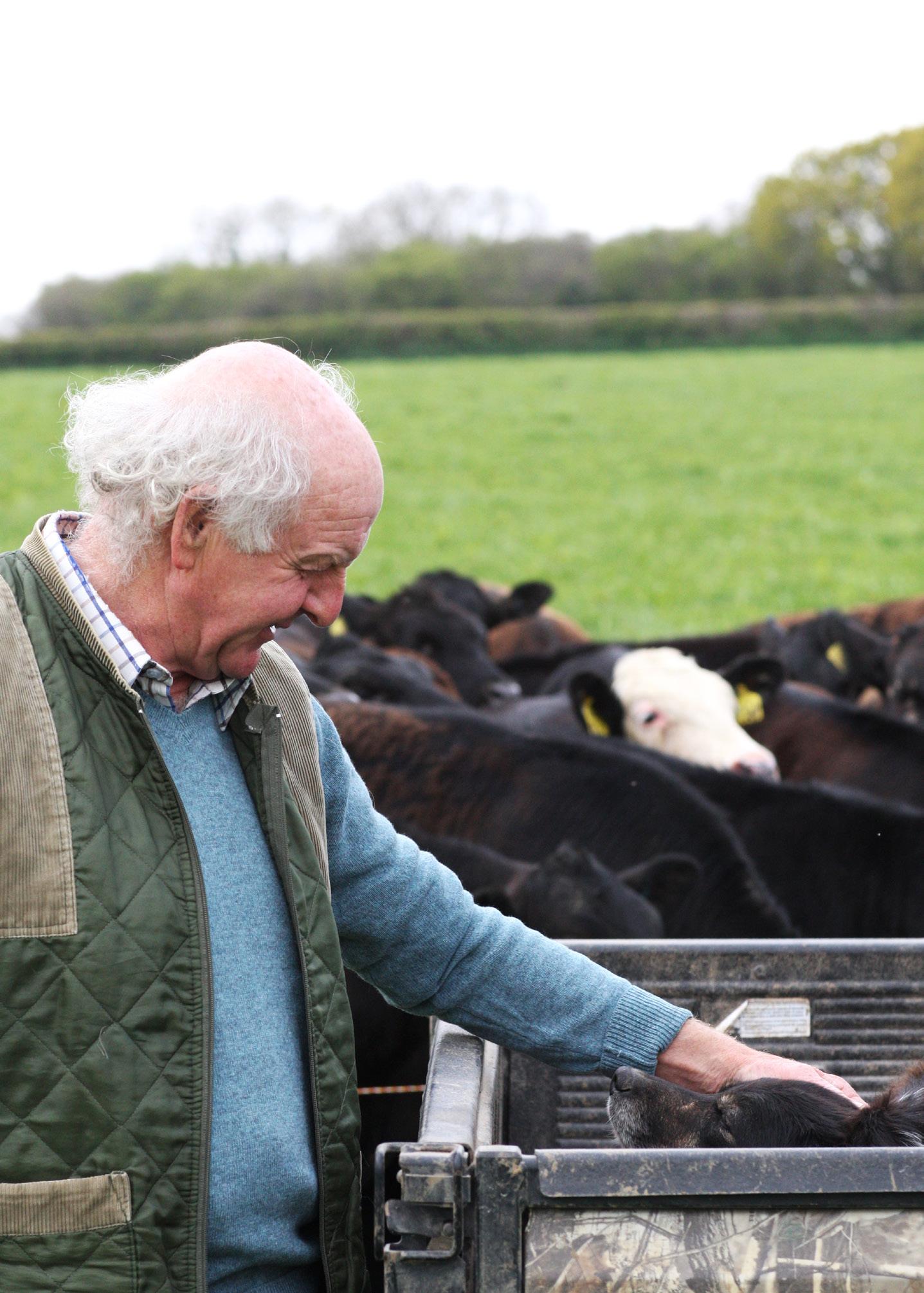
isolating. You can get stuck in your own ways and not see the bigger picture.
“Papa, take me out in the Land Rover on the farm” – it’s like a farm echo, I can feel life coming full circle
‘I meet up with farmers nationwide. Northern farmers have had a quarter of their corn ruined and lost sheep lambing in the awful weather this spring. It’s made me realise just how lucky I am farming in Dorset. I tell other farmers they must get out and see the bigger picture.’
He’s instilled this mindset in his sons, too. ‘I never pushed the boys to join me on the farm.
They’ve all done their own thing. Edward farmed in Canada. Ben and Rupert have done harvests abroad, and they have all worked on other farms. Our youngest lad, James, is show organiser for Dorset County Show – but he still helps out feeding calves or hauling corn. Anthony has 800 sheep of his own and scanning rounds, so he works part-time for us. We all help one another.’ The day I interview him, Wakely is preparing to meet the Secretary of State. ‘There’s an election coming up, and he’s keen for the farming vote!’
Wakely is hugely respected as an advocate for Dorset farming. Not scared to put his head above the parapet, one of his other roles
is as chair of the Poole Harbour Agricultural Group, challenging the Environment Agency and the apportioned ‘farmer nitrate pollution’ of Poole Harbour.
‘Farmers need to clean up their practices, but the EA presents us historic data – it’s 20 years out of date! To prevent nitrate leaching we need up-to-date facts in order to encourage a voluntary farmerled scheme, not heavy-handed regulations.’
Is he positive about farming’s future? ‘Very, very positive. People will always need feeding! Shipping in food from abroad is just not sustainable. Home grown is the way ahead – if people will learn to eat more seasonally and sensibly. Yes, of course farming practices will change. But everything evolves.’
And at 63, does he still love farming? ‘How could I not? This is my life, it’s not just a job. I still get a thrill seeing a lamb born – new life that within a few minutes is up and about.
‘My seven grandchildren bring me a huge amount of joy, too. When they ask me “Papa, will you take me out in the Land Rover on the farm?” it’s like a farm echo, I can feel life coming full circle.’
Book by your bedside?
Thursday Murder Club by Richard Osman. Reading helps me switch off and I love this series so I stay up reading too late. Not ideal when you’re up at 5.30am!
A-list dinner party guests?
My family and friends –some friendships Caroline and I made through Young Farmers go back more than 40 years. My old boss Mike and his wife Anne Lasseter, too: great employers to whom I owe much.




Proposed map of the site, supplied by Wyatt Homes
Secretary of State calls in controversial plan for 490 homes outside Blandford – to the delight of

Felicity Buchan, Minister for Housing and Homelessness, has called in an application by Wyatt Homes to build 490 homes between Blandford and Pimperne, on behalf of the Secretary of State. A planning inspector will now carry out a public inquiry into the proposal. This followed Dorset Council’s Northern Area Planning Committee’s second decision to approve the application. The second meeting was called so that changes to material planning considerations could be taken into account. Campaigners had hoped that the committee would defer the meeting until members had had training on the latest planning legislation. But the need for this was ignored by both officers and committee members. The planning officer downplayed the potential effects of the planning changes on this application. The initial plan was strongly opposed by the Cranborne Chase National Landscape (CCNL), North Dorset CPRE (Campaign to Protect Rural England), Pimperne Parish Council and local residents. North Dorset MP Simon Hoare also spoke on behalf of the opposition group. The approval triggered a call-in request to the Secretary of State by the campaigners on the grounds that the planning committee had failed to deal with several matters of national importance, including the failure to uphold the recently remade Pimperne Neighbourhood Plan and the support of a major development within a National Landscape,
Building 490 dwellings on productive farmland does not protect that landscape, nor conserve and enhance its natural beauty
without exceptional circumstances.
The call-in letter tells Dorset Council that the Secretary of State particularly wishes to be informed about:
1. The extent to which the proposed development is consistent with Government policies for delivering a sufficient supply of homes in the NPPF (Chapter 5)
2. The extent to which the proposed development is consistent with Government policies for conserving and enhancing the natural environment in the NPPF (Chapter 15)
3. The extent to which the proposed development is consistent with the development plan for the area
The news of the call-in was greeted with relief by campaigners. Richard Burden, CCNL Principal Landscape and Planning Officer, said: ‘Building 490 dwellings and other buildings on productive farmland in one of the nation’s finest landscapes does not protect that landscape, nor conserve and enhance its natural beauty, as intended by the National Parks and Access to the Countryside Act of 1949. The CCNL therefore welcomes the decision to call in the application for full and objective scrutiny.’
The news that there was now more than a five year housing land supply in North Dorset, with planning decisions supposedly then following development plans, initially made campaigners confident they stood a good chance of stopping the developers. The planning officer’s report to the October meeting acknowledged a conflict with the council’s own development plan, which said building in the countryside should be resisted.

But the committee gave the scheme the go-ahead. Campaigners agree that the development is well designed, but is clearly in the wrong place. The CPRE was disappointed that the committee did not include Blandford representatives. The approval was particularly galling for Pimperne Parish Council chairman Peter Slocombe, who, with volunteers, spent hundreds of hours creating the Neighbourhood Plan, which was disregarded here and in a recent previous application. Pimperne would receive no Section 106 (planning gain) benefits from the development.
planning approval, October 2023
The key grounds of objection to this Blandford development were:
• Housing targets in the North Dorset Local Plan for Blandford Forum and Blandford St Mary, as well as in the surrounding villages, had already been exceeded thanks to a massive local building programme in recent years.
• The limited evidence of the need for a new school, which would allegedly be paid for by the Section 106 developer funding tied to this application. Should the currently declining school rolls reverse, expansion could be achieved more cost-effectively with a few extra classrooms
• The development will cause harm to the Cranborne Chase National Landscape, and its setting, on whose land some of the development would be built, with views both to and from it seriously affected
• There is conflict with Pimperne’s Neighbourhood Plan – and the 150 homes which would be built within that parish would threaten the important “gap” between the village and Blandford
• Good farmland, which contributes to food security and acts as a carbon sink against climate change, would be sacrificed
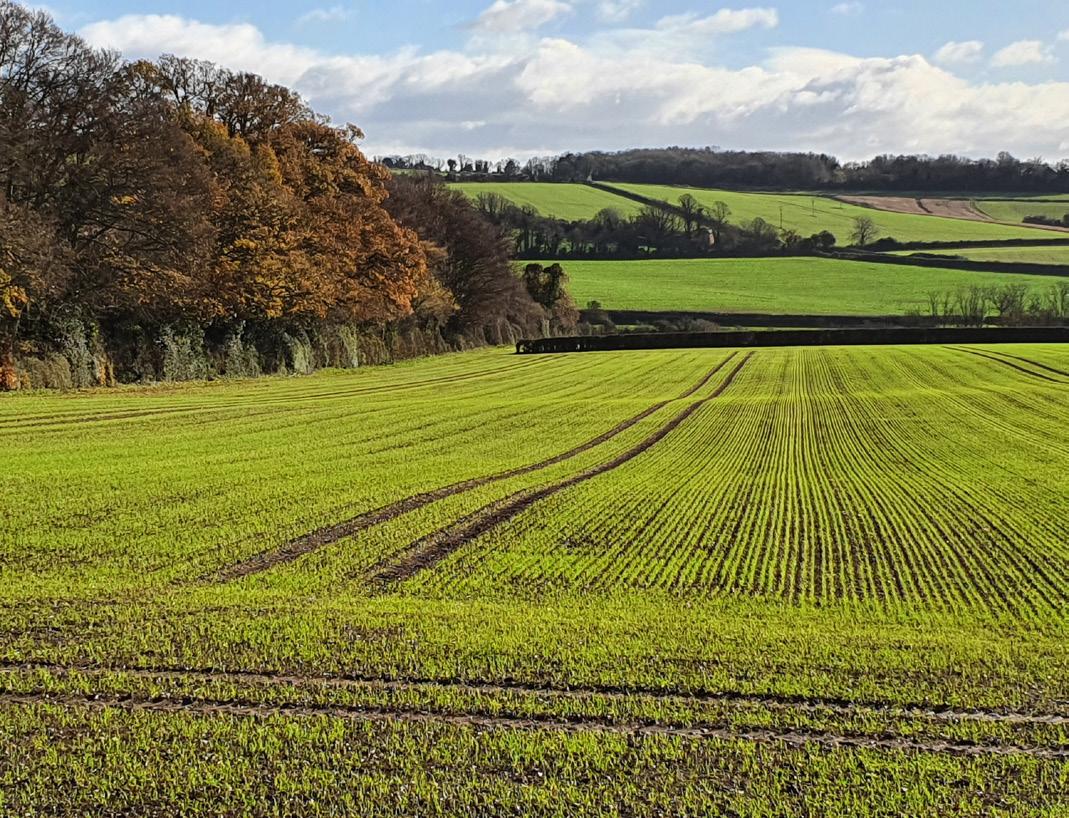


Have confidence in the decisions you make.
When it comes to giving advice, we take the time to get to know your business and what you want to achieve, whilst making sure that we explain your options in everyday language.
By working with us, you can be confident that whatever decisions you make, they’ll be based on sound legal advice that’s in your best interest.











Shaftesbury Rotary Club are delighted that their hugely popular annual fundraiser is back this month – complete with the new Family Ride
The annual North Dorset Cycle Ride will take place on Sunday 19th May 2024. As usual, there will be two routes – a 25-mile ride, and a 50-mile ride. Both with strat from Park Walk, and both will finish with the iconic ride UP Gold Hill.
The 50-mile ride will start from 8.30am, and the 25-mile ride from 9.30am – registration opens an hour before the rides start.
The Family Ride that was launched successfully in 2023 will also feature again. This year the family ride will wind around the town – with fun on the way – along safe side roads, and it’s ideal for beginner and energetic junior cyclists. When it reaches Shaftesbury Primary School, a range of skills tests will be on offer, led by local Rotarians and supported by RotaKids from Shaftesbury Primary and Abbey Primary schools.

Every competitor who completes a ride will receive a medal. Full details of the ride and how to enter can be found on Shaftesbury Rotary Club’s website – follow the links to the North Dorset Cycle Ride. The main beneficiary will be the
HOPE Charity, and for the third year running, the event will be sponsored by BV Dairy. If you want to know more or to get involved with Rotary, please contact: hello@ shaftesburyrotaryclub.org










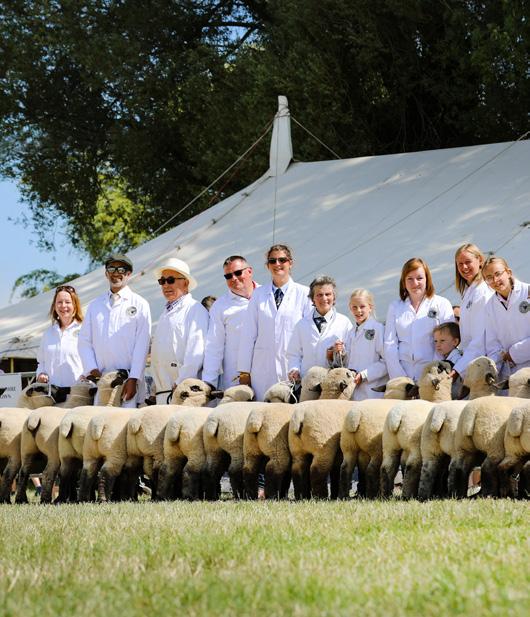



The village of Poyntington is roughly two miles north of Sherborne. This year, the village’s annual May Fair will be on the 18th of May, from 10am to 4pm – entry is completely free, and there’s plenty of car parking. It will be held in the grounds of the historic and beautiful Poyntington Manor House, whose gardens will also be open for all to enjoy. Sir Walter Raleigh spent his last night as a free man at the manor, before being taken to the Tower of London!
The Wessex Morris Men will be dancing at 11.30am and 1.30pm, there will be live music from local artists, stalls selling plants, local produce and wares from local artisans, as well as refreshments and activities for children including a Book Character fancy dress competition, which will be judged at 2pm. Something for everyone!
All proceeds from the fair will be split between All Saints
and The Rendezvous
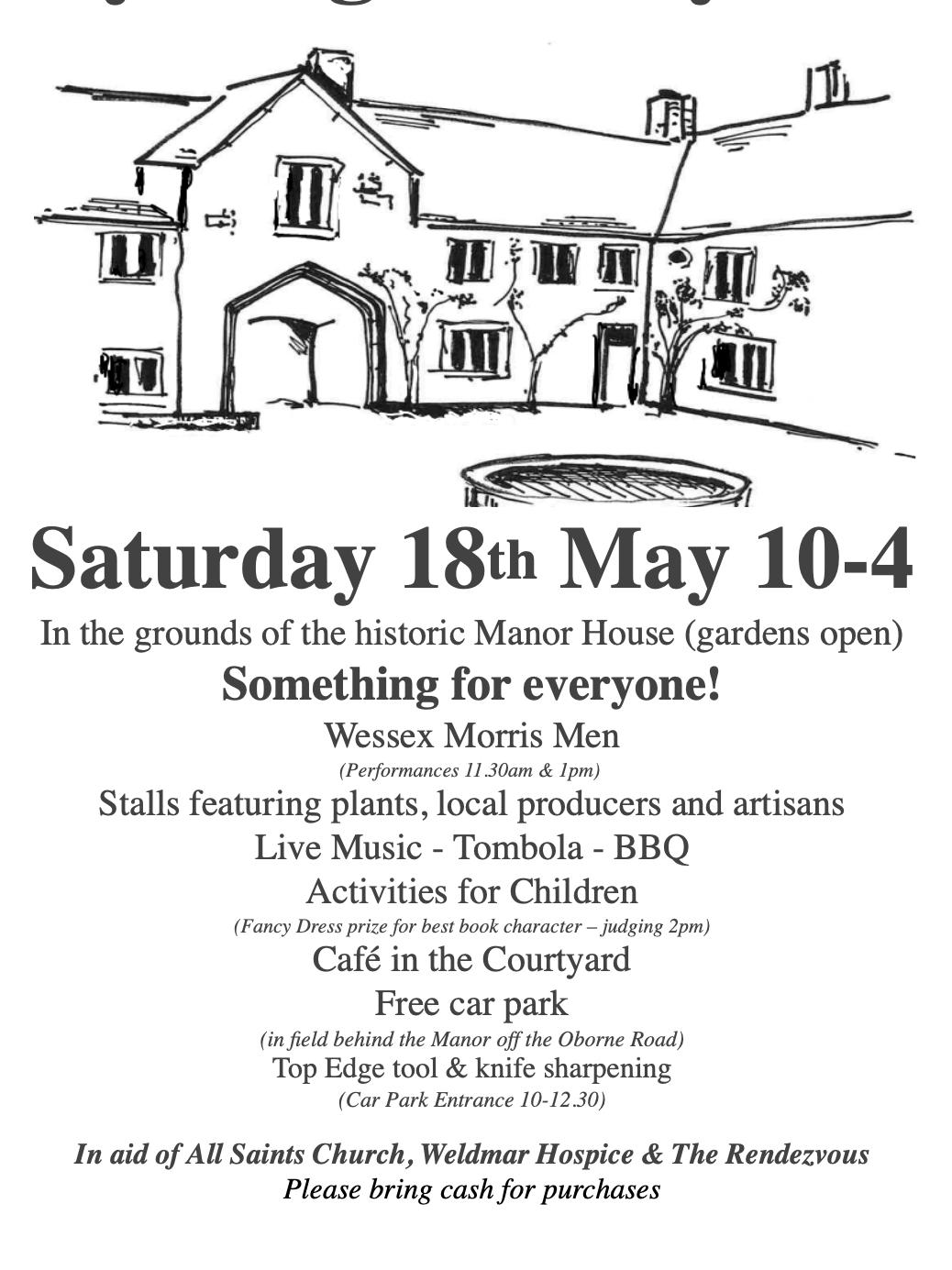


Artreach present the stars of the UK Klezmer scene, She’Koyokh in concert 7.30pm.
Join She’Koyokh for a Balkan & Yiddish Circle Dance Workshop 4pm6pm No partner required Open to all. Booking essential

QUIZ NIGHT
THURSDAY 9TH MAY
Join us for a night of trivia and fun
Gather your team and put your knowledge to the test with our entertaining and challenging questions Doors open 7pm for a 7.30pm start. £4 per person Tables up to 6 people


Our priority is to make sure that we continue to deliver our commitments and ensure we remain an effective Community resource for Sturminster Newton & North Dorset. We have a number of fundraising events this year including 3 on this page!! The Quiz Night, Art Race and Summer Ball.



It’s an overlooked village which everyone drives through to get to Stur –but Hinton St Mary has olde worlde Dorset charm by the bucket
Nestled amid the lush greenery of Dorset’s rolling countryside lies the tiny village of Hinton St Mary – a hidden gem just a stone’s throw away from the charming town of Sturminster Newton. With its picturesque landscape, historic manor house, Tithe Barn, interesting 17th and 18th century thatched houses and tranquil surroundings, Hinton St Mary offers a quiet retreat for those seeking a peaceful escape from the hustle of modern life. At the heart of the village stands St Peter’s Church, rebuilt in 1846 but retaining its 15th century tower and 12th century font. Built of locally-quarried stone, the church’s sturdy walls and tower dominate the skyline, drawing visitors and residents alike towards it.
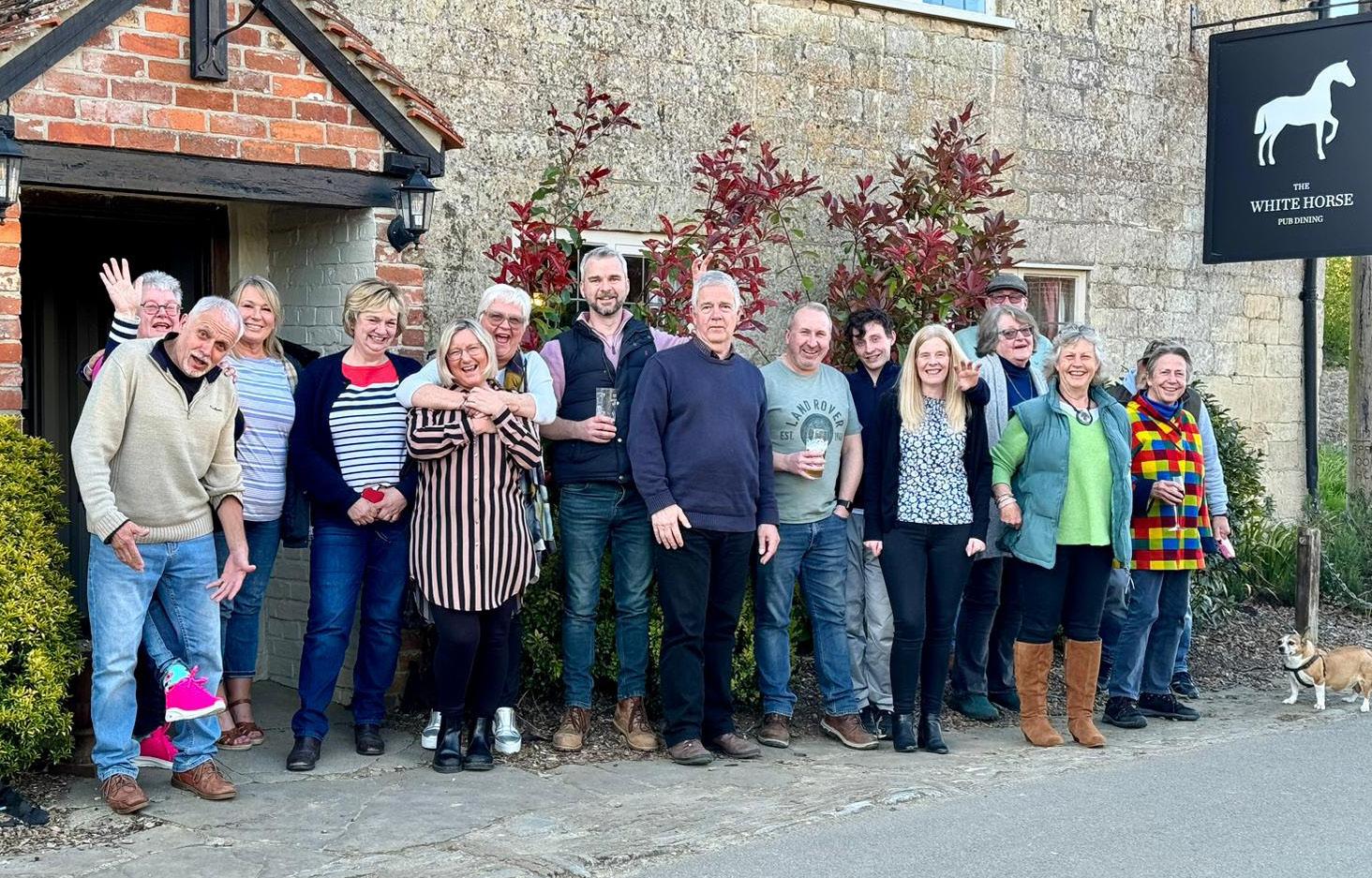
Wandering through the narrow lanes that criss-cross the village, it’s hard to avoid feeling as though you have slipped back to a bygone era of rustic charm. Properties exude Dorset character, from timberframed facades adorned with climbing roses to the beautiful gardens overflowing with blooms. The village’s Millenium Garden was created by a community collaboration in 1999, and its construction was filmed by BBC2 for Charlie Dimmock’s show ‘Charlie’s Garden Army’. As the sun dips below the horizon, casting a golden glow over the surrounding hills, the village comes alive with warmth and camaraderie. Villagers gather at the pub, The White Horse, to share stories and laugh over a pint, a wine or the pub’s outstanding food made from fresh, locally sourced ingredients. Visitors are of course welcomed with open arms!
Historic manor house, Tithe Barn, 17th and 18th century thatched houses and tranquil surroundings ...
For history enthusiasts, Hinton St Mary boasts a wealth of heritage. In 1963 the remains of what was thought to be a fourth century Roman villa were discovered here, complete with a mosaic pavement of over 90m2 with a centre roundel thought to depict the head of Christ. (you can read more about the Hinton mosaic in the late Roger Guttridge’s article in the July 2022 issue of the BV here). The mosaic is now held at the British Museum in London – recent excavations have shown that the Roman area was much larger than originally thought, and may have been an early Christian settlement rather than a single villa.
This year’s Gardens Open event is anticipated to be the best yet. Including the manor house gardens, there will be more than 20 individual gardens open to visitors, plus a classic car show situated close to the manor gardens, and a working vintage steam traction engine near to The White Horse Inn at the centre of the village.
There will of course be an abundance of delicious homemade cakes, with hot and cold refreshments in the Tithe Barn, and a generous plant stall.

A weekend ticket costs £6 per person (under 12’s are free), with complimentary parking next to the cricket ground – accessed through the main Manor House gates.
• 15th and 16th June
• £6 per adult, under 12s free
• Hinton St Mary, DT10 1NA
• Tickets will be available at the Manor House gates each day.
• Disabled parking available close to the Manor Gardens entrance.
• Please no dogs
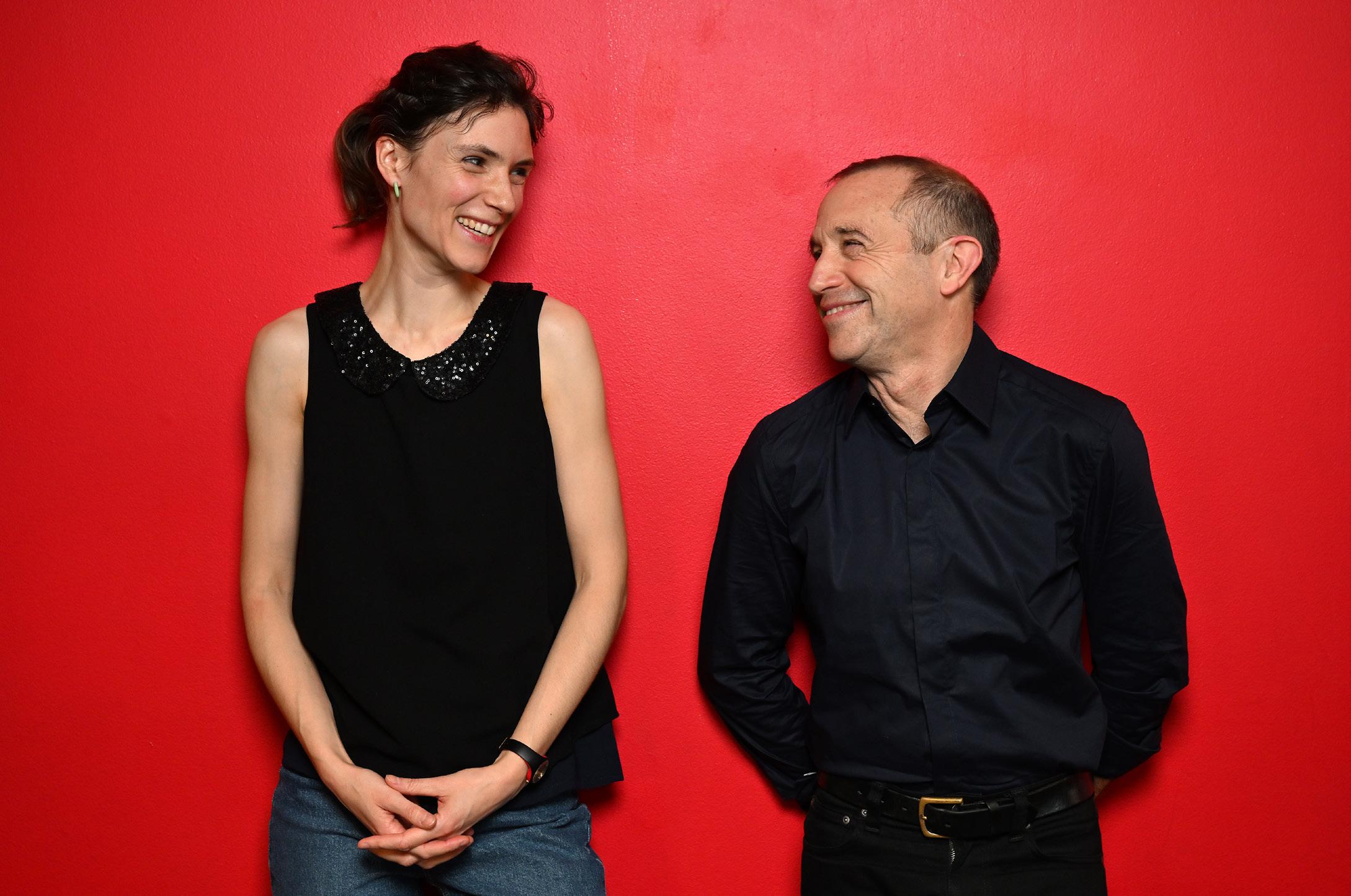
The distinguished conductor Mark Wigglesworth has been announced as the new chief conductor of the Bournemouth Symphony Orchestra. He will take up the role at the start of the orchestra’s 2024-25 season in September, when Kirill Karabits, the BSO’s inspiring Ukrainian-born chief conductor for the past 15 years, becomes Conductor Laureate and artistic director of the Voices from the East programme Wigglesworth, who has been the BSO’s principal guest conductor since 2021, is one of the world’s leading conductors, recognised for his outstanding musicianship, extraordinary interpretations and breadth of repertoire. He has worked with the Berlin Philharmonic, London Symphony, New York Philharmonic and Royal Concertgebouw orchestras and performed at the world’s most prestigious opera houses. He will be the first British conductor to hold the BSO post in more than 60 years, and he is expected to conduct five weeks in his first season, increasing to nine
weeks from 2025/26.
He says: “The BSO embraces the role of a 21st century orchestra with talent, experience, passion and care. The commitment the entire organisation shows to the many thousands of music lovers across the South West of England is inspirational and I am extremely excited to be joining them at a time when classical music’s undeniable force for good has never been more vital to the quality of our communities.”
The new principal guest conductor will be Chloé van Soeterstède. The announcement follows her recent guest appearances, where she has won praise from the BSO’s musicians and audiences alike. She was appointed the Taki Alsop Fellow 2019-21 by former BSO principal conductor Marin Alsop and was a Dudamel Fellow with the Los Angeles Philharmonic in its 2021-22 season. She trained as a viola player before turning to conducting, and is a passionate advocate for music education.
Matt King, the BSO’s principal percussion and musician trustee, says: “Concerts with Mark are a highlight in the schedule, and we’re delighted at his appointment as chief conductor. We have enjoyed a broad mix of repertoire together in recent years, with music from Mahler and Mozart to Sibelius, Shostakovich, and Wagner – it will be exciting to continue this journey. Chloé has been a real revelation and brings energy and fresh insight to the podium; we are looking forward to the next few years together.”
BSO chief executive Dougie Scarfe says: “We’re excited to share the truly world-class live performances that both Mark and Chloé will undoubtably bring to people throughout the South West over the coming years. Lifeempowering live music is at the core of what we do, and we’re thrilled Mark and Chloé share our vision for how an orchestra can proudly serve communities in and beyond the concert hall.”
• bsolive.com




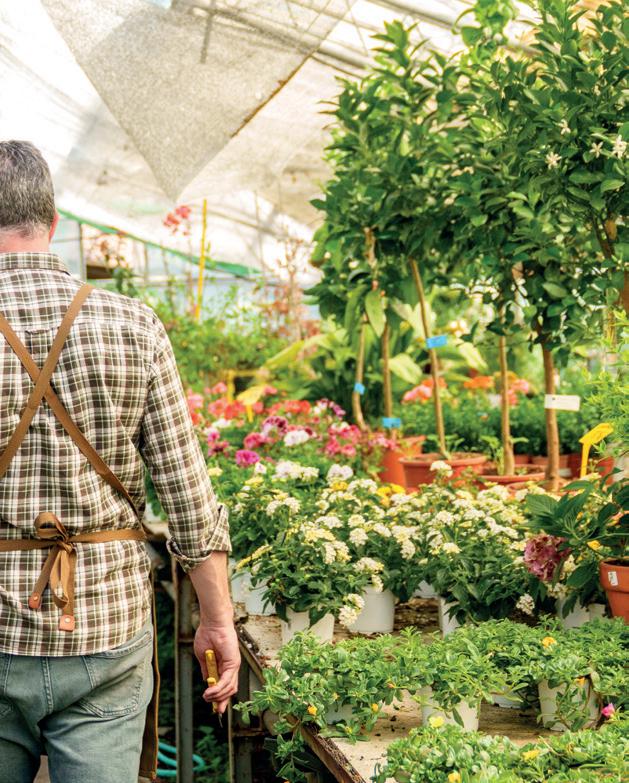
From Housework at The Sherborne to artists at the brewery, Dorset Art Weeks are packed with inspiration, exploration – and a boost to the economy
DORSET is not a big county, but as with its food and drink scene, it punches well above its weight in the visual arts world, with one of the country’s longest established and biggest art weeks.
This year will be the first full Dorset Art Weeks (DAW) event since 2018, before the pandemic. It will run from 25th May to 9th June, and sees the return of a programme of activities including workshops, talks, demonstrations, have-a-go and other events to excite and engage audiences.
There are 500 artists – painters, potters, textile artists, photographers, sculptors and other makers – exhibiting at more than 260 venues, from individual studios to grand historic buildings, creating a broad impression of the depth and wealth of talent working across Dorset.
The colourful brochure has details of all venues and participants, and maps of the six areas – North West (Venues 1-31), West (32-115), South (116-169), Purbeck (170-187), East (188-217) and North East (218-266).
One of the highlights of the 2024 DAW is the exhibition Housework at The Sherborne (Venue 1). The former Sherborne House is famous for the murals by Sir James Thornhill, the Dorset-born painter who was also responsible for large-scale schemes of murals, including the “Painted Hall” at the Royal Hospital, Greenwich, and paintings on the inside of the dome of St Paul’s Cathedral. The Georgian Grade I listed mansion has variously been a school, arts centre and, from 1851-60, the home of the great actor-manager William MacReady (1793-1873), arguably the greatest Shakespearean actor of the Victorian age, and one of Charles Dickens’s closest friends.
Housework, an installation with photography, textiles and painting, has been curated by artist Amanda Wallwork. It weaves together elements of the previous incarnations of the 18th century house and its new life as the home to an evolving programme of cultural activities. Artists featured in Housework include the late Dame Elisabeth Frink, as well as Jenni Cadman, Karen Hitchlock, Stig Evans, Jane Burden, Tim Burrough, Kirsten Cooke and Amanda Wallwork.

Residency at The Tap
Dorset Art Works’ headline sponsor is the Blandford-based family brewery Hall & Woodhouse, so it’s no surprise that the Brewery Tap (Venue 223) in the historic brewery building is housing an exciting DAW event. The brewery artists-in-residence exhibition will feature work by two artists, Charlotte Beare and Jack Dickson. The theme of their Dorset Visual Arts residency and commission is reflections on the life of the 250-year old company and its staff. Work created on site and back in the artists’ studios will be on show upstairs at the bar throughout the festival.
Other special events and exhibitions include The Instinct of Hope, artists responding to the climate emergency, at the Fine Foundation Gallery at Durlston Country Park (Venue 173), and The Ground Beneath Us, at the Top Floor Studio (Venue 58), The Old Timber Yard, West Bay, with participating artists responding to the theme of Extraction – Art on the Edge of the Abyss.
On Sunday 26th May, renowned furniture designer John Makepeace and his wife Jenny have an open day at Farrs, their beautiful house and garden in Beaminster. The house contains many examples of John’s work, including prototype designs, while the famous gardens include Jenny’s colourful potager and other features.
On Friday 31st May, six Dorset artists join forces to support the Nepalese charity, Right4Children – the evening will offer guests an intoxicating blend of art, philanthropy and feasting.
Kicking off with an exclusive drinks reception and viewing of the Dower House Studios at Winterborne Houghton (venue 230) exhibition, cocktails will be followed by a lecture from art historian Sarah Thomas. Guests will then be treated to a candle-lit dinner where they will have the opportunity to meet the founders of the charity and the Dower House Studios artists.
‘We are thrilled to host this special celebration in support of the invaluable work of Right4Children in Nepal,” says Jane Shaw, the owner of the studios, whose dynamic animal sculptures are beloved by collectors.
Launched by a letter John Makepeace has a special place in the history of Dorset Art Weeks. It might now be one of the country’s leading open studios events, but DAW began nearly 35 years ago with a letter from John to some influential people suggesting that an event in which artists opened their studios would not only benefit the artists but attract visitors to Dorset. At the time he was running his renowned college of furniture design at Parnham House, Beaminster, where he regularly hosted leading cultural figures, including Peter Hall and Norman Foster,

and recognised what a great impression Dorset made on them. There was a similar open studios event in Oxford, but the great university city was a very different proposition from rural Dorset! One of the recipients of the letter was the then county librarian and arts officer Carl Earl, who talked to the county’s new arts development officer Jo Morland. She contacted local artists who were unanimously enthusiastic –the result was the first Dorset Art Week (actually nine days) in May 1992. Since that first successful event, DAW has continued to grow, with more artists taking part every festival.
John Makepeace’s guess that it would attract visitors was proved

to be absolutely right – the lure of meeting artists in their own studios and workshops, often along picturesque lanes and in hidden valleys, the excitement of exploration and the pleasure of village pubs and shops have all contributed to the development of a biennial event that now brings more than £2 million to Dorset.
Dorset Art Weeks now runs under the auspices of Dorset Visual Arts, a registered charity with a membership of more than 300 artists, designers and makers who live and/or practise in Dorset.
DVA’s activities recognise that artists have different interests and needs in developing their careers, yet are often left to find their way in isolation, particularly in a mainly rural county.
DVA currently runs three project groups focused on professional development – The Interrogating, Salon and Emerging artist projects facilitate connections between artists with different areas of critical focus. The biennial Dorset Art Weeks is the flagship event, but there are now plans for a new ‘interval year’ event from 2025, as well as other activities such as residencies, workshops, networking meetings and get togethers.
• dorsetartweeks.co.uk
The Exchange is here for you – Why not become a Friend?
We receive no regular grants. We rely on income from ticket sales, room hire and donations to ensure the continued success of this remarkable North Dorset venue.
To support The Exchange, become a Friend for £50 a year (£4 a month) £90 or £7.50 a month for a couple.
To show our appreciation of your support as a Friend you will receive an on-line brochure a week before it is published to the general public and a newsletter between brochures to update you on coming events. We will be introducing Friends priority booking for most of our ticketed shows and events in the next few months.
To become a Friend see our website, www.stur-exchange.co.uk call 01258 475137 during box office hours or email info@stur-exchange.co.uk
You may of course donate more and take a special place among those who work to help The Exchange retain its place as the premier venue in North Dorset. Those donating more than £250 will be listed as Supporters of The Exchange and invited to an annual Supporters social event as well as enjoying all the benefits available to Friends.
Please consider leaving a legacy to The Exchange. One of the key contributions to fundraising for this building was an unexpected legacy from a resident whose generosity helped make this remarkable building possible. Even a small gesture will help secure our future.
Registered Charity no. 1108652


Our highly anticipated Real Ale, Cider and Gin festival is back, and celebrating its 11th anniversary after a short break in 2023. Once again, The Exchange will open its doors to showcase local breweries and entertain with live music.
Starting on the evening of Friday May 31st, a delicious and refreshing selection of ales and ciders from the likes of Hop Back, Gritchie, Tolchards, Cerne Abbas, Sixpenny and Hattie Brown’s Brewery will be on offer, to name just a few. If beer and cider aren't your thing, why not sample the Gin bar? With a variety of gins available, alongside freshly prepared garnishes, you’ll be sure to find something just to your liking!
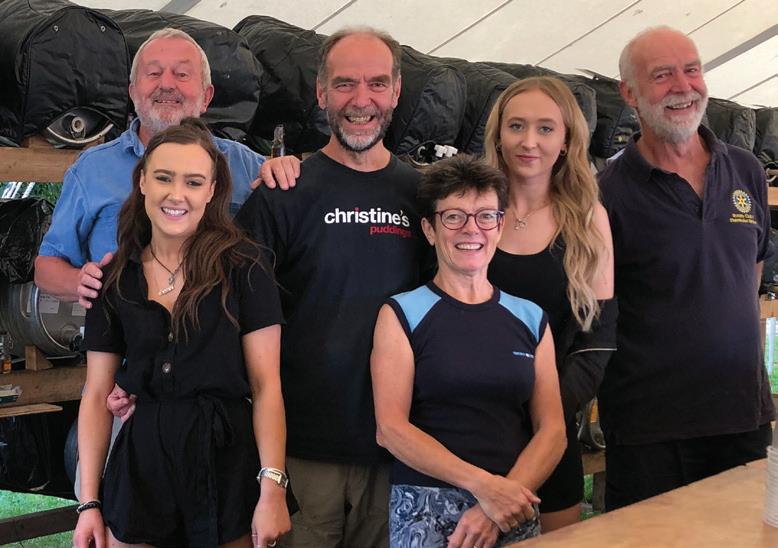

DOORS OPEN FRIDAY 7PM, SATURDAY & SUNDAY 12PM

Let’s not forget the music, an integral part of any festival. As ever The Exchange is passionate about supporting local musicians and our festival music selection is no different. The exciting line-up scheduled across the three days will be certain to make you want to get up and dance.


BIG LUNCH
Sunday’s festivities coincide with the annual BIG LUNCH organised by the Rotary and held next door in the Railway Gardens, making for a perfect family day out.
Lots to do around town as Sturminster's BIG WEEKEND is also taking place. See posters for more details.







The Exchange in Sturminster Newton is excited to be sharing in a new partnership with Artsreach, Dorset’s touring arts charity, and The Mowlem Theatre in Swanage.
Artsreach is well known for bringing high quality shows to village halls across Dorset, and some of those performers have reputations or shows that deserve and sometimes need bigger venues – The Exchange makes it possible for such shows to come to North Dorset. She’koyokh have been hugely popular performers for Artsreach in the past. They have toured the world, played famous European concert halls, selling out the Wigmore Hall in London in 2023, appearing at WOMAD and Glastonbury festivals and collaborating with The Scottish Symphony Orchestra and Aurora Orchestra.
Seven virtuoso musicians make up ‘Britains Best klezmer & Balkan music band’ (The Evening Standard). They are returning to Dorset to play the Mowlem Theatre and The Exchange, where they will be playing on
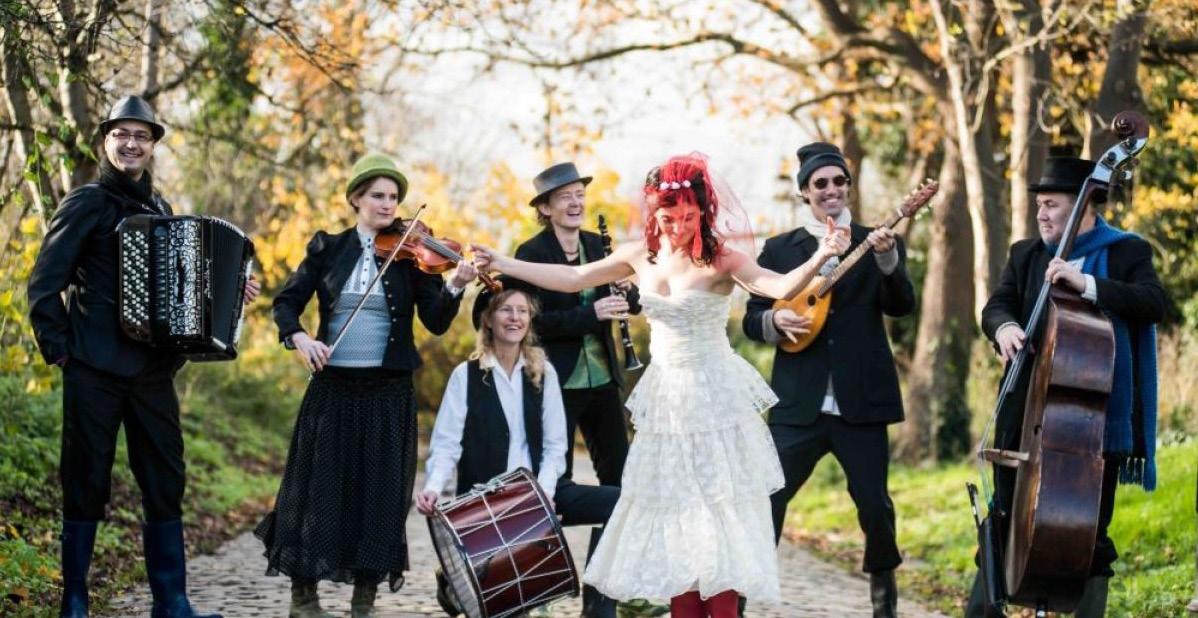
26th May. With a sumptuous mix of instruments, and vocals from acclaimed Istanbul-born Cigdem Aslan, expect a night of exhilarating, invigorating music.
Workshop opportunity
She’Koyokh are also offering a dance workshop led by members of the band, with live music, from 4 til 6pm, before the concert. This will include Balkan and Yiddish circle dances, as well as a few set dances. All ages and levels welcome, no partner required – booking is essential.
On 26th May, one of ‘the finest and most entertaining British-
based exponents of global music’ will be in Sturminster Newton for one night. See The Exchange website or call 01258 475317 to book tickets.
• Artsreach workshops for children regularly sell out at The Exchange in the summer months, and the wonderful annual celebration of Sturminster’s William Barnes, involving local musicians, singers and readers, is making its home at The Exchange – another example of the partnership working between Artsreach and The Exchange.
Three authors will be at Sturminster Newton Literary Festival this year as part of their national book tours, firmly putting the town on the LitFest map. Bridport prize winner Fiona Williams set her novel in the Somerset Levels, with exquisite descriptions of the familiar countryside of the south west. Col Guy Deacon CBE discusses his remarkable journey through Africa while living with the effects of Parkinson’s Disease. The organisers have also managed to arrange a session with Elizabeth Delo, winner of the British Debut Novel at the
37th Festival du Premier Roman, in Chambéry.
Her novel, Becoming Liz Taylor, tells the story of a widow who spends her evenings dressed as the famous actress.
The festival also, as always, celebrates the literature that has its roots in and around Sturminster Newton.
Kevin J Davies will be speaking about the late Douglas Adams, who wrote much of the Hitchhiker’s Guide to the Galaxy in nearby Stalbridge.
A special showing of the 2009 edition of Far From the Madding Crowd made by Gryphon School

students – and filmed entirely in Dorset – includes an opportunity to meet some of the actors and celebrate the 150th anniversary of the book being published. As part of the D -Day 80 commemorations, an exhibition of local testimonies will be on show at The Exchange.
• For the full programme and tickets, visit sturlitfest.com or 1855, Sturminster Newton.


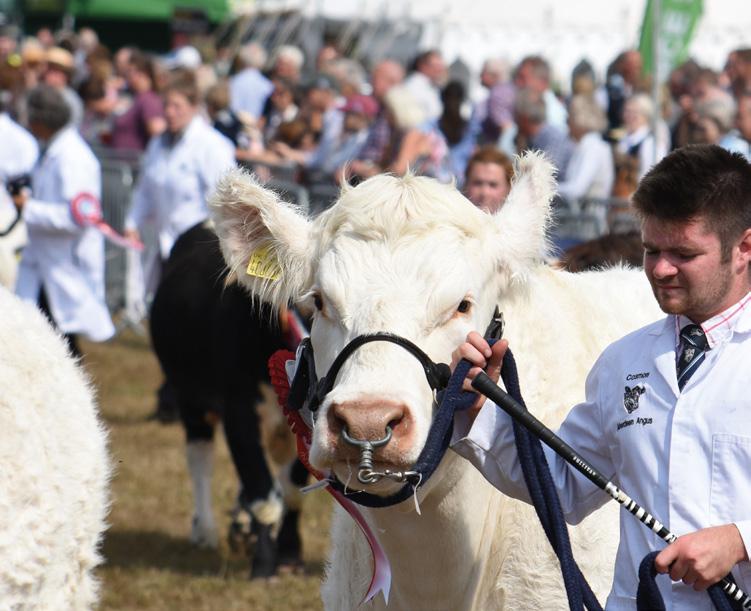






















Tindall Recital Hall, Music School, Sherborne School Thursday 6th June 2024, 7.30pm Tickets £12.50 (to include a glass of wine) Scan the QR code to book now or email: tickets@sherborne.org Programme




Join Dorset’s famous folk duo, exploring ancient hillforts and coastal paths in their newly released walking guidebook of ten trails
Regular readers of The BV will know that editor Laura and husband Courtenay Hitchcock are keen walkers, sharing some of their routes – and stunning photographs – in the magazine. But for those who would like even more of Dorset’s dramatic and inspiring landscape, there is a new collection of walks from Dorset’s much-loved folk duo Ninebarrow – James LaBouchardiere and Jon Whitley. For some years, the duo, renowned for their beautiful harmonies and charming original songs, have been leading walks and writing books to introduce their fans and fellow walkers to different areas of their home county, which inspires so much of their music – they even took their name from the Purbeck landmark Nine Barrow Down.
Their third volume of Ninebarrow’s Dorset Walking Book contains ten routes in some of Dorset’s most spectacular and exciting scenery – the Purbeck coast, North Dorset’s ancient hillforts and the mysterious landscape of Cranborne Chase where you can find traces of human activity that date back many millennia.
The muse is the wild It is some years now since Jon and Jay gave up their day jobs (Jon was a teacher and Jay was a GP) to become full time musicians. That decision has paid off, with a string of critically acclaimed albums – the most recent is their fifth, The Colour of Night – as well as two books of walks, and a sideline in organising musical walking holidays, which combine three days of walking with fine food and evening concerts. Walking is an essential part of their lives: “The outdoors is our muse,” says Jon. “For Jay and I, walking is a creative experience. We never feel more creative than when we’re out hiking.” There is certainly plenty to inspire your imagination in this latest collection of walks, which are graded from easy to moderate to challenging to hard, and are mostly around five to six miles. The ten routes are: Hambledon Hill and Hod Hill; Badbury Rings; Martin Down; Ballard Down; Ringstead and White Nothe; Lulworth Cove and Mupe Bay; Lyscombe Bottom; Duncliffe Hill; Cerne Abbas; and Tynehgam and Kimmeridge.
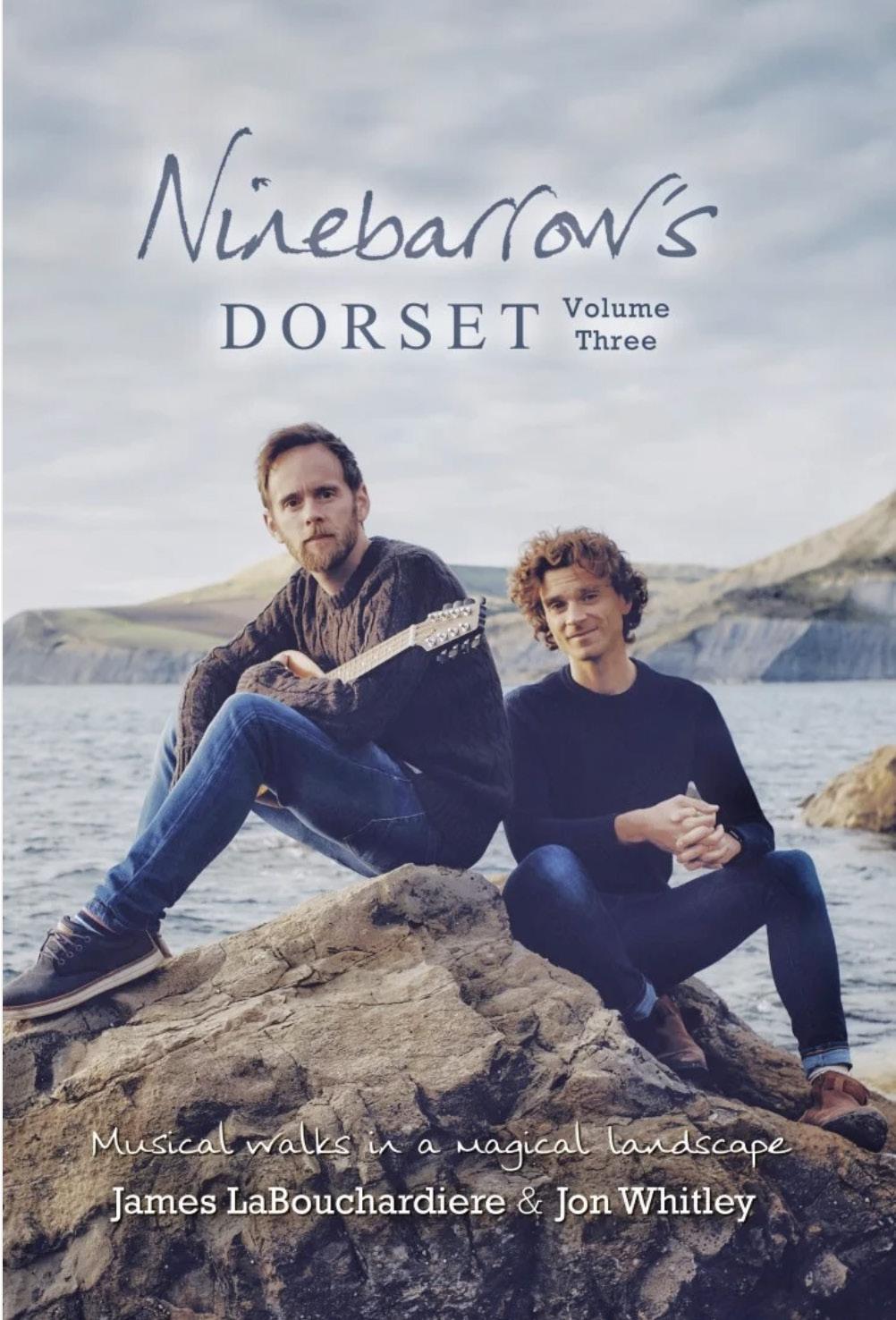
The walks are well-researched and described, both in words and in beautiful photographs. There are clear maps and directions, and essential advice on the basic facts such as availability of loos, where to leave your car and where you can find refreshment on or after your walk. There are also handwritten side-bars giving additional information on such features as medieval lynchets, Iron Age hill-forts, the origin of place names or what you can see from a particular high-point. The book is a handy size that fits in a pocket or backpack and has a sensible, strong plastic cover. It all adds up to a very useful addition to the walking library of anyone who loves Dorset – and if you don’t already know it, it should also encourage you to listen to Ninebarrow’s music.
• Ninebarrow’s Dorset Walking Book - Vol.3 is available to pre-order now from their shop: ninebarrow.co.uk
Thursday 23rd May
7.00pm, Tindall Recital Hall, Sherborne School
Scan the QR code to book or email tickets@sherborne.org FREE ADMISSION BOOKING ADVISABLE



Tickets £15.00 Proceeds to Julia’s House Children’s Hospice
To include 2-course supper, bar and raffle Teams of 6 or we can match you up! Available from: serocharity@gmail.com Julie Little 07749 486733, Kate Partridge 07725 245066

Thursday 16th May 2024
Tindall Recital Hall, Music School, Sherborne School


Two of Sherborne School’s exceptional piano teachers join forces for an exciting programme of two -piano music, featuring Rachmaninoff’s popular Symphonic Dances.
7.30pm (doors open 7.15pm)
Tickets £12.50
(to include a glass of wine)
Scan the QR code to book now or email: tickets@sherborne.org




This month’s news from the unofficial capital of the Blackmore Vale...
Pauline Batstone shares her monthly round up of what’s happening among the town’s collection of community enterprises and events
Well, what a quick month April was – I can’t quite believe that it’s May already! Below you can find just a little taster of some of the things happening in Stur throughout the (hopefully!) sunny month of May and into June. First up, the Car and Bike Enthusiasts are back in the Station Road Car Park on the morning of the 4th May 9am to 12 noon. Unfortunately the Recreation Ground is still far too wet for them to drive on. But to make things easier there will be free parking in both town car parks all that day, courtesy of SturAction’s donors and customers.
When you have finished admiring the cars, why not come along to 1855, where the traders will be happy to great you and offer some tasters – there are almost 100 different small artisan and craft business under one roof!
On the morning of Sunday 5th May, the car park behind The Exchange will see the return of the Stur Car Boot Sale, come and have a rummage and help raise much-needed funds for charity.


On Bank Holiday Monday, 6th May, the Emporium and The Boutique in town will both be open from 10am to 2pm for anyone wanting a gentle holiday browse – and perhaps a purchase or two!
Both The Exchange and the Sturminster Newton Literary Festival have their new brochures out this week, so pick up your copies from various outlets around the town. Tickets for the LitFest are available online here, and can also be purchased from 1855. The event is not to be missed, with the opportunity to listen to a collection of authors covering a wide range of styles and subjects.
On Thursday 6th June, the 80th anniversary of D Day, at 7.30pm there will be a civic service followed by the lighting of the beacon in the Railway Gardens as dusk arrives.
As part of this commemoration, Sturminster Newton Literary Festival is devoting the 9th of June to military history, including talks and the opening of a special D-Day testimony exhibition at The Exchange.


Want to reply? Read something you feel needs commenting on? Our postbag is open! Please send emails to letters@BVmagazine.co.uk.
When writing, please include your full name and address; we will not print this, but do require it.
On the dead lamb
Should the farmer have displayed the lamb carcas? Yes. The dog’s owner should see the damage they have done, and other irresponsible owners should see what could happen. Not that we see the suffering or mental state of the ewe, or the other sheep in the field. Why protect people from the hurt they inflict on animals and the farmers? There is nothing that melts your heart more on a spring day than the baby lambs skipping, feeding and playing in in the green grass among the spring flowers. It spells out new hope, new life and gives your spirit a lift. Shirley C, by email
I’m writing this with a fair share of frustration. As a shepherd who has faced similar ordeals with sheep worrying here in Dorset, I understand all too well the toll it takes—not just financially, but emotionally as well. Our sheep aren’t just business assets; they’re creatures we nurture and care for. The recent incidents of dogs attacking livestock highlight a dire need for greater awareness and stricter controls. We must protect our livelihood but also the animal’s welfare.
Name and address supplied
I recently visited your beautiful region (and happened across your publication via a local Facebook group. I am thoroughly impressed with the quality, and wish we had something similar in Kent). However, it was disheartening to read about the sheep worrying incidents. In a rural area where animal welfare is clearly highly prioritised, it surprises me to see such issues still rampant. While I understand that dogs will be dogs, the responsibility ultimately lies
with the owners. It’s crucial for the community to foster a culture of accountability to prevent such distressing events. Well-being of all animals should be a collective concern. Well done to the farmer in question.
George Kittle, DymchurchI am writing to express my concern over the recent reported cases of sheep worrying by dogs. It’s incredible that such incidents STILL occur, despite ongoing discussions about animal control and responsibility. I believe more can be done to enforce leash laws and to educate dog owners about the consequences of negligence. We need to ensure our local laws are upheld not just for the safety of our livestock but for the safety of all other dogs and people using our footpaths and trailways.
Ginny Barker, Blandford
On youth and gender identity
The recent findings and decisions around gender identity treatments for minors, notably the NHS’s stance on puberty blockers, raise crucial points about medical interventions on young people. As highlighted by Chris Loder in the April BV, the increasing number of Dorset children referred to Gender Identity Clinics signals a need for us to tread thoughtfully in these sensitive areas. While it is imperative to support and respect every individual’s journey, including the struggles of those dealing with gender dysphoria, the Cass report rightly insists on rigorous, evidencebased approaches when it comes to medical treatments, especially those as deeply consequential as hormonal interventions. The ban on puberty blockers, pending more conclusive research on their
safety and efficacy, is a prudent step.
It is essential that we maintain a balanced perspective. We must provide robust psychological support and ensure that any medical treatment offered is backed by unassailable scientific evidence and is in the best interest of the children affected. We owe it to our future generations to prioritise their long-term health and well-being over immediate, irreversible decisions.
Anna Sealy, Verwood
On postcards from Thornford (comments all from the busy discussion full of Thornford memories on Facebook): I’ve just left Thornford for 10 miles up the road, after the family have been there for well over 100 years – I was fourth generation there. That traction engine was cut up and buried years ago at Gabes the Blacksmiths. My parents are both almost 90 and remember growing up there during the war and after.
Ian Morgan
Often walked to Thornford to go in Ellwood’s Stores, the old Mrs. Ellwood would be sat at the back of the store with her white hair up in a bun, and took time to speak to all her customers. We had a white cat from someone at Thornford, Mr. Chesterman was the vicar, Mr & Mrs. Dare ran the National garage then. We moved to Yeovil in 1970.
Margaret Rowe
My aunt Lilian Clarke lived next to, or rear of, the chapel and her husband, my uncle, was a blacksmith and ran Gabes. Spent many happy times there –everybody knew everybody then.
David White

Pride Month is an important celebration for the LGBTQ+ community. LGBTQ stands for Lesbian, Gay, Bi-Sexual, Transgender and Queer, with the + added to include other non-traditional identities. Each year, on Saturday 1st June, Pride Month begins all over the world. The focus is for people and their friends, families and allies to
Dorset Pride events:
• Sherborne Pride sherbornepride.org 7th June
• Poole Pride lighthousepoole.co.uk 8th June
• Bourne Free bournefree.co.uk 5th and 6th July
• Dorset Youth Pride shirehalldorset.org 13th July
Employ My Ability offers vocational training for students with learning disabilities and special educational needs and disabilities. One of their students, Maddie Walters, spent her work experience with us, and now writes a regular column - Ed
celebrate, honour and support the LGBTQ+ community.
The iconic Rainbow Flag is often used in parades and was created by Gilbert Baker in 1978. The flag is usually seen with six colored stripes, each imbued with meaning: red for life, orange for healing, yellow for sunlight, green for nature, blue for serenity, and violet for spirit.
Apart from the Rainbow Flag there a number of other flags that are used to celebrate Pride Month. The Pink Union Jack Pride Flag was created by UK artist David Gwinnutt in 2005, as something “both gay and British!” There is also a Progress Pride flag, created in 2018 by Daniel Quasar to celebrate the diversity of the LGBTQ+ community, that hangs in the V&A Museum. If big marches and parades are not your thing, you could always


have a Pride celebration at home! Have your own dance party in the living room – find a good LGBTQ+ mix on Spotify and maybe bake a rainbow layer cake.
If you need help to explain Pride Month, Strong Family Alliance has some excellent age-appropriate suggestions for sharing Pride with younger (or older!) people. Happy Pride Month everyone!


Crossword
Simply click to complete on your tablet, computer or phone - or there’s a download ‘PDF’ option if you prefer pen and paper.

Jigsaw It had to be bluebells, didn’t it? – just click to complete!
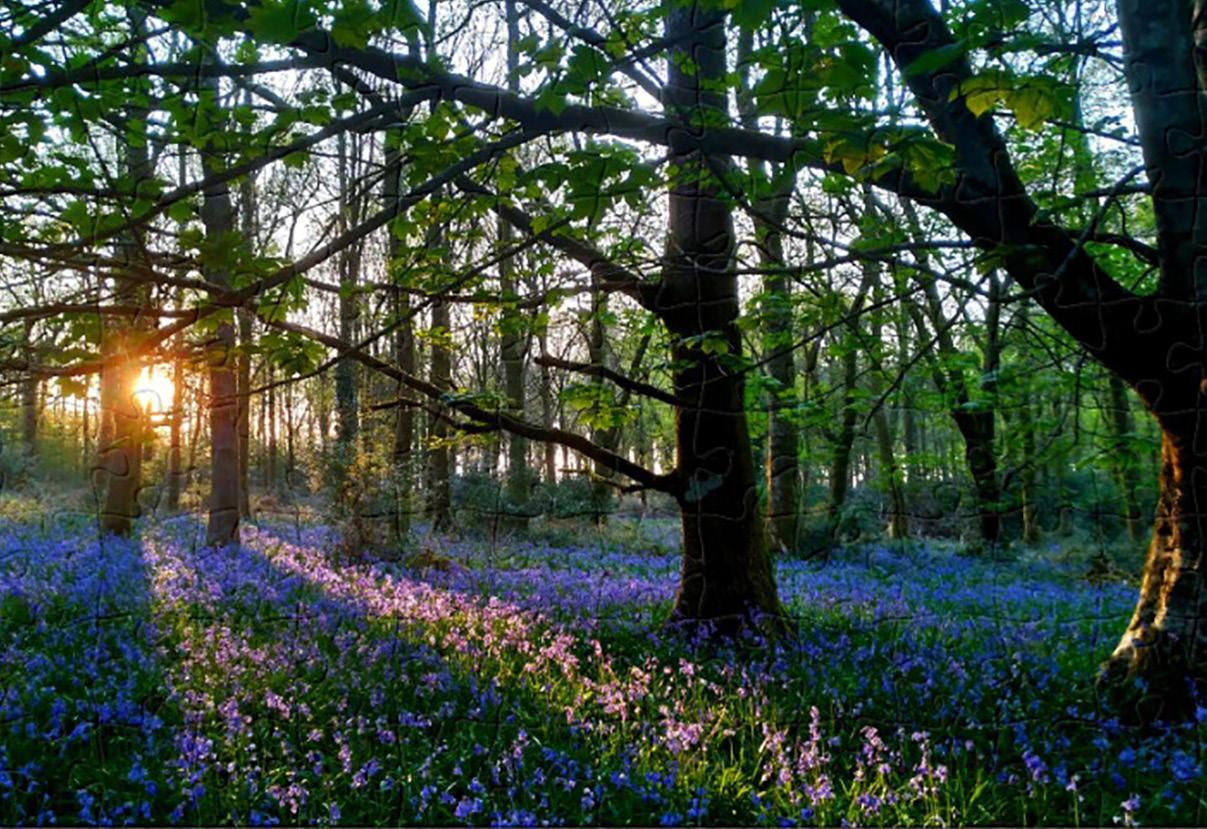

While on the surface, Lucy Rose sits comfortably in the English female folk singer category, her music has always had something extra.
From the first 20 seconds of Red Face (the shape-shifting opening track from her 2012 debut LP Like I Used To) the inventive dynamism which sets Rose apart from her contemporaries is clear.
Following a burst of creativity between 2012 and 2019, Rose took a lengthy hiatus for the birth of her first child (who features on the track Interlude II), and then to recover from resulting health issues so serious that she was unable to walk or breathe without severe pain (let alone sit at a piano) for many months.
It would therefore have been understandable if Rose’s return was a little on the sombre side –she has had plenty to reflect on, after all. But the album Rose and producer Kwes crafted following these momentous life events (and then recorded in a mere two days) is full of life, and Lucy’s boldest effort to date.
While those recent experiences have clearly shaped the work, they never weigh it down.
On Could You Help Me, Rose asks ‘Could you fit me in your busy day?’ before declaring ‘Now I’m learning how terribly lonely illness is’. But there is a lightness of touch, a deftness in the arrangement of the track, so that it practically skips through its sub-three minute arrangement. While there is introspection and beauty to be found here, the most rewarding moments on



the album are the regular forays into jazz, triphop and chamber pop. Rose has expanded her palette in such an organic manner that it feels like the most honest presentation of her true musical spirit to date.
By the time closing track The Racket has reached it’s free-form, heavy-grooving crescendo, it’s clear that Rose and her band of regular collaborators are now reaching the height of their powers. Long may they continue.

• Matthew Ambrose presents Under The Radar on Tuesday evening at 7pm on Abbey104. Broadcasting on 104.7FM and online at abbey104.com.


Whatever mental image the name Squat-thrust.com raises, it probably isn’t a men’s keep fit group in Sherborne. But Squat-thrust.com is celebrating its 50th birthday this year ... and many of the members have been involved for almost the entire time the club has been running. The average age of the membership is 73, and they are still going (very) strong, still performing just as they did all those years ago. Admittedly there may be a measure of rosetinted glasses there ... Squat-thrust.com meet every Thursday night at the Gryphon School in Sherborne for a warmup and stretches and an hour of circuit training, followed by an hour of volleyball as a cool down – although it can get a bit competitive. The group finishes up with an hour (or two) of ‘rehydration’ at the Digby Tap! The group was initially set up by Alan Fall, head of PE at the old St. Aldhelm’s School, and it began simply as a way for friends and colleagues to keep fit. It was then adopted by the local council as an adult education course, and taken
over by the Head of PE at the Gryphon school, Allan Martin, who still runs the group’s evening sessions today.
A few years ago it ceased to be a local authority course –threatened with closure, the members refused to lose their club, instead getting together and starting to run the evening classes themselves.
In addition to the central Thursday night training which helps to keep the members fit and moving, there have been various spin-off activities – a badminton group, a golfing association – and various social events such as meals, walks and curry nights all based around the Squat-thrust. com-ers membership. It was on a group walking weekend on Dartmoor that the rather unusual name for the group was chosen (a squat-thrust is one of the exercises they do, in case you were wondering). It is ruefully acknowledged that being sat in the pub at the time of the discussion may have had something to do with the choice.
The evening’s physical activities are always based around what each person feels capable of doing – although Allan very much encourages maximum effort and total commitment!
Join the gang
Squat-thrust.com are always happy to welcome new members – they get particularly excited if it drops their average age a bit. People in their 50s and 60s and even younger are very welcome – it is requested that they just don’t show up the older members too much.
Having said that, a son of one member came to a session and was mightily impressed by the standard, especially when he realised he couldn’t keep up with some of them!
The group would be thrilled if Squat-thrust.com can keep going for another 50 years – and although perhaps not all the current membership will make that, they certainly intend to still be going in the 2030s ... just a little less vigorously, perhaps.
• Dick Bennett - 01935 474306 dicklynnebennett@gmail.com
Anyone walking past St Mary’s church, Motcombe on the evening of 13th April would have been treated to the sound of All In The April Evening drifting through the warm spring air as the Gillingham Singers began their Spring Concert. Inside the church, the audience were treated to a wonderful mix of music from modern British composers, ranging from John Rutter’s The Sprig of Thyme and a collection of folk songs, through to Thomas Tallis’ If Ye Love Me from the mid-1500s. The concert concluding with This is Home by Sophia Efthimiou, which came to public attention during the Covid lock-down. This is the first concert Gillingham Singers have sung

with their new musical director, Richard Nye, with David Grierson providing the accompaniment. The audience enjoyed other works including Taverner’s The Lamb, where the choir came out from their positions to surround the listeners with a true 360º sound, a selection of songs from Cecila McDowall’s A Fancy of
Folksongs and Bob Chilcott’s The Lily and the Rose. This is Home was then sung as an encore, giving the audience a chance to join in the emotive musical item with sign language, voice or both. A delightful evening for all who attended! by Mike Turnbull
• gillinghamsingers.org
Throughout Dorset people having been diving into an imaginative world of 1,000 years ago for The Shaftesbury Tales Short Story Writing Competition.
SISATA Director Charmaine K, who sat on the judging panel, said: ‘We were blown away by the high quality and amazing variety of stories submitted.’
The eight winners – all in equal first place! – are:
• Under 11 years:
Ferocious F by Giulia Rose Ceccolini, and Kenrics Tale by Jacob Wall
• 11 to 16 years:
The Tale of the Doctors Daughter by Coco Bichard, and The Brothers Tale by Betsy Wragg
• 16 to 25 years:
The Peasants Tale by Lyra Spencer, and ‘The Daggers Tale by Juno-Blake Cree
• Over 25s:
The Traitors Tale by Stuart Edwards, and Ælfthryth’s Tale by Anne Philpott
The winners will all enjoy a cash prize and also see their story published in our bookletprogramme – and their Tale might get adapted for the stage! Inspired by Chaucer, The Shaftesbury Tales is a collection of stories – both written and performed.
Travelling players in Dorset
Performers from Treehouse Theatre will be walking from Corfe Castle to Shaftesbury in July, travelling from village to village, teaming up with local theatre groups and school children to perform hilarious and interactive community shows along the way.
Treehouse Theatre will now be working with local theatre groups to adapt some of the winning and highly commended stories for performance. Sturminster Newton Amateur Dramatic Society (SNADS), Double Act Theatre Group from Corfe
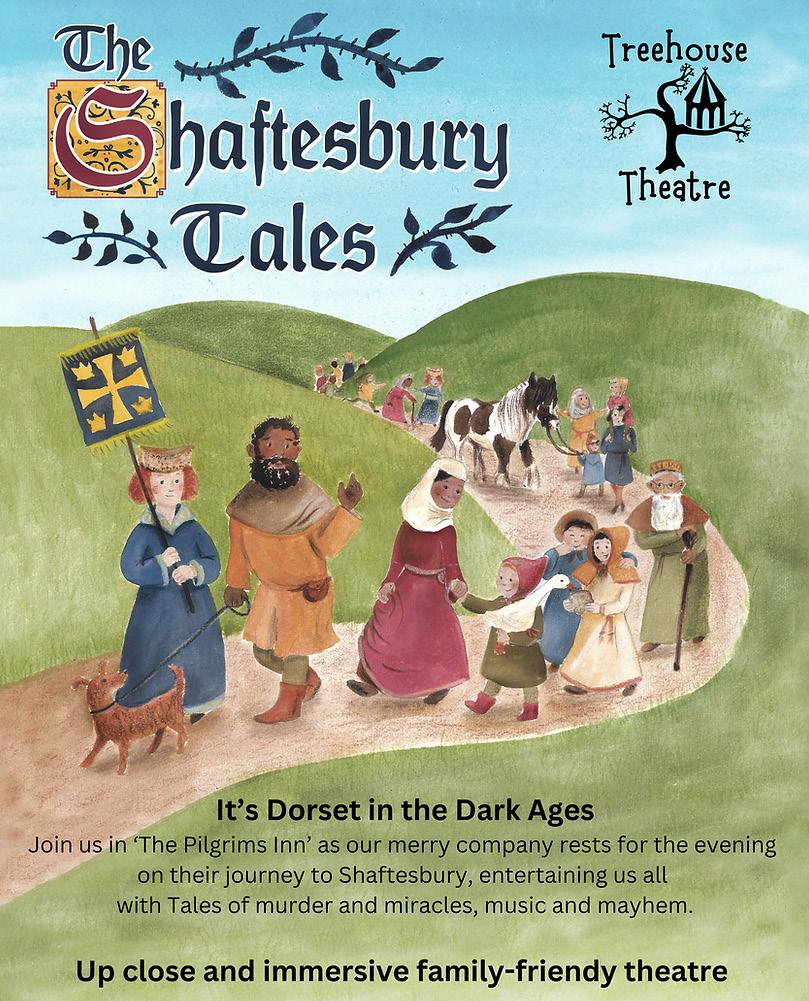
Castle, and Remix the Originals will all be creating scenes in the production. Director Ben LindseyClark said: ‘If you’ve always thought about joining a local theatre group, now could be a good moment!’
For details on where to see the show in July, how to get involved in the project, and read the winning stories, see treehousetheatre.com
Almost 150 runners participated in the first Easter Fun Run organised by Shaftesbury Rotary Club, raising The event raised more than £800. With 5km and 10km versions of the race on offer, runners took part to raise funds for local charities, including the Stars Appeal at Salisbury Hospital. The weather stayed dry ( a rare occurrence this spring!) and Virginia Edwyn-Jones, the Mayor of Shaftesbury, was helped to strat the races by Easter Bunny RotaKids – Marley from Abbey Primary and Charlotte from Shaftesbury Primary.
Local charity HOPE was on hand to supply refreshments, and runners from as far as Weymouth and Eastbourne joined the locals; some raced with friends, some with their parents/ guardians and some just took their dogs on the circuit around the town.
RotaKids from Abbey Primary and Shaftesbury Primary provided water and Jelly Babies at the halfway point, and the Mayor and the RotaKid
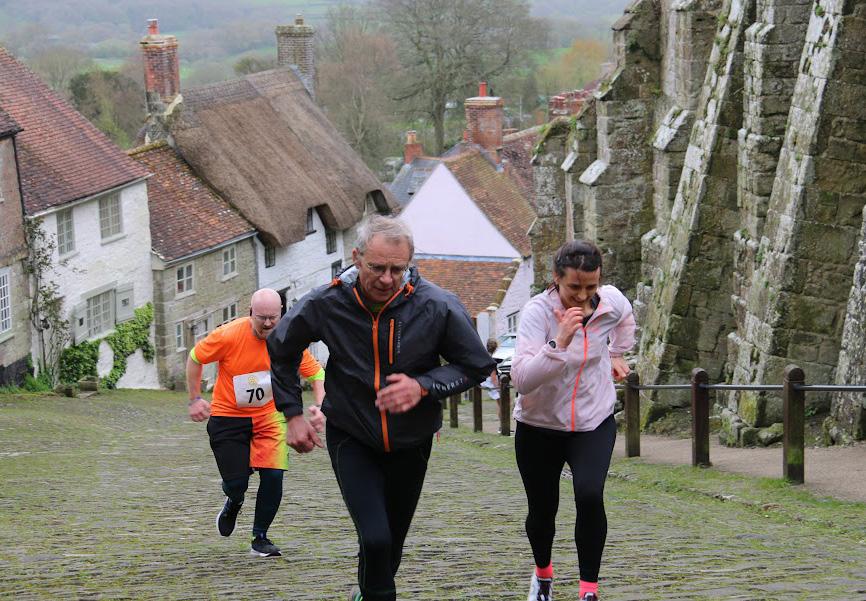
Easter Bunnies were on hand at the finish line at the top of Gold Hill to award runners with their medals. Shaftesbury Rotary Club strongly hopes that the run will become an annual event. If you want to know more or to get involved with Rotary, please contact: hello@shaftesburyrotaryclub.org
On Saturday, 27th April, Salisbury Hospice Charity’s annual Midnight Walk took place at Five Rivers Leisure Centre, with almost 350 participants who braved the night in a heartfelt effort to support end-of-life care. Every walker, marshal and volunteer was dressed in vibrant neon outfits, and participants chose between the 6 or 10-mile routes through Salisbury. The event kicked off with an energetic warm-up led by Beth Whitworth on stage, with DJ Kev accompanying from Radio Odstock.
The Countess of Pembroke, Charity Patron, and Nikki Spicer, Chair of Trustees, both gave warm speeches before the communal countdown, “Three, two, one - Glow!” sent the walkers on their way amid cheers from volunteers and residents.
Despite seriously challenging weather, the walkers spirits remained high, boosted by cheering residents along the route and entertainment from the stars of Circus Wessex and Jonathan Jester.
At Salisbury Cathedral’s west door, walkers were invited to light a candle in memory of a loved one, and to write a personal message in a dedicated memory book. Many participants also opted to display on their t-shirt their reason for walking, with memories of a beloved individual or some of the wonderful hospice staff.
With torrential and relentless rain, the walkers returned drenched but smiling, filled with a strong sense of accomplishment and determination to support Salisbury Hospice. At the finish line, walkers had the opportunity to pass through a unique Midnight Walk colour-changing arch, a special creation by Ozweld International. Each walker

received a packet of Forget Me Not seeds as a living medal to plant in memory of their loved ones.
Warm drinks and bacon baps from The Wood Bar awaited, along with optional foot massages from complementary therapists.
Despite the terrible weather, the event was a huge success, raising an astonishing £42,000.
Greig Futcher, Events Fundraiser, said: ‘I am completely overwhelmed. The weather wasn’t at its best, but even after walkers had been out on the course for several hours in the wet and cold, they crossed the finish line with huge smiles on their faces! I must send a huge thank you to all the volunteers – and most importantly, every walker who pounded the streets.’
Salisbury Hospice Charity would like to thank all the participants, volunteers, and support we have received to put on this ‘glow’tastic event. A special thank you goes to sponsor Webbed Feet.
During April, Sherborne hosted the 48th General Meeting of Douzelage with 140 members from 24 partner towns gathering under the theme Wellbeing Through Nature and Music. The event featured a rich programme of music and nature excursions, providing attendees with a showcase of local talent, including musicians and dancers. The event was started with a welcome reception at the Boys’ School Big School Room, where Mayor Cllr Margaret Crossman and other dignitaries, including local MP Chris Loder, greeted guests. Entertainment included performances by local pianist Andrew Priest, The Blackrock Dancers, and the Sherborne Town Band.
Friday’s general meeting was enjoyed by all – translation equipment helped with 24 different languages. Discussions covered the organisation’s operations, past and future projects, and culminated in the election of a new president. Mrs. Annigje Kruytbosch-Luns from the Netherlands, who had led Douzelage for eight years, ably assisted by three vice-presidents, Mette Sorensen from Denmark, Tibi Rotaru from Romania and Miha Ješe from Slovenia. Annigje’s husband Alexandre Luns has looked after the Douzelage.eu website and taken

minutes at General Meetings. Together they travelled Europe planning and co-ordinating many events. Annigje was succeeded by Shane Smith from Ireland. The newly elected team also includes vice-presidents Maria Rocco from Rovingo, Croatia, Evelin Koev from Skofja Loka, Bulgaria, and Thorsten Wohleser from Judenberg, Austria.
Musical exchange
Following the general meeting a concert was held in Cheap Street Church, where students from Leweston School performed, followed by the prestigious Sherborne Chamber Choir.
A highlight of the event was the Ad Hoc Orchestra, under the direction of Dr Rachel Milestone,
This year the global theme for Earth Day was Planet vs. Plastic – or as one school likes to call it, Milborne vs. Plastic. Milborne St Andrew First School built their own recycling centre at school and asked families to collect all of their plastic recycling and bring it in! Children then sorted
it through and, using their Recycling Calculator, worked out just how much plastic the school’s families will be using throughout the year.
A huge well done also goes ot the children for running 438 miles for Miles for Mosaic. Almost £200 was raised by the little school with a big heart.
Director of Music at Leweston School. The DouzYouth students had been asked to bring their own instruments – they had just one rehearsal and performed five pieces on the last night, much to the delight of the audience. The event closed with performances by the Wessex Morris Men, who encouraged audience participation, providing a fitting end to the conference.
Founded in 1991 by Jeremy Barker, Andre Poirier, and Henri Haffray from Granville, and since that time many students and members have exchanged visits and shared cultures. Lasting friendships have been made, and Douzelage continues to foster international cooperation and cultural exchange.

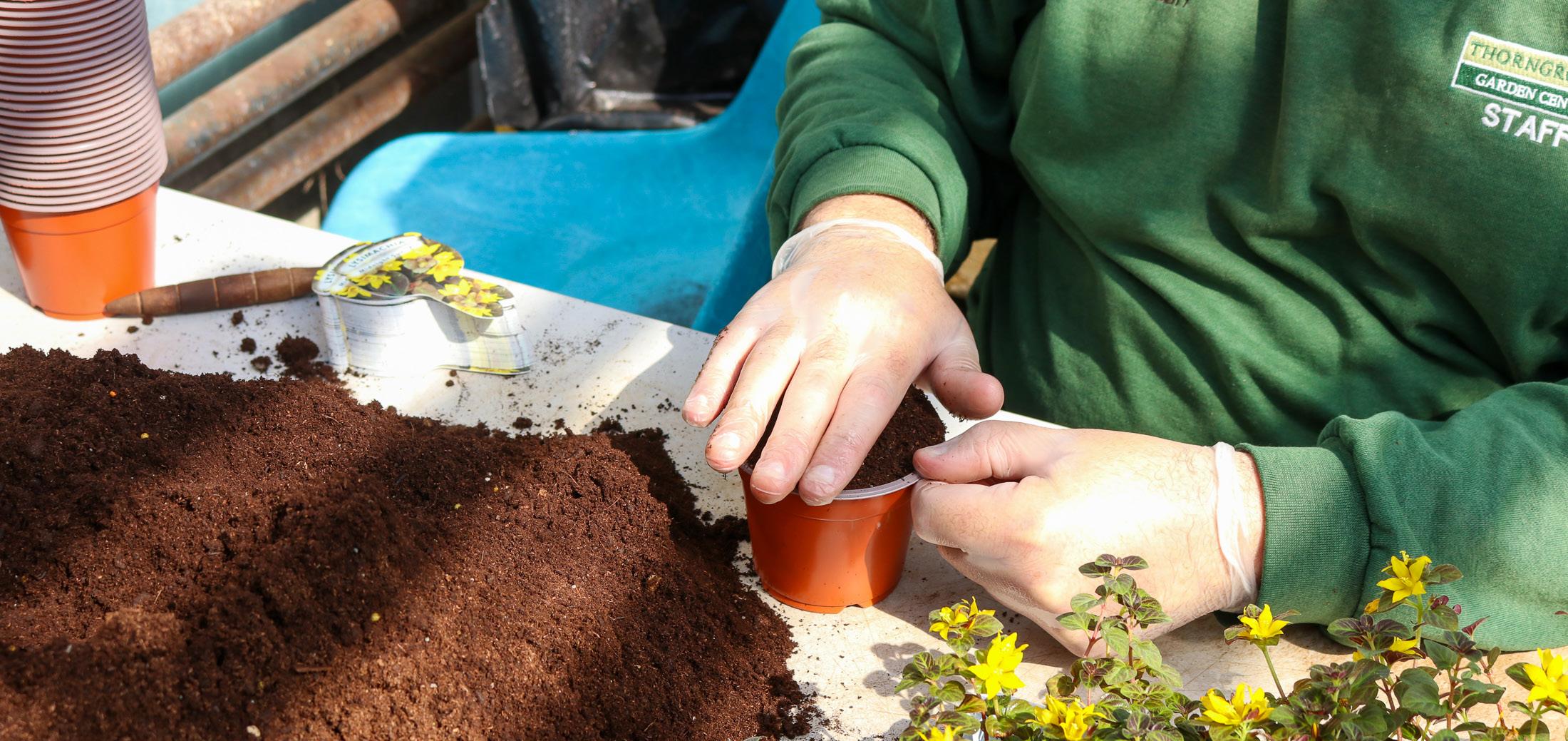
There is an air of new season excitement at Thorngrove this month. You can’t keep a good gardener down, no matter how much rain comes their way
We could hardly believe it last week when the spring sunshine was actually making itself known for more than five minutes at a time! Better late than never though, as the saying goes! This time of year tends to see a few more customers through our doors – as the weather warms up, many of us start to take advantage of our garden spaces. When those bursts of inspiration hit we tend to look to fill any gaps with some vibrant interest. The garden centre courtyard is always bursting with colour and life and a whole range of options to fit any size space – it won’t be long before the roses are making themselves known, so do stop by and see what there is to discover here at Thorngrove (don’t forget
while you’re there to visit the glasshouse too!).
The garden campus Regular visitors to Thorngrove will know that our garden centre also functions as a campus for young people with special educational needs and disabilities. It’s a place for education and work experience, and also an adult social care day service. Students are often completing community projects and fundraising, and in April we were finally able to present Krystina from Gillingham Youth Project Hipp!!Bones a cheque for £200. The money was raised through the Winter Wonderland event we held last December. Hipp!!Bones is a youth club

utilised by some of our own students, and they felt very proud too have been able to give something back to the project which is so important in our community.
The Gillingham campus continues to develop, and earlier this year we released a little ‘day in the life’ short video about what it’s like to work and study at Thorngrove, with some insight from staff and students - you can watch it below!
The garden centre and café act as real-world environments for the students to hone their life and work skills. So the next time you visit Thorngrove, feel free to ask for a prospectus if you, or somebody you know, might benefit from the way we can help young people develop their skills, confidence, and independence.
You may have just missed our most recent open day, but we offer guided tours and even taster sessions all year round. We understand that every individual is different, and we tailor timetables to suit specific needs. If you’re looking to take that next step in finding the future for a young person in your family or care, please do reach out. We’d love to chat.
Around 12 months ago my little girl Edith was diagnosed with a rare genetic condition called Rett syndrome. To say that this was devastating would of course be a massive understatement. Her diagnosis completely changed our world and means that she will now have a remarkably different future than what we had anticipated.
- Matt Billingsley, Dad to Edith

Rett syndrome is caused by the spontaneous mutation of a gene on the X chromosome. Babies are born apparantly healthy but begin to deteriorate before their second birthday, losing their speech, mobility and use of their hands. There is no cure but there is hope. Rett syndrome has already been reversed in the lab.
Sponsor my Couch to 100km - Jurassic Coast 2024 challenge using the QR code and help raise vitals funds for Rett research.

Facebook, Twitter and instagram under ‘Reverse Rett’

A local expert from Citizen’s Advice provides timely tips on consumer issues. In the postbag this month:
How do I protect my holiday?


Q:‘We’re booking a summer holiday to Spain... What can we do to protect ourselves and prepare for the unexpected?’
A:There’s a lot you can do in advance to help your holiday go smoothly, including getting travel insurance and brushing up on your rights if something should go wrong.
The first thing to do when planning a holiday is to check if your passport is in date. Renewals can take several weeks, so don’t leave this until the last minute! You can check the validity of your passport for your country of choice on Gov.uk – and this is especially important if you’re flying to Europe. EU countries no longer accept passports that are more than ten years old – if your passport was issued pre-Brexit then the expiry date might well be more than ten years from the issue date. If it’s older than ten years, you’ll need to get it renewed for EU travel – even if it’s technically still in date.
Flight delays and cancellations could happen to any of us, so it’s worth knowing what your rights are if this happens. If your flight is delayed long enough, your airline has to give you access to food and drink vouchers, phone calls and emails, and accommodation if you’re delayed overnight.
If your flight is cancelled, you have a legal right to a full refund or replacement flight to help you get to your destination. You also have a right to compensation if your airline delays, loses or damages your checked-in luggage. You can find out more about this on the Citizens Advice website here.
You might also be entitled to compensation for things beyond your basic flights, like a day trip getting cancelled, or if you paid for a deluxe room but only got a standard one. Although this will depend on whether you booked a package holiday, made ‘linked travel arrangements’ or organised the holiday yourself as an independent traveller, it’s always worth checking
Finally, travel insurance will not only cover many of the things already mentioned, like flight delays and lost luggage, but also things like a holiday cancellation and medical emergencies. You should get insurance as soon as you book a holiday to make sure you’re covered from the beginning – but check first to see if you’re covered through an existing insurance policy. Many bank accounts have travel insurance included, for example. With luck, you won’t face any problems while on holiday, but if something does go wrong and you need advice on a consumer problem, you can always check the Citizens Advice website.
From campaign trails to optimistic tales: MP Simon Hoare has been considering why we see so little positivity in politics
I sit writing this article in the twilight zone of a local election campaign: I have been out and about across North Dorset, working alongside my Conservative colleagues to make our case to voters. As you read this we will know the results. As I write it I only have sore feet and crossed fingers.
I was struck by one particular conversation with a lady who asked me: ‘Why is politics so negative these days?’ We had a good conversation, and she told me I should write my next article on the issue – so here we go...
The simple answer is that it doesn’t have to be. The media and, in particular, social media, set traps which we politicians seem very disposed to fall into. They let us find and exploit fault lines and differences. To motivate people by opposing things, to serve up a diet of ‘we don’t like / we want to stop / this makes us angry.’
However, most people are optimists. I certainly am. My glass is always half full. There is always a new challenge and opportunity to face. But it is not always easy when the social media trolls and others wait to pounce on one’s every word. The House of Commons allows itself to be portrayed almost solely through the bear pit prism of Prime Minister’s Questions. Of course there are passionate arguments and conflicting world views – but most of our Commons politics is actually done rather calmly and quietly.
Opportunity in every difficulty
why they had come to North Dorset and the simple reply was: ‘Because it’s a little bit of heaven isn’t it?’
My job satisfaction is derived from helping those who visit my advice surgery and we can find a solution or a route out of their problem. I go to the House of Commons not to jeer and demean but to find people who want to work together on issues.

I feel only positivity when I talk to farmers about the food they are producing, the trees and hedgerows they are planting and the real care they have for the environment. Spring, with all the new life and growth, seems to make the relevance of farming to our area even more acute than usual.
Reading that back I suspect you now think I am a cock-eyed, rose-coloured, spectacle-wearing optimist. I am not. I am a realist.
My politics is founded on what good I can do, what positive change I can affect. My politics is not founded on frowns and a down-turned mouth. I am motivated by what I enjoy about politics and public service, not what I want to stop or am opposed to. I am happy when visiting a school, or having a school visit me in the Commons, when I hear our young people’s hopes for the future and the concern they give to today’s challenges. I am excited when I visit a business that is growing and employing local people – creating hope and opportunity. I am humbled and moved when I meet carers, foster parents or community activists seeking to make things just a little bit better. I felt ecstatic when talking to the young family who were moving in when I was canvassing. I asked them
People don’t want to vote against things; rather they want to vote for things
I know full well the need to turbo-charge social mobility, that we have inequality and injustice in North Dorset; that rural life needs levelling up; that we have infrastructure and investment challenges. I know all that. But, as I said to the lady at the top of the article, I really do not believe you can have any hope of making a positive contribution and delivering help and progress if you are consumed by negativity. I don’t get out of bed of a morning because I am opposed to something or someone – I get out of bed to help someone, to try to make things a bit better. People don’t want to vote against things; rather they want to vote for things.
Ronald Reagan beat Jimmy Carter to the US Presidency on a simple slogan: “it’s morning in America”. That homespun phrase spoke of hope, and the promise new day brings; that we do well when looking ahead rather than backwards; when we embrace and shape change rather than, ostrichlike, seek to resist it by ignoring it. We can skulk in the dark of the cave or we can stride out to meet the dawn. I’m personally motivated to stride out to do, not to oppose.
Anyway that’s what I said to the lady. She told me to write it down. I have followed her instruction.
In this year of elections – and hopefully welcome changes – look out for attempts by some to portray themselves as environmental champions. West Dorset MP Chris Loder has just trumpeted the steps being taken to introduce stricter regulation of the water treatment industry, including 4,000 water company inspections by the Environment Agency in order to ensure that our waterways ‘remain healthy’. But our rivers can hardly ‘remain’ healthy when only 14 per cent of them currently warrant ‘Good’ ecological status. The Environment Agency has been so heavily defunded by the government that it has simply not been able to monitor sewage discharges effectively: instead, the water industry has been allowed to ‘selfreport’.
sewage 370,000 times in 2021. Also, they will be funded partly by DEFRA, but also by ‘water quality permit charges’ levied on water companies ... which will presumably go straight onto our water bills.

Those 4,000 inspections? They will need to cover the 22,000 sewage outflows which discharged sewage 370,000 times
And those 4,000 inspections? They will need to cover the 22,000 sewage outflows which discharged
North Dorset’s MP Simon Hoare recently claimed that he has ‘supported consistently the drive towards carbon neutral UK generated energy’. This is somewhat at odds with Simon’s parliamentary voting record which says he’s voted against financial support for low carbon electricity generation, and voted instead for the Climate Change Levy to be applied to renewable energy generation. Simon has also voted 16 times against measures to prevent climate change, versus four times for them. More often
than not, he has also voted against improving environmental water quality and has voted against improving biodiversity. I’ll leave it there … There is a national campaign called Project Climate Vote which has active groups in the South West, including Dorset. Although the campaign was launched by Greenpeace, not everyone involved is a member, or even an environmental activist. They are simply reaching out to voters to ask if they will include climate change and the environment among their top priorities when deciding who to vote for. I have personally found that joining with others to do something positive helps me to cope with the relentless tide of bad environmental news. If this appeals to you, then search for Project Climate Vote on Greenpeace’s website and join in. You’ll meet nice people.
Ken Huggins North Dorset Green Party
This article is published on the day that Dorset Council election votes are counted. By the time you read this, the celebrations and disappointments of candidates will be clear, and you will know whether Dorset Council remains in Conservative control, or if that control has passed to a Liberal Democrat-led group. Naturally, I prefer the Lib Dem-led
The current funding formula is decades old, unfair ... and has reduced councils to begging
outcome, and believe that Dorset will be a much better run and more accountable council until 2029 with that result. Whoever wins in Dorset will have to contend with serious financial constraints. Dorset Council may not be in the dire straits of those like Birmingham and Woking that have effectively become insolvent, but as you will all know, this is at least as much to do with Dorset residents
paying some of the highest council taxes in the country – routinely top-ten and currently top-three. Campaigning here in North Dorset in recent weeks, we heard time and again that North Dorset is not seeing the benefits of this high taxation. The new council’s wriggle room will be limited, but we look forward to a more transparent and even distribution of funding. Local elections get less attention than those for Westminster, and the national media simply use them as a way to read the government’s tea leaves.
Yet local government provides so many essential services that make society work. For example, councils must by law provide adult and children’s care, which consumes two thirds of total local government budgets. The costs of care have rocketed in recent years. Councils barely meet their statutory duties, and many run deficits. While Westminster can borrow at will, councils must balance the books. Conservatives will say they have increased local government funding by 11 per cent in real terms since 2021 and that is true. What they won’t say is that they had cut council funding by more than 25% – up to 50% in poorer areas – in real terms in the years before that. So difficult are the current conditions that the government had to rustle up a quick £600m in January this year to stop even more councils going bankrupt.
Again, they will paint this as generosity: in reality it was slamming the car into reverse when it was halfway over the cliff edge. When you consider the many and complex ways national taxes are taken, the contrast with the directness of that annual council tax bill that landed on the doormat last month is stark. But the apparent simplicity masks a shockingly complex and highly political formula for council funding – and the only beneficiaries of this complexity have been national governments needing to get out of political holes. The current funding formula is decades old, unfair, opaque ...

and has reduced local councils to begging for grant funding from central government to construct half-viable budgets, while eroding local democracy. The next national government must extract the Fair Funding Review –promised for many years – out of the long grass, where it was kicked by the current government, and use it to re-energise and simplify local government. The Conservatives have talked the talk on levelling up and decentralising power, but Liberal Democrats will help the next government to walk the walk, to get local government back on its feet – and properly serve all of Dorset’s residents. Gary Jackson North Dorset Liberal Democrats
The number of households in temporary accommodation in England is at its highest since records began. Charities now call on the “out of touch” government to ban no-fault evictions and accelerate social housebuilding. Section 21 evictions – enabling landlords to evict renters at short notice without having to give a reason – are a leading cause of homelessness.
Michael Gove, the Levelling Up Secretary, has said the government would address the housing crisis by “allowing shops, takeaways and betting shops to be turned into living spaces, and changing planning laws to allow more home extensions”. These grand plans are typical of the sticking-plaster ideas of Rishi Sunak’s current government.
However, instability in the private rental market, exacerbated in the short term by rising interest rates and mortgage payment increases caused by Liz Truss’s policies, has led to steep rent rises and landlords deciding to sell their properties.

The number of households being issued with nofault evictions has increased by 21% in the past year.
The number of families living in hotels past the sixweek legal limit has reached another all-time high, jumping from 670 to 1,840 in a year. This is not fine hotel life – families are in cramped conditions with no access to basic cooking or washing facilities.
But I want to focus on market towns and rural homelessness. The CPRE has found that the highest level of rural homelessness is in
the south west region, where the number of people accepted as homeless by their local council has risen by 36% in five years. These figures only capture those known to the local council and do not include the hidden homeless – in my own village I have seen people living in a minibus in one case and, in another, people living in a summer house in the garden. The only way this crisis can be tackled is by building significant numbers of truly affordable homes for purchase and for social rent. This requires a major change of emphasis by Dorset Council –but this is never going to happen under this current government. Poor housing conditions cause poor health, poor educational attainment and unemployment and can lead to an increase in crime. For too long this government has protected private landlords – why? Perhaps because so many Tory MPs are private landlords?
Gerald Davies
North Dorset Labour Party
This is a lovely woodland walk at any time of year, but do it when the bluebells are in bloom and I promise you won’t regret it.
Dorset is spoilt for choice when it comes to seeing bluebells – the rural heart of the county has them flashing their rich blue from every copse of ancient woodland, with swathes of blue coating much of our countryside. However, many are scattered in pockets through smaller copses: always worth a visit, of course, but they do not a decent walk make.
Having planned this route specifically for the bluebells, we walked it at the start of the bluebell season in early April. We can confirm: at a guess, around 80 per cent of the time you’ll be utterly surrounded by a deep, sweeping, scented blue. Every turn, every stretch of woodland will have that long endless expanse of hyacinth stretching away among the dark trunks and splashes of fresh acid green of new spring leaves on the beech trees. And on the few bits without any blue, wild garlic takes over and provides an alternative snowy woodland carpet.
The route itself is very easy to follow, with a few sharp hills, but nothing too long or too arduous. It is also endlessly adaptable – the woods are criss-crossed with tracks, and it’s a simple matter of choosing a different path if you want a different length route.
There’s plenty of roadside parking in Winterborne Stickland, but do be considerate to residents.
• CLICK HERE for more images and an interactive map (plus downloadable gpx file)

See all previously-published Dorset Walks on the website here. You can also find every route we’ve walked (including many which are unpublished in The BV) on OutdoorActive here (just zoom in/out on the map) – all include a downloadable gpx file.

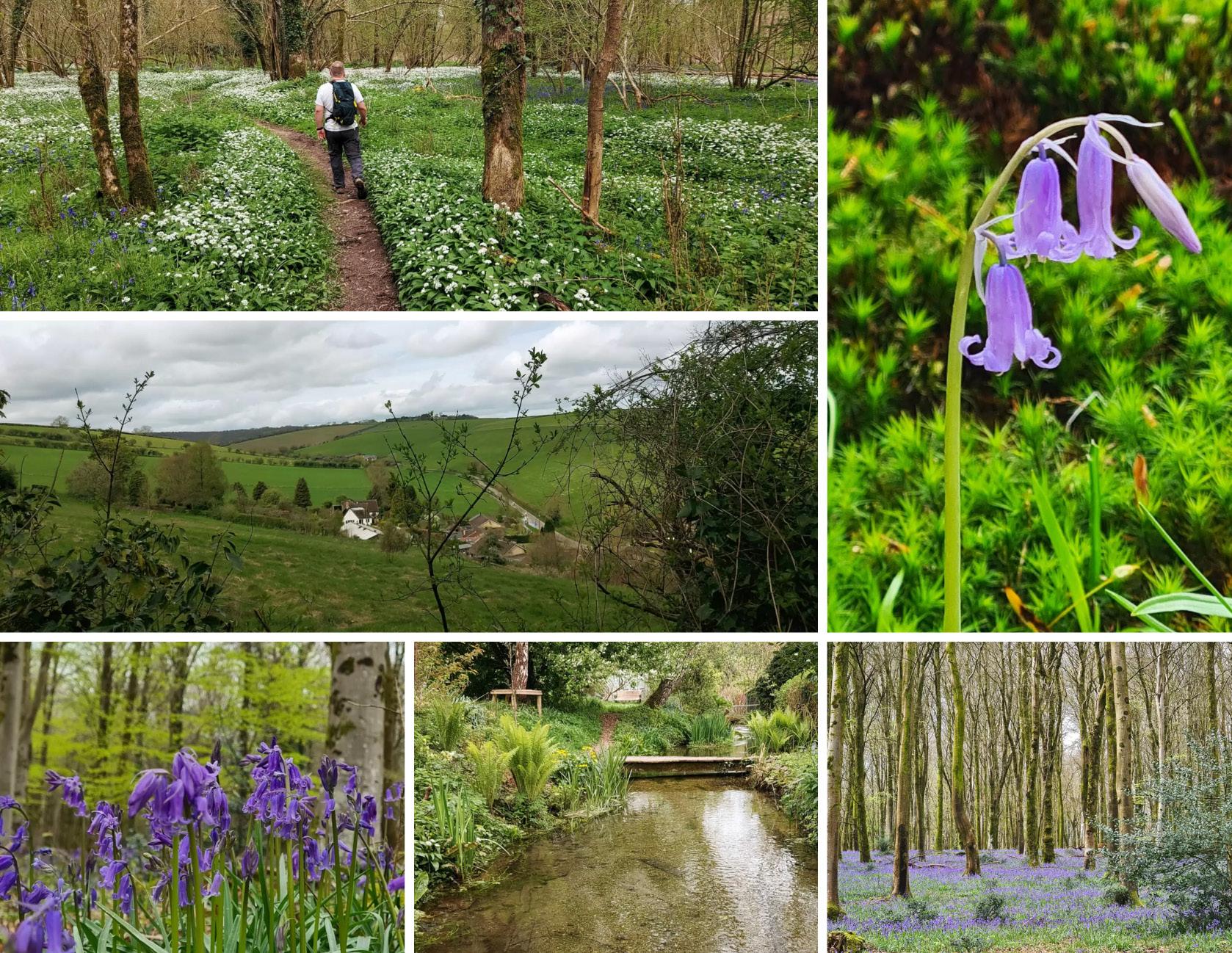
This month Barry Cuff has chosen a couple of postcards of East Stour:
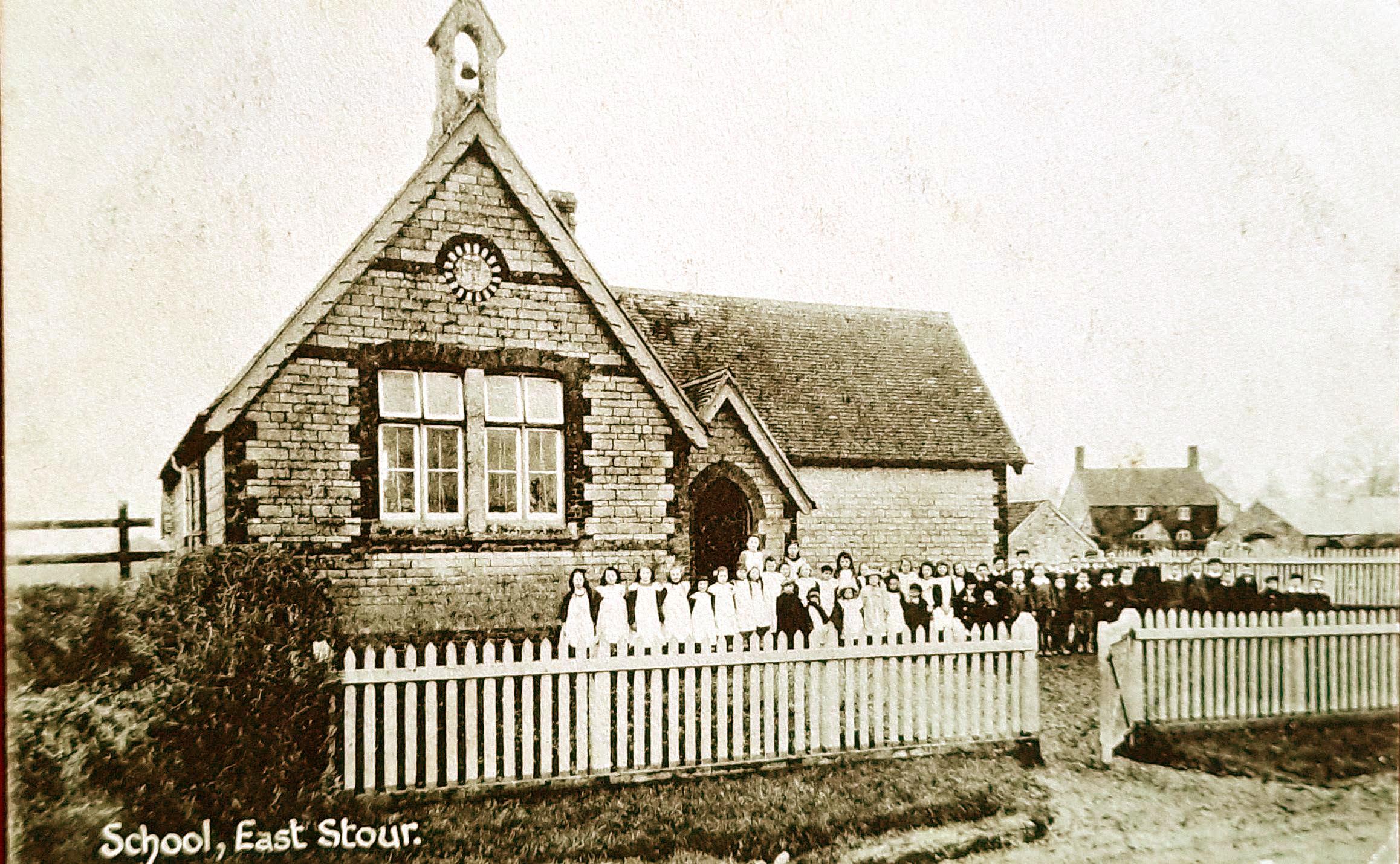
Sent in 1909 to Miss Wood, c/o Lady D’Oyly of Newlands Manor in Blandford – the house was built in 1884 by Sir Charles Walters D’Oyly after distinguished military service in India: ‘This is the school where I used to get a caning regularly every day, “pleasant memories”. Lovely weather today, just going visiting etc. Yours G.E.T


Sent to Percy Perrett, Leading Stoker on HMS Canopus, which was on a short deployment to the Mediterranean in 1908–1909. It appears it was a rubbish summer, and it’s clear Percy’s mother disapproved of Percy’s loving sender... ‘(The Dairy House, July 6th 1909) Dear Percy, Thank you so much for the C [card?] from Oban, I like it very much. I thought you would be interested to know I met your mother last Saturday afternoon. I was going up Ada’s & met her with her sister Emily. I suppose they were coming down to the churchyard, to see their father’s grave. She took no notice of me, but your aunt spoke. Thought to myself, I wish you had been here. People are busy here now with the hay, when the weather permits, but it is very stormy still. We do not seem to have had any summer at all as yet. I hope we shall soon get it better. Hope this will find you quite well as I am pleased to say we are. With love, believe me ever yours, sincerely J.T.M.
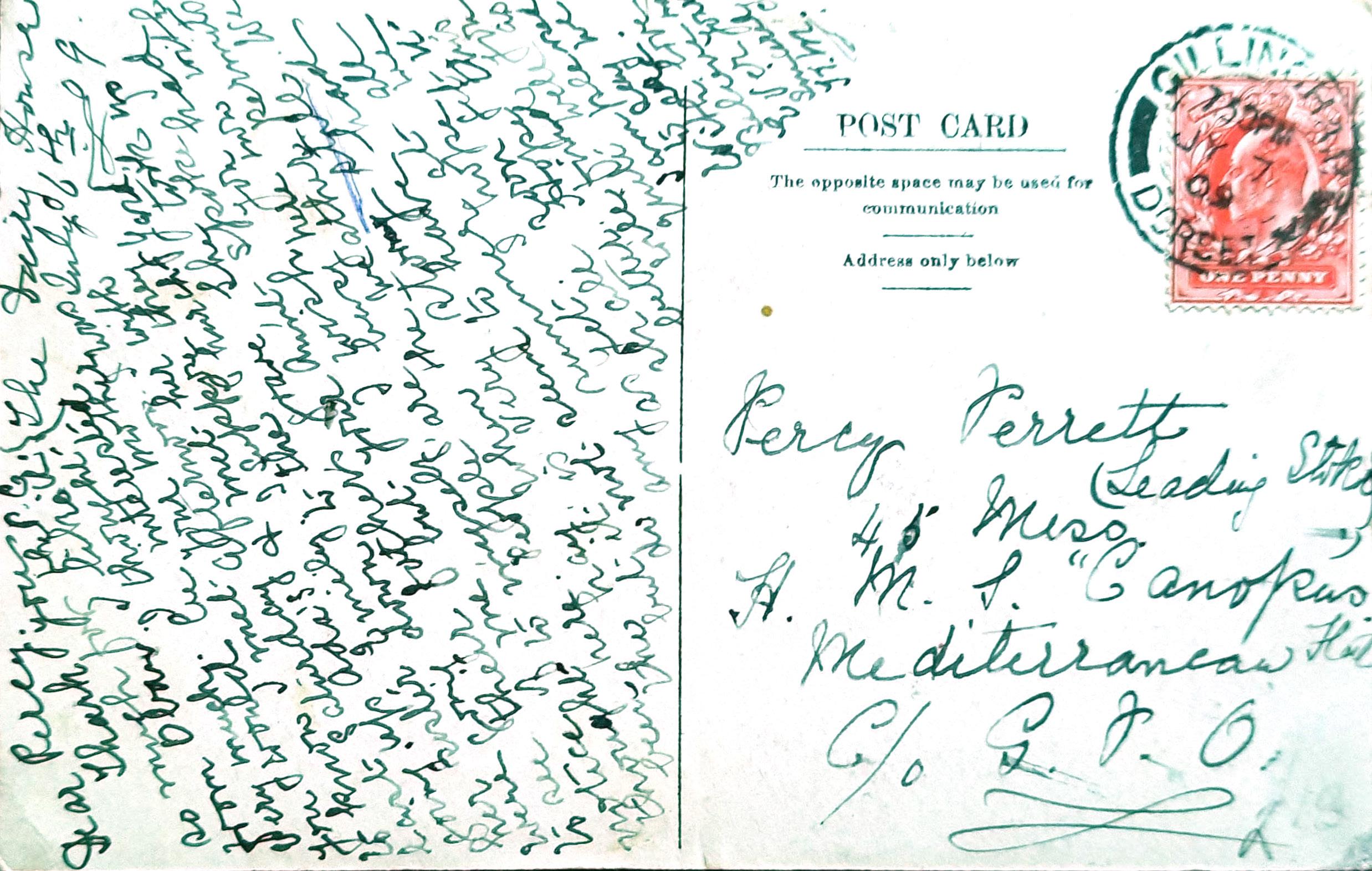
THEN AND NOW
Step back in time with our ‘Then and Now’ feature, where vintage postcards meet modern-day reality. Explore the past and present on the same page, and see the evolution of familiar local places. ‘Now’ images by Courtenay Hitchcock




Leigh was a chapelry of the adjoining village of Yetminster until 1847, when a separate parish was created. The Grade II listed cross was erected in its present position – on a triangular island in the centre of the village, at the junction of the roads to Chetnole and Yetminster – in the mid 19th century, possibly to commemorate the creation of the new parish. The previous location of the base and the shaft remain unknown; the shaft was already very worn in 1905 and the base had wear by possible foot traffic on one face. The stones were probably discovered as rubble, perhaps during the renovation of the church or churchyard in the 1850s and re-purposed as a village cross.

After reading January’s BV, I was truly inspired by Claire Allen’s expedition to walk the entire British coastline, raising money for two homeless charities. Reading her story made me reminisce about the time that I pulled on my own walking boots for greater a cause. Ultimately, it’s a tale of friendship, determination and blisters. But does have a sad beginning.
In May of 2011, my mother was battling breast cancer. She had to go to Southampton for surgery, and on the journey from Beaminster to visit her, we decided to redecorate the living room (she had been complaining that it was looking tatty for a while), planning a nice surprise for her to come home to. Unfortunately, she never made it home. Her condition continually worsened, and she died in the Weldmar Hospice in Dorchester.
Celebrity send-off
The Hospice was fantastic during the last few weeks of mum’s life – they made a difficult time so much easier. In my own small way of thanking them, I decided to get walking: to raise some money so they could continue their great work. Three months later I had managed to convince a few friends to brave a monumental journey with me: we planned a walk from Beaminster in Dorset to Carnon Downs in Cornwall – it was my grandmother’s home, and where we always used to holiday with Mum.
Martin Clunes, a long-time supporter of the hospice and a Beaminster neighbour, saw us off on our 150-mile journey through the hills and lanes of the Dorset, Devon and Cornwall countryside.
The planning was a little wonky, to be honest – on the first day we walked from Beaminster to Ottery St Mary, about 30 miles. That was a long day!
Greeted by my granny with a hug, a cup of tea and some biscuits. The perfect way to send off my mum
With our OS maps in hand, we completed the walk in seven days, and raised more than £5,000. Along the route, we camped in the gardens and fields of generous farmers who were kind enough to host a bunch of 15-year-olds! At the end of the seven days of walking, I was

greeted by my granny with a hug, a cup of tea and some biscuits – it was the perfect way to send off my mum.
Do something less boring ...
I recount this tale not because I want to inspire you to run a marathon for the Cats Protection or climb Everest for your local village hall restoration fund. I simply want to encourage people to get out and enjoy the outdoors.
I cannot tell you how lucky we are to live in this beautiful part of the world.
Growing up I was never a big fan of walking – I’d much rather have been either playing sport or sitting inside on computer games than hiking up a stupidly large hill. But when you walk 150 miles in the space of a week, you have a lot of time to think. And I soon started to realise, ‘Wow, where we live is pretty fantastic!’.
As an adult now, with kids and work, I don’t have as much time as I would like to spend strolling the outdoors. But now the weather is finally improving, I’m going to set aside a minute to visit our beautiful countryside.
On the farm, I always love bumping into people who are out enjoying the countryside, be that for a short walk with the dog and the kids or striding through on a serious day hike. Our farm is hilly and it’s muddy, but all I see are smiling faces on the footpaths.
As farmers we ask five simple things – keep your dogs under control, clean up their mess, don’t leave litter, stick to the path and shut the gate behind you! We farmers want everyone to be able to get out and enjoy the land. We simply ask you to respect our place of work.
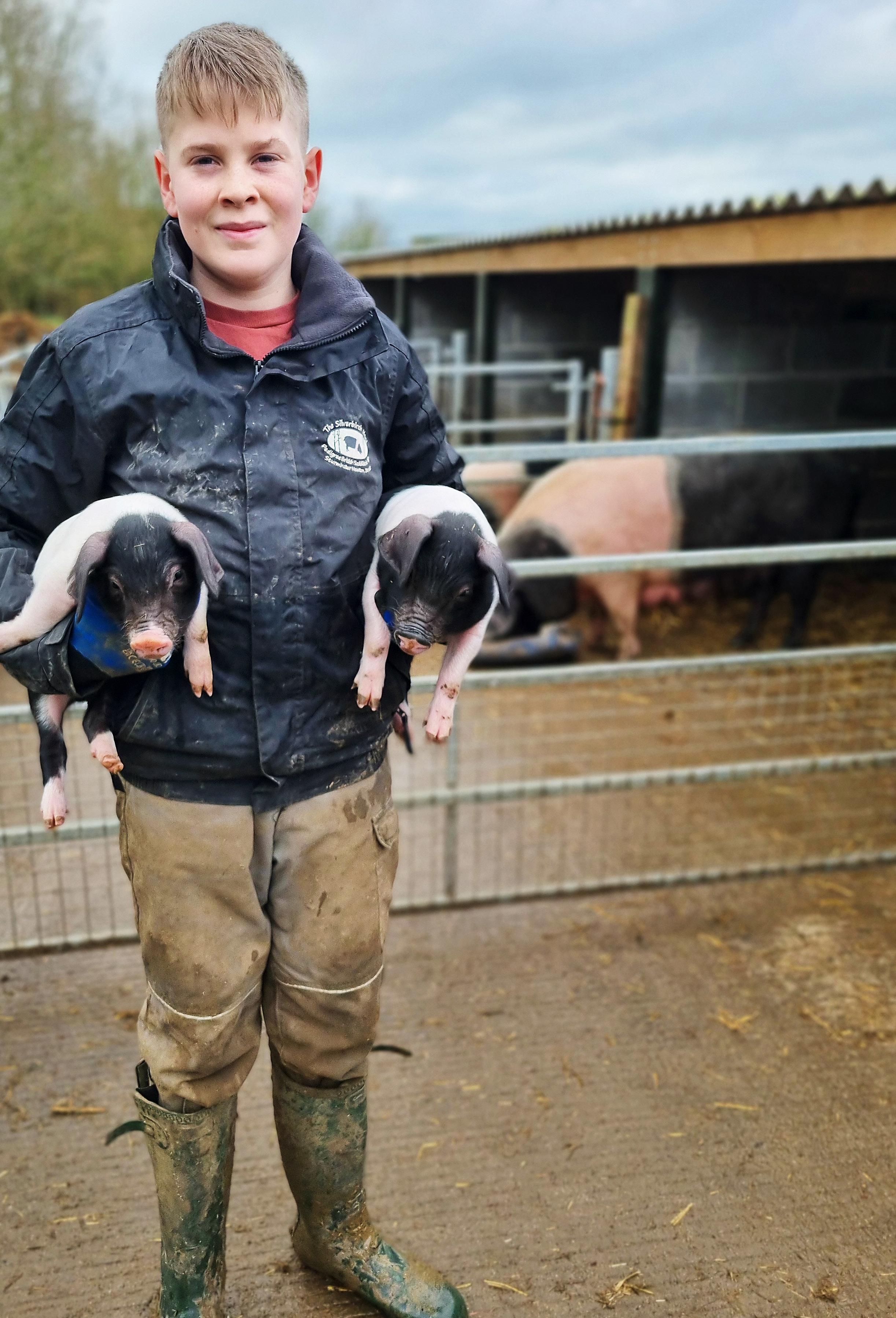
When Seb was eight he received four pigs for Christmas. Now he has one of the largest pedigree herds of the rare British Saddleback pig in the UK. Two years ago he started showing them, and qualified for both the 2022 and 2023 national championships. In 2023 Seb became the youngest ever recipient of the British Pig Association’s New Pedigree Breeder of the Year award, enjoying a swish night out at the National Pig Awards in London last November! Seb, from Sturminster Newton, is about to start the 2024 show season with his team of 12 pigs – he takes it so seriously he even has a show ring set up at home to practise. Seb’s parents take him and the pigs all over the UK – even on the ferry to the Isle of Wight! His pigs are well known in the local area, and he sells them as far afield as Devon, Wiltshire and Hampshire. And as if his own pigs weren’t enough for one teenager, Seb’s recently taken a Saturday job on a local dairy farm, furthering his knowledge and passion for UK agriculture.
Do you have a Future Farmer? Send a picture with a few details to editor@bvmagazine.co.uk
Rebecca Hill explains how the FCN blends farming expertise and professional support networks to bolster the farming community’s resilience
That’s me over on the right – I’m Rebecca Hill, the joint co-ordinator for Dorset FCN (Farming Comunity Network), along with Barrie Cooper (Barrie will introduce himself next month!). I farm at Winterborne Kingston – combinable crops, some on land that we own, some that we rent and we also share farm with the Drax Estate. Alongside the farming operation we have converted a range of redundant farm buildings for commercial use, and have some lovely businesses working from the farm. My family also run Wire and Wood Ltd, selling agricultural fencing supplies. During COVID I did some volunteering with FCN – I certainly didn’t foresee that I would become the co-ordinator! But it is a role that I find incredibly rewarding.
The FCN is a farmer’s charity – and as a group of volunteers we all have an understanding of

agriculture. We have been busy raising the profile of what we do in Dorset, running farm walks during the summer and quizzes during the winter months. Alongside the events, we offer support on a one-to-one basis. If anyone is struggling within our farming community we will send a volunteer to visit them
and help. Our job is to signpost people to make sure they get all the support they require. The cases we see are very varied – from issues with the RPA or other government bodies to families worried about succession or dispute, or simply being overwhelmed by the work, weather and the mental health stress. Our volunteers are there to walk with you for as long as we are needed.
We also work with our allied professionals – the vets, trading standards, land agents, the NFU group secretaries etc – because they are the people who, day to day, are out on farm and seeing people who may need our help. If you feel you are able to give some time and become a volunteer, or perhaps able to raise money for FCN, or if you need to talk to one of us – in complete confidence – please do get in touch with me on bec.fcn@gmail.com.

Navigating a challenging spring after the wet winter has meant late plantings and livestock turnout, but it could be worse, says James Cossins
At long last the relentless rain has stopped pouring on Rawston Farm – it’s been one of the wettest winters on record. We have now managed to sow our spring barley and spring bean crops, although they were planted about a month late. The national picture appears to be less encouraging – with fields still waterlogged many growers have given up on growing crops on them. It will be interesting to see how much land actually gets harvested this year, and what effect the wet weather will have had on the crops and their subsequent yield.
On the livestock side, we have managed to turn out most of our cattle to grass, and after a long winter they were keen to go out and stretch their legs! We were also relieved to see them out; our forage and straw stocks were rapidly dwindling after having the cattle housed for an extra month.
Frustratingly, our one TBinconclusive cow was retested and continued to be inconclusive. So she had to be sent to the abattoir, only for the post mortem to come back with no visible lesions – meaning

that she probably didn’t have the disease but may have been exposed to it. The whole thing has been very disappointing, but we are told that we just need one clear test in 60 days and then we will go clear.
The Government has recently made some changes to their Sustainable Farming Incentive Scheme – a programme that encourages farmers to adopt a variety of habitat management options on their farms to benefit the environment. The options included land being taken out of production, and
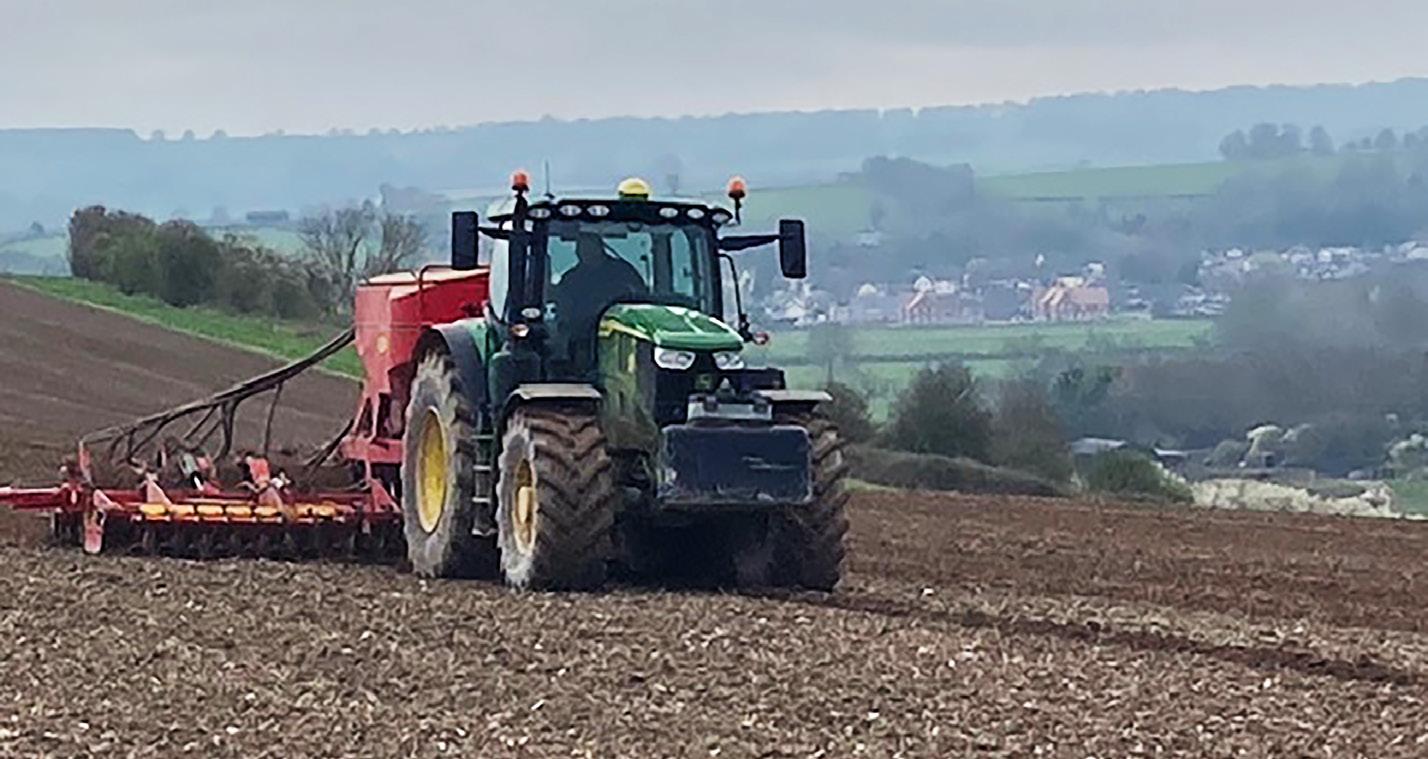
those have been almost too popular. Some farms have been completely taken out of food production, and the landowner has been compensated for doing so.
I think the idea was to take out the least productive parts of fields and put them into the scheme, but the government has now realised the amount of productive land not producing food is going to be so large that the country’s food security could be at risk, creating an even greater reliance on imported foods. It has subsequently been announced that a maximum of 25 per cent of each farm may be taken out of production.
As I write, we are about to sow our final crop of the season at Rawston Farm – the maize which will be used for feeding our cattle next winter. This will rapidly be followed by taking our first cut of grass silage, again for next winter feeding. Let’s hope the weather can be on our side for once!

Woolstone One and her 5 week old Planteur colt. All images: Courtenay Hitchcock

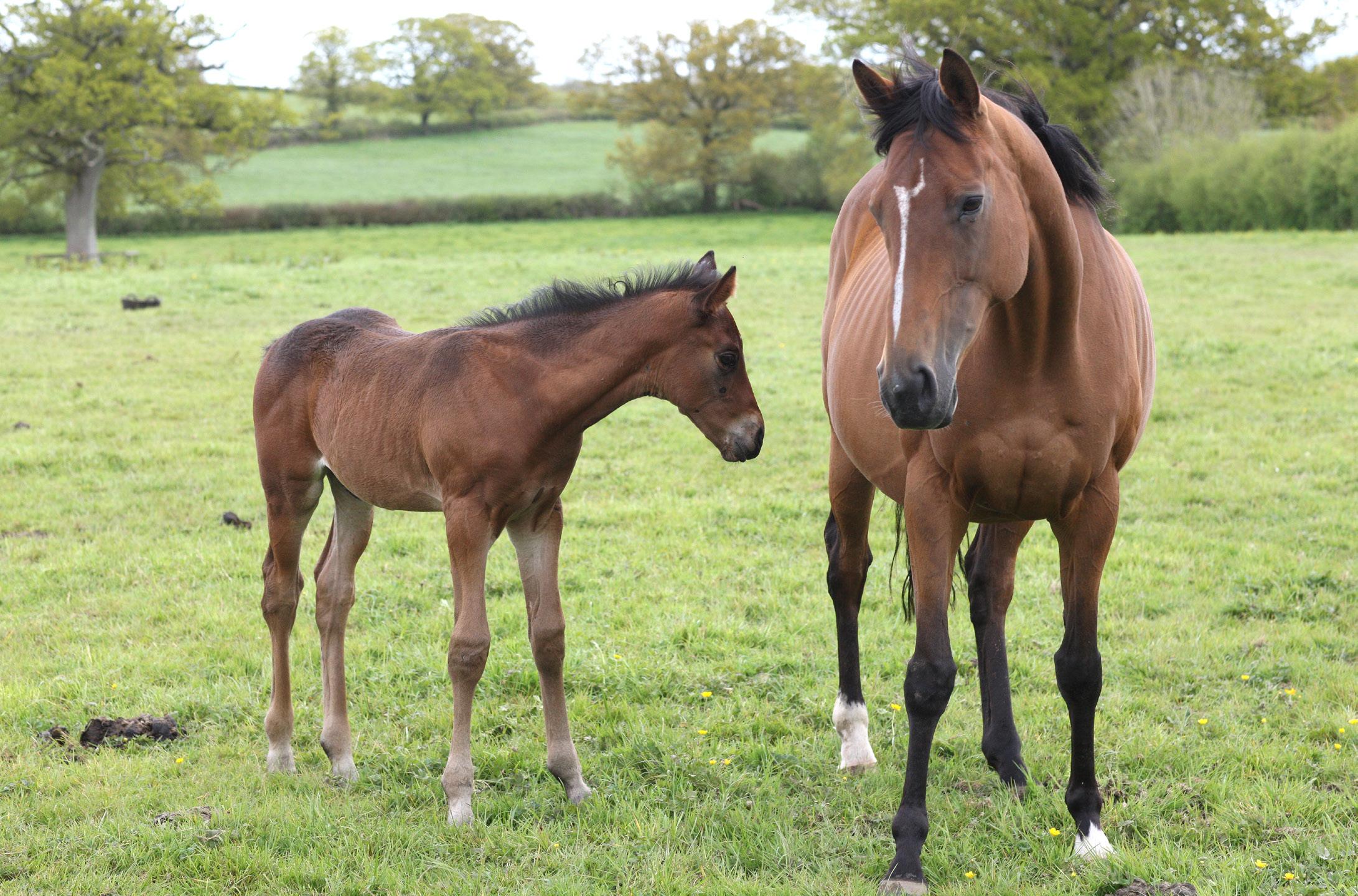
Ever-hopeful of an end to the wet weather, Lucy Procter has her work cut out with poached fields and the dangers of spring grazing
Wet and windy – April has left us the same way it arrived. But it hasn’t all been doom and gloom: the sun and wind through the
middle of April quickly dried the land, resulting in frantic rolling of the fields before the ground dried out too much.
Gawler (3 months old colt) and Randwick (7 weeks old colt) - rough and tumble play fighting is important in young horses, helping them learn vital social and behavioural cues from the other members of the herd
Rolling is important to level out the ground where horses have been turned out during the winter, the soft ground
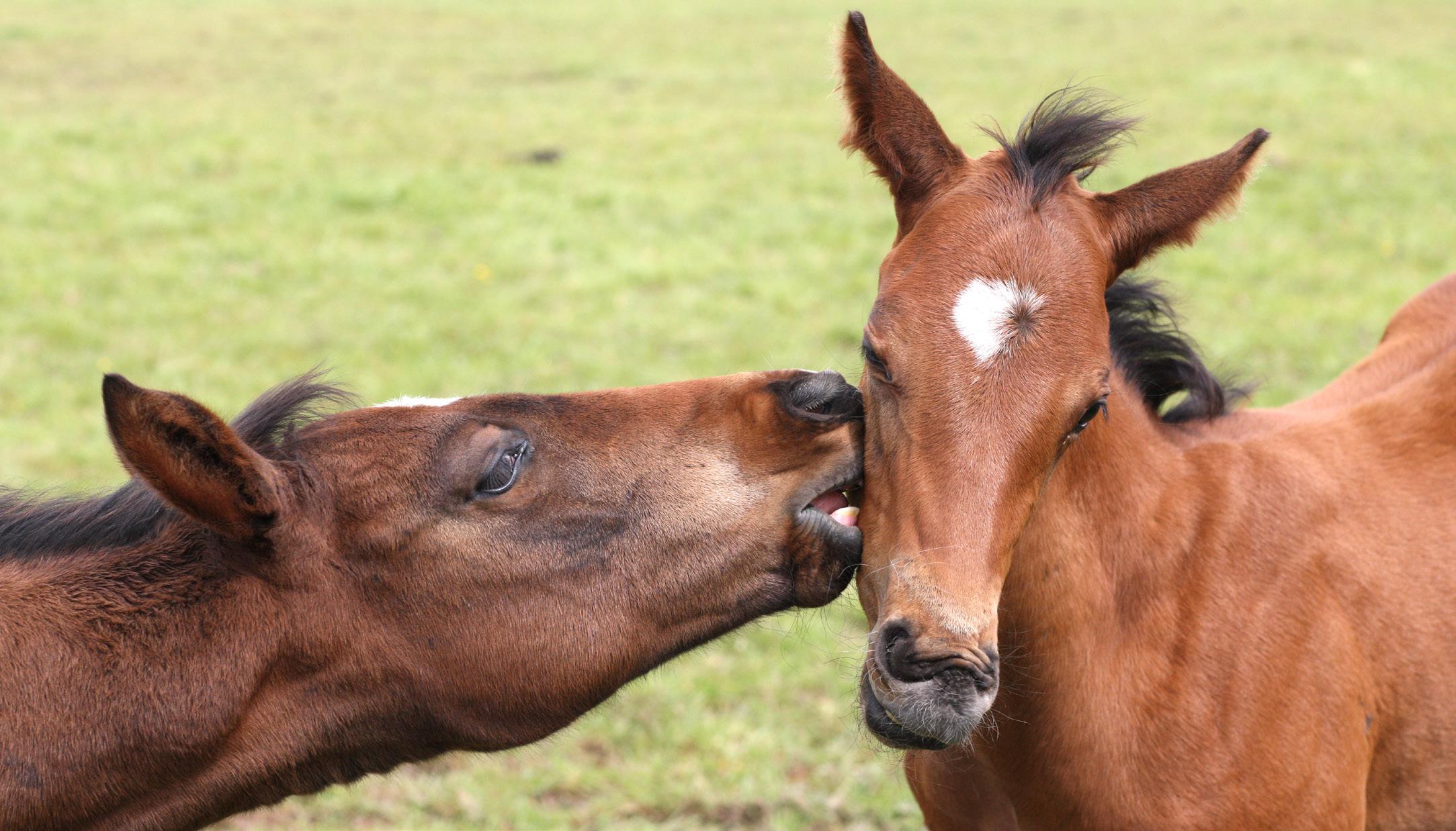


Roc Royal with her foal Randwick being photobombed by Cairns, keen to show off his patchy, war-paint face, as his foal coat starts to drop out and change colour
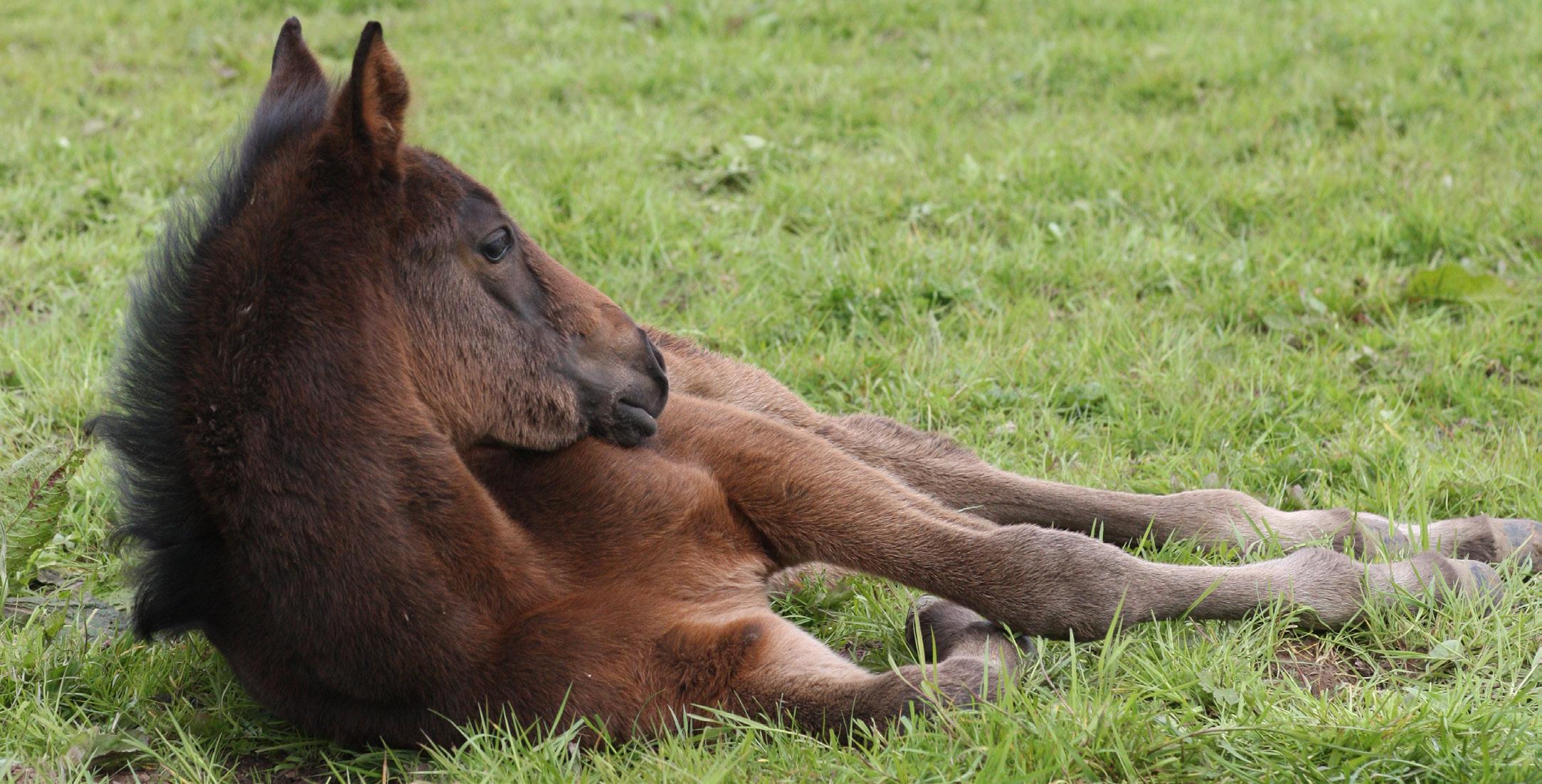
churned up by the hooves of several half ton horses. The resultant ruts and pitting is known as poached ground, and if this is left to dry hard in the summer, the surface becomes legitimately legbreaking for horses. Horses can easily injure themselves by galloping over uneven ground in just the same way that a person is liable to twist or break their ankle over rough terrain. Unlike people who can be warned to walk carefully over tricky terrain, however, turn a horse out in a lumpy, bumpy field and they will most likely will do what horses like to do best –gallop around at top speed to let off steam before stopping to graze.
Roc Royal’s Walzertakt colt, Randwick, has just come in after being out for a few days and is super, super sleepy. Not sure how comfy the feed bowl is, but he’s obviously not bothered!


Just look at Belle’s week-old, super-long legs –no wonder she was needing a rest!
Done correctly, rolling also encourages good grass, stimulating growth in damaged areas and improving soil health by increasing soil density, reducing air pockets and improving soil structure. Once the ground has properly dried it will be time to bring out the harrows to help break up any leftover poaching, spread any horse droppings that have accumulated over the winter and remove any dead grass or unwanted weeds.
Most of our horses are now turned out all day and all night. Those with very young foals at foot – or who have not yet foaled and therefore need to stay under camera – are still coming back into stables at night. But turning horses out for the first time, after several months of eating hay in all-weather turnouts rather than grass, is tricky. This year, the relatively warm winter has meant that the grass has continued to slowly grow, leaving us with fields of excessively long, lush, spring grass. A horse’s stomach cannot tolerate drastic changes in feed. If a horse suddenly begins gorging on lush grass having been eating hay all winter, it is in danger of developing severe abdominal pain caused by problems in the gastrointestinal tract. This is known as colic – one of the most common causes of death in horses. We start by introducing field time in short periods of a few hours, followed by time back in the stable or all-weather turnout eating hay.
After a week or so of gradually increasing the length of time they are out grazing grass, the horses can safely stay out day and night.
On the racing front we were especially pleased to take one of our homebred horses we have been training, The Swede, to race at Axe Vale Point-to-

The orphaned foal, displaying more warpaint on his face as his bay foal coat changes to a greyer hue
Point. Although she pulled up before the last fence, our daughter Alice, who was riding her, was very pleased with how she travelled through the race and how well she jumped. We are hoping to race her again in May.
While typing this, I can hear the birds singing outside and, although the sky is still grey, it has finally stopped raining. Although last night’s downpour has reduced many of the fields to swamps again, I am allowing myself a tiny hope that we have got through the worst of the winter, and that a drier spring is just around the corner ...

and Randwick still at it - colt foals are more likely to indulge in play fighting than the filly foals.



As the 2024 event season gets under way, Jess Rimmer finds herself balancing books and bridles as it coincides with exam season
I thought I’d kick off this month’s report with an insider look at life juggling eventing with university. April saw both our first events of the season and the submission of my dissertation –so I don’t really have brain space to think about anything else!
It’s a common misconception in the horse world that it is necessary to make a choice between pursuing a career in horses and continuing with education. People seem to think it is one or the other – but I didn’t see why I couldn’t do both! It has definitely been a juggle, though, and when I look back over the past three years I sometimes wonder how on earth we made it work!
My weeks have generally involved being at uni in Bristol from Monday to Wednesday, then whizzing home to ride for the rest of the week. The pandemic meant a lot of my course was delivered online, which meant I’ve been able to keep up with my degree from home, fitting
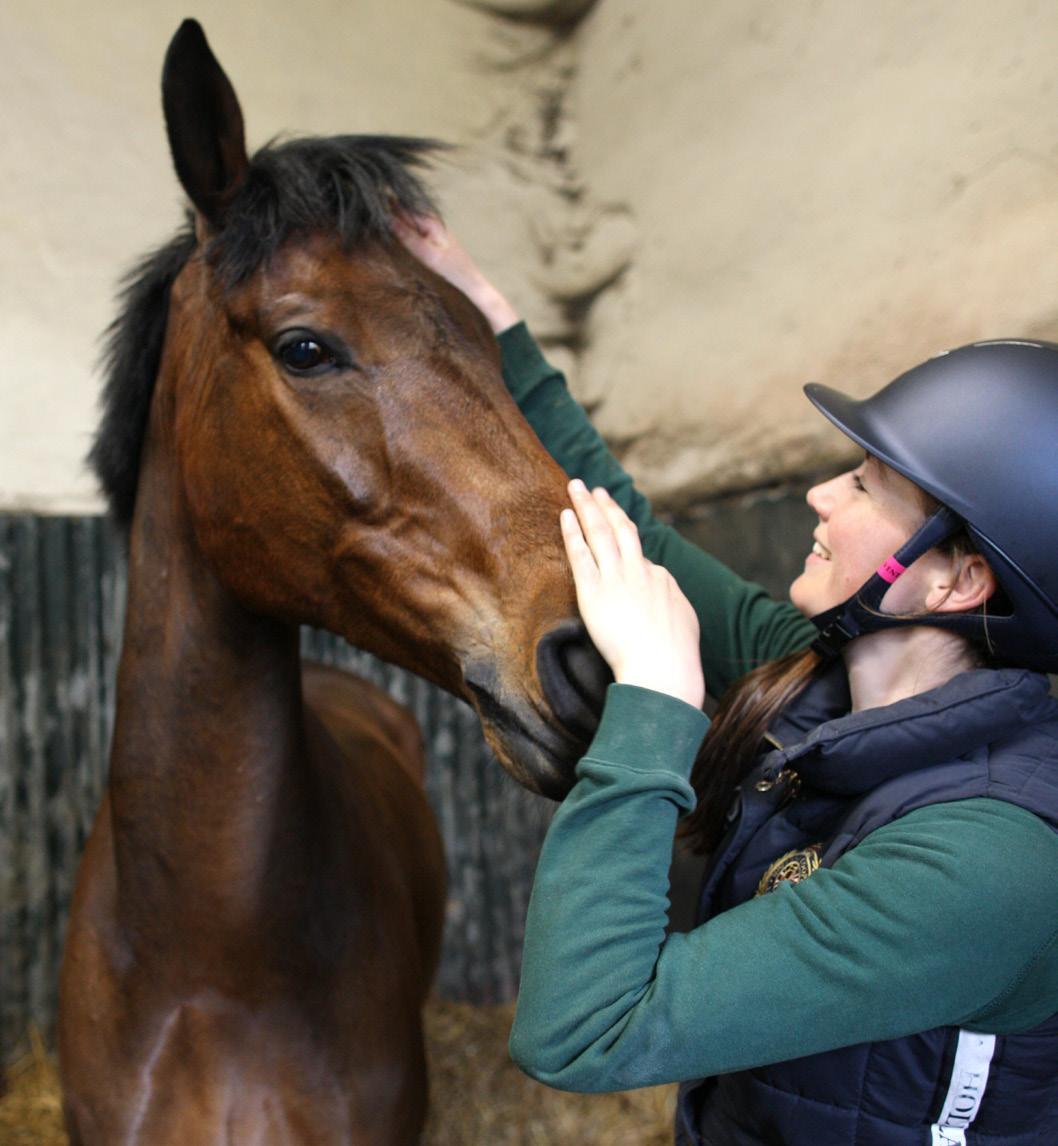
 Mattie (The Real McKay) missed the first events of the season with an untimely foot bruise, but he is now back on track
Mattie (The Real McKay) missed the first events of the season with an untimely foot bruise, but he is now back on track
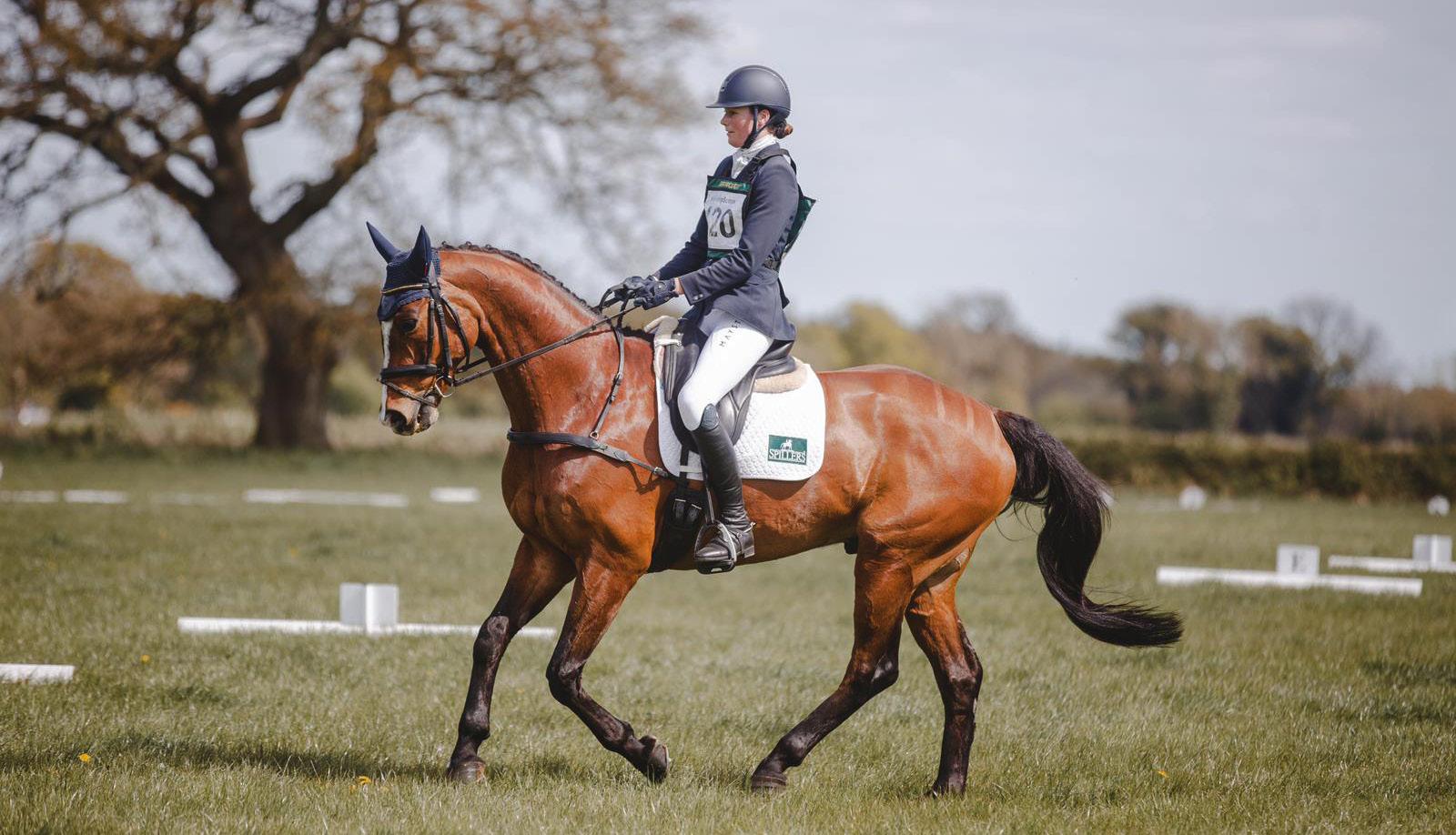

lectures in wherever possible around the horses’ routines. May sees the start of exams, which inconveniently clash with some of the first internationals of the season. Obviously I was never going to miss those –which is how I’ve ended up sitting exams from a hotel next to Houghton Hall, from the judge’s box at Bicton International and sitting in the back of a taxi in France! With careful time management, anything is possible. I guess what I’m trying to say is, if you want to go to uni but are worried about missing out on the horses, just go for it! And if anyone reading this is wondering how on earth they can make it work, I am always happy to chat.
The season begins OK, back to the horses! My season started a little later than usual this year, following a head injury over the winter. But with plenty of patience and support, I am now fully recovered and finally able to get the ball rolling! Our first event was a local one at Moreton, where we
had Newt, Elsa and Henry. Newt and Elsa were introduced last month, but we didn’t meet Henry (Sir Henry Hall). He is a complicated horse with bucketloads of talent – but he is the ultimate worrywart. He would love to bury his head in the sand at everything scary –which is frankly most things, from his point of view! However, he always seems to perform under pressure. It’s as if he knows when it counts. At Moreton he jumped brilliantly, as did Elsa and Newt. We then went to Cirencester Park with the same trio, where they all performed superbly, setting us up nicely for the season ahead. Mattie (The Real McKay) sadly missed his first runs with an untimely foot bruise, but he is back on track, pictured in a training session at home, under mum’s watchful eye. His season will hopefully start at Tweseldown next month
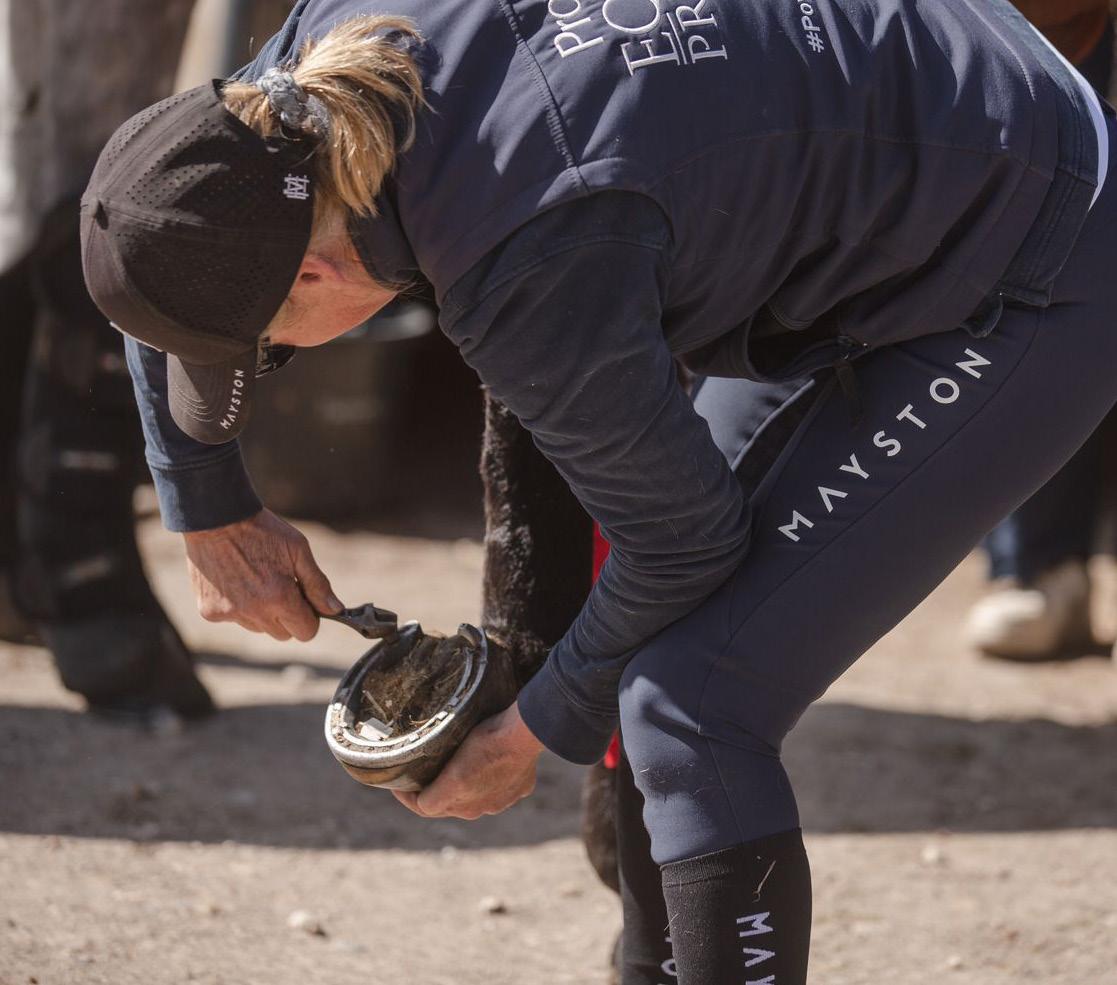
– which happens to be the day before my first exam. And so the juggling act continues! Looking ahead to May ... you guessed it: lots of eventing,
interspersed with exams – see you on the other side!
• Follow Team Rimmer Eventing on Faceboook

This month, Sally Cooper shares Rodney’s recent medical saga, with a stunningly swift, unexpected diagnosis and treatment
This month I was contemplating what to write about – the endlessly long muddy, mild, wet, winter (or the arrival of spring... and midges)? The no-accident Grand National? The London Cavalry horses loose in the city? In the end, I must write about my lovely grey donkey.
Rodney (aged three) is my rescue foal and I adore him. Having recently lost his mate Henry to leukaemia, we found the lovely ‘fluffy Pebbles’ as his new friend. They are a happy duo – they eat, sleep and play fight with jolly smiles on their faces and very loud brays when I so much as sneeze in the house or move a muscle in the garden.
Last week I felt Rodney seemed a little preoccupied, and thought I saw a small swelling on his male member. I decided it must be my imagination... but two days later there were several lumps. Another day and we were in a bloody mess.
The vet was called, and she was alarmed at both the rapid growth and size of the tumours. “To the surgeon. Stat.” was the suggested course of action.
Sad Henry déjà vu set in, but
two days later we were off to the equine hospital in Salisbury. Thankfully both Rodney and Mr Pebbles loaded swiftly onto the lorry – an unexpected good start. The Shetland who mothers the donks was placed with Big Alf the cob for the day, and off we set.
Arrival at the hospital gave us our first ‘NOPE. Not doing that.’ Donkeys tend to shut down and internalise their fear – a donkey’s typical reaction to not wanting to do something is to plant his feet and refuse to move. And there was no way our pair were going into that five star bedroom with its blatantly horrific offering of deep shavings, fresh water and nice view from the sunny window. The super-Hibiscrubbed clean hospital was, in fact, lip-curlingly yucky, smelly and NO.
Thank you.
Twenty minutes and five humans later they were finally in their luxury stable.
The operation went well. Said male member was lasered, and then oil-suspended chemotherapy was injected to hit any other bad cells. We had a sad grumpy
Rodney, ever hopeful for something tasty in your pocket
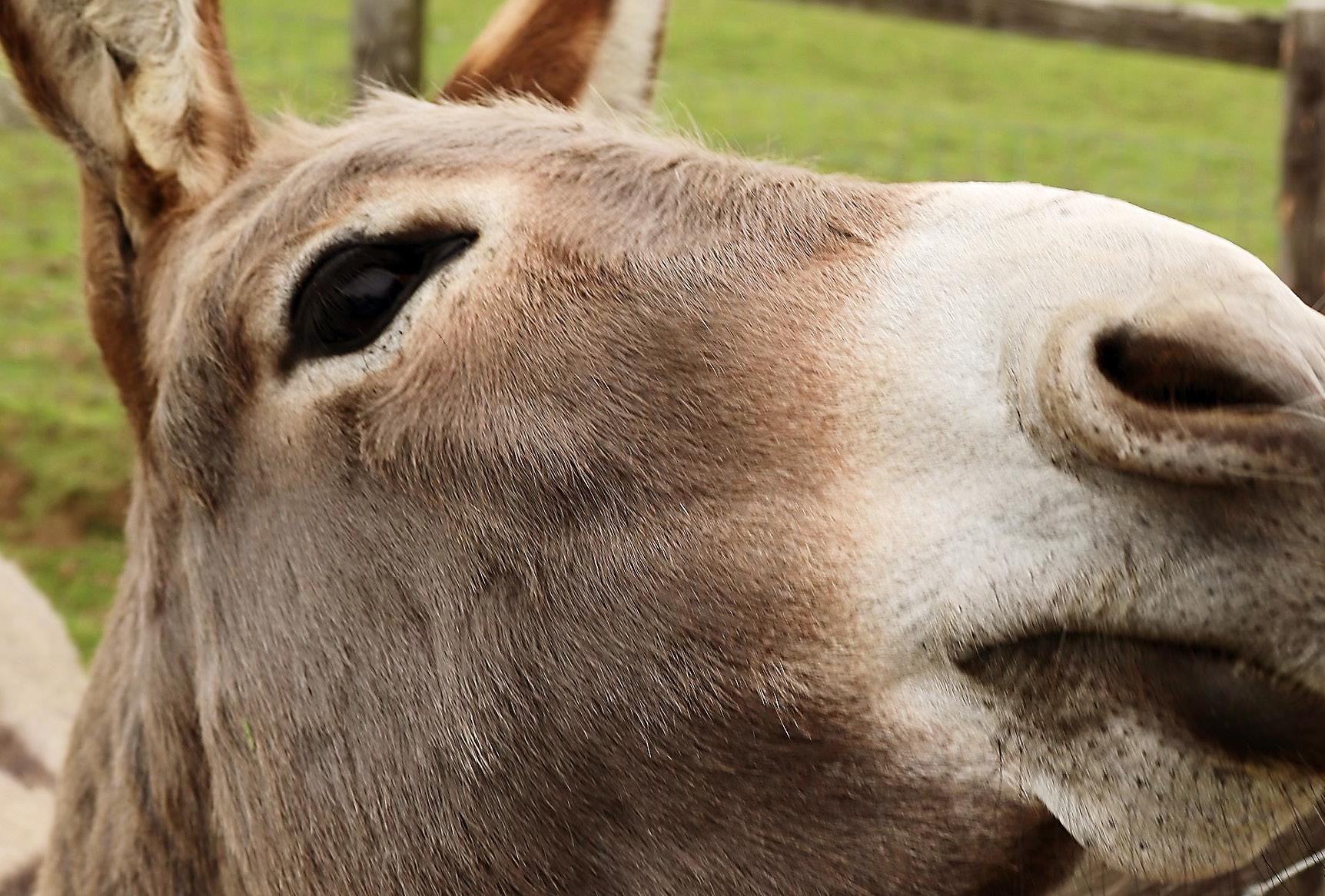
Rodney on the way home, while the irrepressibly bouncy Pebbles wondered what an earth the day trip had been for.
Five days later and we had the biopsy results – Rodney has malevolent sarcoid cancer*. It will reappear at some point. So we will live life for the moment, and enjoy every minute we have with him.
Like most families we’ve been assessing the candidates for the local elections, and have been talking about our public sector services. The donkeys led to some interesting conversations about the state of the human NHS versus the private (super swift) animal service. The sad conclusion that we all reached is that you are better off being an animal – with a great vet and a speedy, informative equine hospital – if you want to go from ‘something might be wrong’ to surgery and your results inside eight days.
On a more serious note, the men in the house all agreed that it had genuinely made them aware of the need to check ourselves regularly for lumps.
Rodney and Pebbles are back to their jolly selves, with the happy rotation of eating and sleeping and boxing each other around the ears. Rodney had a few days with no voice but is now back to full throttle – and I am back to stealthily creeping out of bed in the morning. Long may their happy days continue.
Carpe diem everyone.
* Sarcoids are the most common skin tumour in horses and donkeys – although they look initially like warts, they are a form of skin cancer.
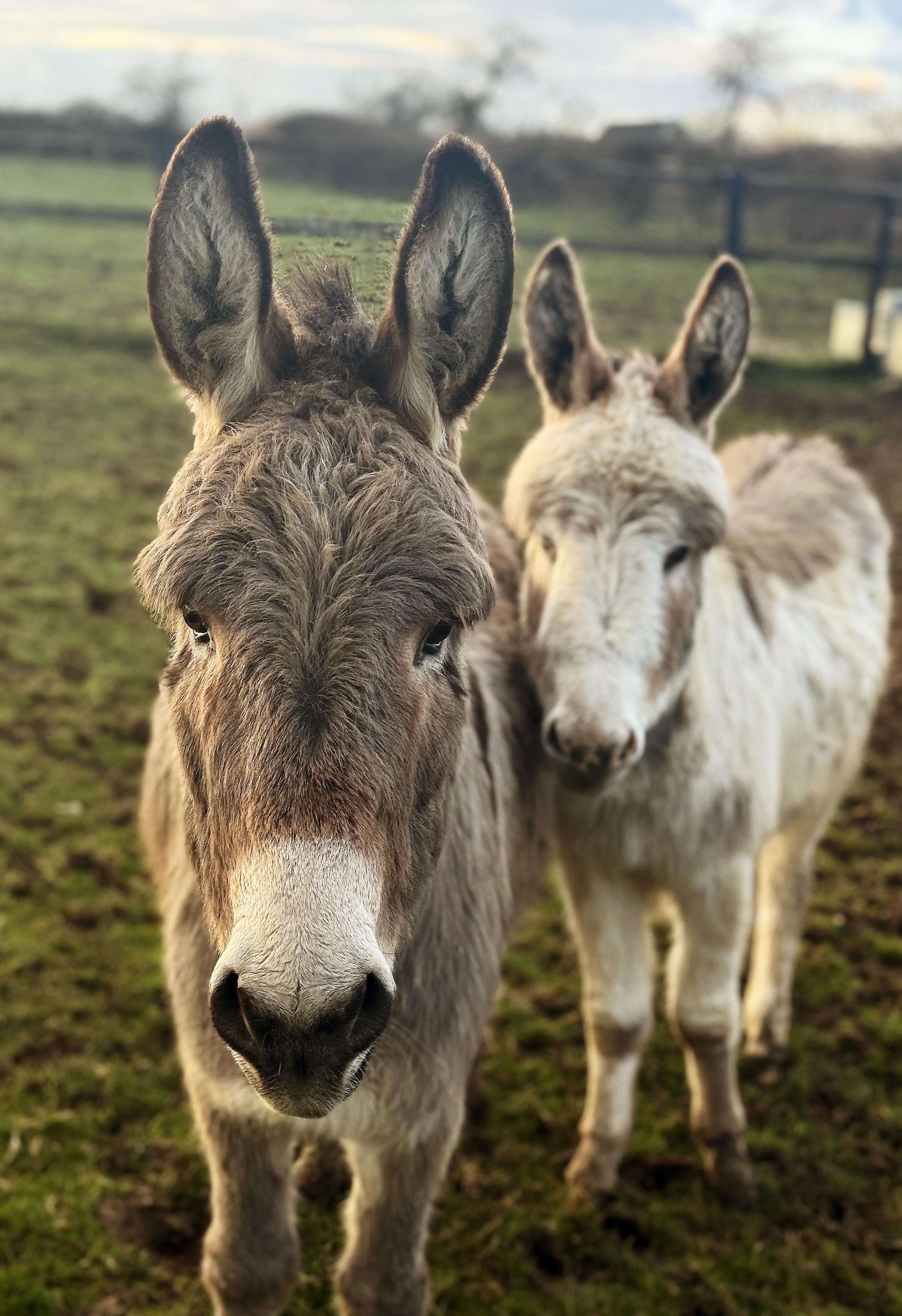
The cuckoo is a dove-sized bird with a blue-grey back, head and chest, and stripey black and white belly. Its sleek body, long tail and pointed wings give it an appearance not unlike kestrels or sparrowhawks

It’s becoming an echo of the past, says wildlife writer Jane Adams –the cuckoo’s call is now a rare sound in the UK’s changing seasons
When did you last hear a cuckoo? There was a time when I could rely on hearing one from my garden, its twotone call carrying on the spring breeze from nearby water meadows. But that was back in the 1980s... now, each spring I think myself lucky to hear one at all, let alone to do so from my own garden.
Cuckoos are a bit like Marmite – you either love them or hate them. The fact that they lay their eggs in the nests of hosts such as reed warblers and meadow pipits and leave these much smaller birds to raise their young for them, feels somehow wrong.
The rude guest
But this behaviour, known as brood parasitism, is not unusual in the animal kingdom. Chances are, you have ‘cuckoo’ bumblebees and ‘cuckoo’ wasps buzzing around your garden right now. What sets this bird apart from other species of parasite lies in its skilful art of deception.
Having spent winter in Africa, cuckoos return to the UK by the end of April. They don’t spend long here, with many having flown south to Africa by the end of June.
They mate, and the female will search for a suitable nest to lay an egg. She will repeat this up to 20 times, laying each egg in a different nest. These eggs –which closely resemble those of their host – will hatch, and the young cuckoo will swiftly remove any other eggs in the nest, demanding to be fed until it can fend for itself.
A seasonal mismatch
So, why is their distinctive call so rare nowadays? There’s a myriad of probable reasons.
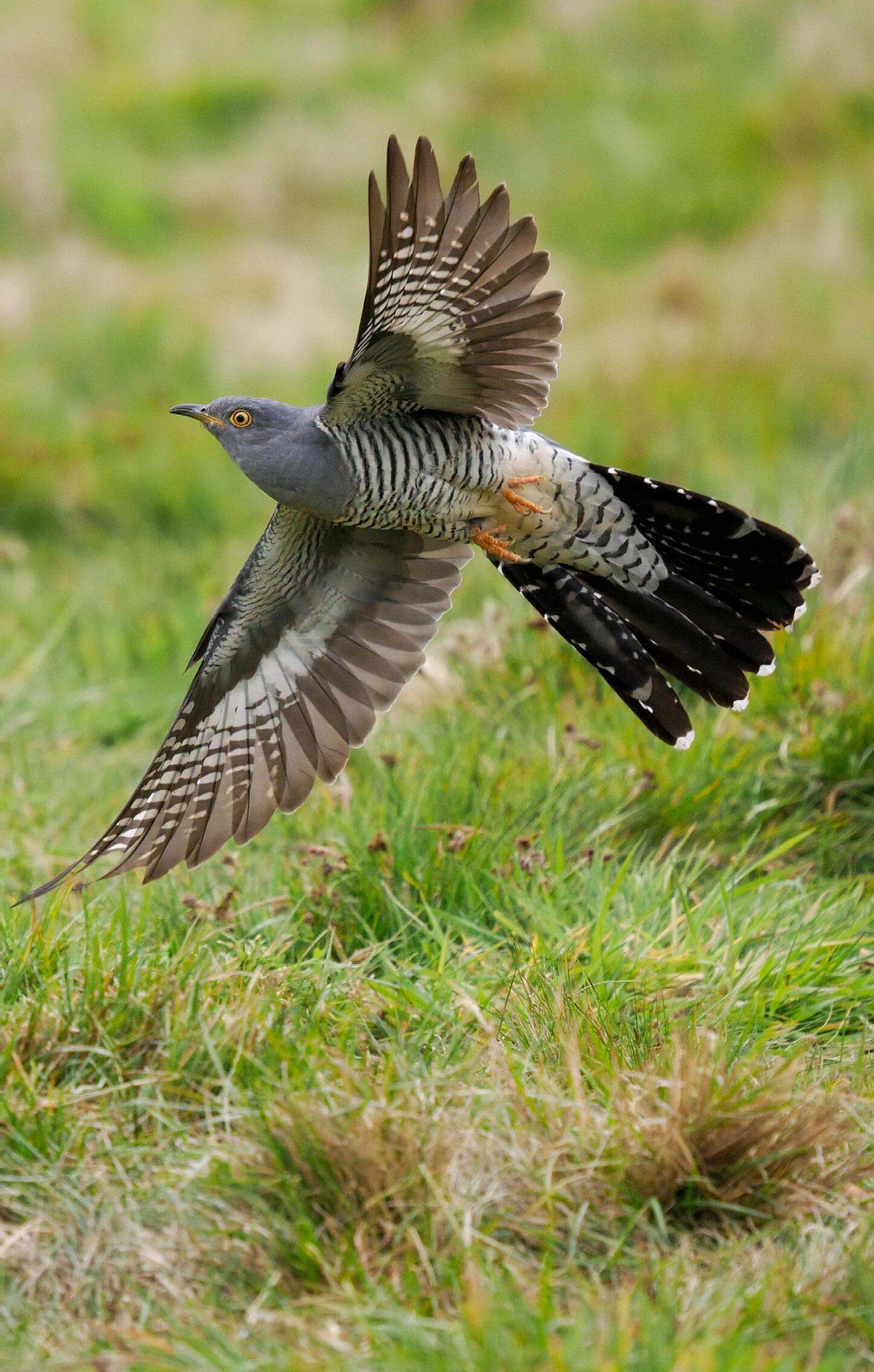
Many people have heard but never actually seen a cuckoo. You will find them in habitats where there are large numbers of meadow pipits or reed warblers – look out for them perched very still, on the lookout for prey (invertebrates and hairy caterpillars ) and unattended nests.
Despite returning to the UK at a similar time as they did in the 1960s, spring now comes much earlier. This means the caterpillars they feed on might well hatch before they arrive, and the cuckoo’s native hosts may already have hatched their own eggs. Combine these out-of-sync seasonal problems with the fact that more cuckoos are dying on the return journey to Africa, and you can soon see why their numbers have declined:
since the early 1980s, cuckoo numbers have dropped by 65 per cent.
When my husband told me he heard a cuckoo recently, I raced outside, desperately hoping to hear it. But after an hour, I still hadn’t heard it. That evening, my mobile rang and the cuckoo ringtone I’ve recently added blared out. “Did you hear it that time?” my husband shouted from the other room. I‘m still deciding whether to tell him.

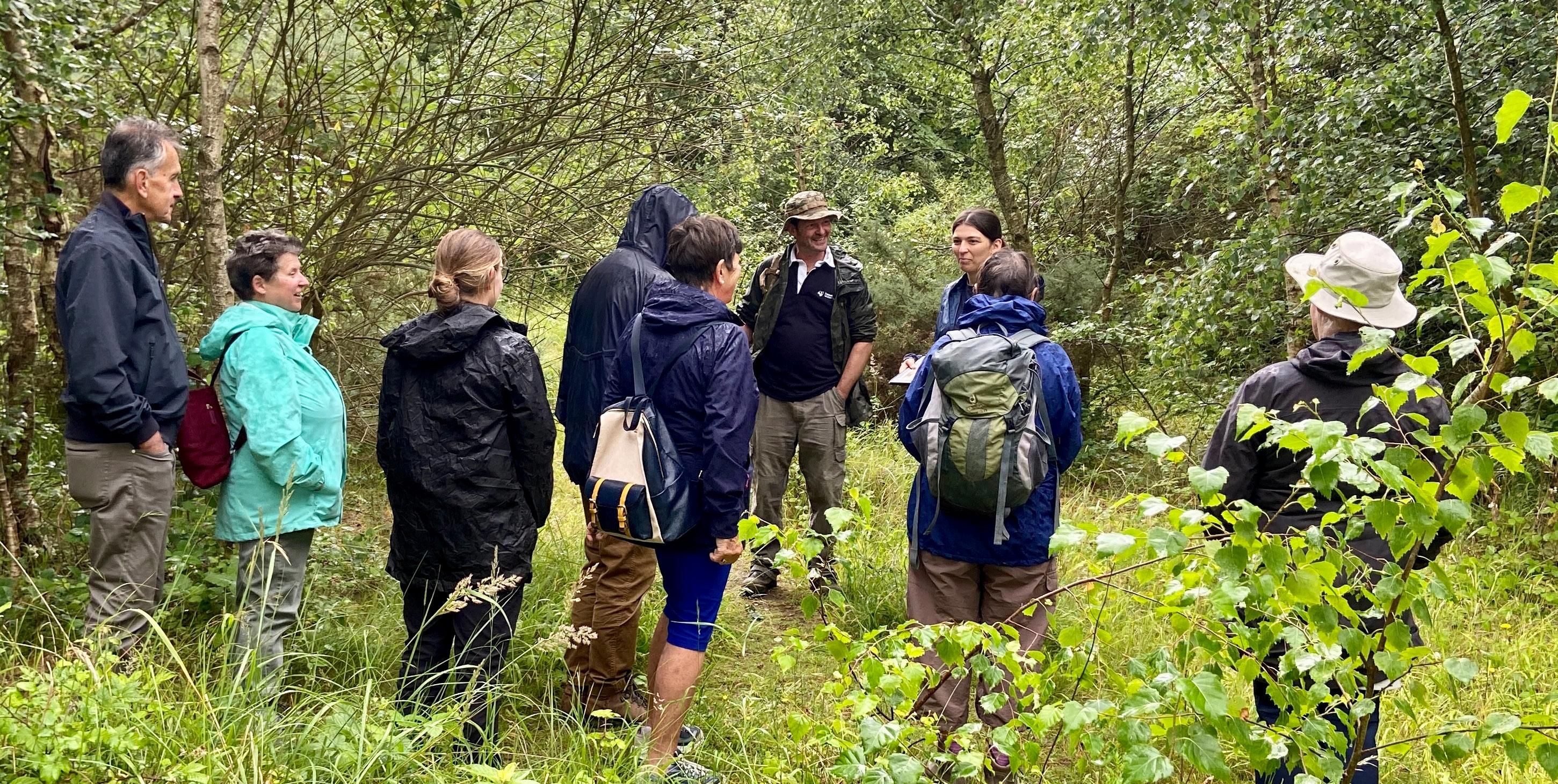
Connecting with nature has positive benefits for our health and wellbeing, says Dorset Local Nature Partnership manager Maria Clarke
The ‘Five Ways to Wellbeing’ is a set of evidencebased actions that h ave been developed by the New Economics Foundation (NEF) – it’s a list of simple ways we can all improve our own health by connecting with people, being active, learning, taking notice/being mindful and giving. If you do any of these while connecting with nature, there are added benefits.
I know personally that walking, being in a natural space or simply stopping to take notice of life around me makes me feel good, and can help reduce any anxieties and stresses.
At the start of the first Covid-19 lockdown, I decided to give myself a daily dose of nature and to really take notice of nature and even post a photo or video on Facebook. It gave me something to focus on and grounded me in uncertain times. I loved it so much, and felt so many benefits, that I’ve not stopped since! More than 1,300 days later I’m still posting daily pictures, constantly learning about the world around me, trying to be present.
There is increasing scientific evidence of nature’s value to our wellbeing. The Wildlife Trust has recently published a study that shows naturebased wellbeing activities could provide cost savings to the NHS of £635 million pounds. However, we know that there are health inequalities within Dorset, and not everyone has equal access to green spaces. Dorset Wildlife Trust and partners such as the Dorset Local Nature Partnership (Dorset LNP) are working together to have nature-based wellbeing opportunities
embedded in the local health system. We are working not only to improve access to nature, but also to promote the benefits of nature in support of both physical and mental health. Health and Nature Dorset (or HAND) is a new collaboration, led by Dorset LNP, to strengthen the county’s nature-based wellbeing. HAND includes a wide range of organisations such as NHS Dorset, Public Health Dorset, Dorset Wildlife Trust, Dorset National Landscape, Active Dorset, National Trust, Dorset Council and BCP Council.
Give nature a go
Last year, HAND ran a staff wellbeing programme for the Integrated Care System (those working in NHS Trusts, social care, primary care, and the unitary councils) called Give Nature a Go. Activity sessions were run by HAND members, including forest bathing, yoga, mindfulness and wellbeing walks (sessions were run at DWT’s Kingcombe Meadows, Wild Woodbury and Brownsea Island). We would like to thank our funders, including Southern Co-op, National Lottery Heritage Fund, National Lottery Community Fund and Natural England, for supporting this fantastic work. Communities can also work together to create wilder, green places on their doorsteps, helping nature to thrive. Our Nextdoor Nature programme helps to support communities leading their own events and activities to help wildlife thrive within their local area.
• Visit dorsetwildlifetrust.org.uk to discover more opportunities to connect with nature.


A Flavours project group get together
Dorset Food and Drink celebrates local produce this summer – and shares recipes with some of Dorset’s refugee and ethnic minority residents
Dorset Food and Drink, the county’s food producer group, doesn’t just support and promote local producers, it also works with refugees and people from ethnic minorities living in the county. The Flavours project, a joint venture with Dorset National Landscape, Dorset Race Equality Council and Grace the Space, is all about finding ways for people from other backgrounds – from Afghanistan to Zimbabwe – to explore and discover some of the farms and open spaces within our local landscape.
The aim of Flavours, says Dorset Food and drink coordinator Can Richards, is ‘to help build confidence for refugees and others, to connect them to nature in Dorset and to share food and drink in all its glorious expressions. From picnics, shared lunches and recipe swaps to baking and cooking together and sharing food stories and traditions, food is central to all the activities.
‘Shared meals, crafted from locally sourced ingredients and prepared with care, become more than just sustenance – they become bridges, uniting participants across cultural divides and fostering bonds that transcend differences.’
The group, whose members include a number of Ukrainian refugees, has enjoyed visits to several local farms and parks, including Launceston Farm near Blandford, Durlston Country Park and two organic farms, Middlebere near Arne and Tamarisk at West Bexington.
‘Flavours wants to help make connections and memories that will last … one bite at a time!’
If you would like to get involved with the project – to join the conversation or be a part of this exciting initiative in other ways, contact Caz on 01305 224717 or hello@dorsetfoodanddrink.org
Feasting with the cygnets
Dorset Food and Drink had to cancel Abbotsbury Food Fair, its first major event of 2024, because of heavy rain and flooding – so it’s fingers tightly crossed for the two-day Abbotsbury Swannery Food & Craft Fair over the late May bank holiday weekend, Saturday and Sunday 26th and 27th May. It would be hard to imagine a more beautiful or atmospheric setting than the centuries-old swannery – the only place in the world where visitors are able to walk through a colony of nesting mute swans. The Benedictine monks, who built a monastery at Abbotsbury during the 1040s, farmed the swans for food. The monastery was destroyed in 1539 during the Dissolution of the Monasteries, and the 14th century tithe barn, the largest of its kind in the country, is the only remaining monastic building.
Shared meals become more than just sustenance –they become bridges
The Abbotsbury Swannery food fair coincides with
the arrival of the new season’s cygnets, so it is a particularly special time to visit.
As well as a wide range of Dorset Food and Drink members and craft stalls, visitors and their children can enjoy the new Brambly Hedge Trail, the Swan Maze, arts and crafts activities and pedal go-karts. There will also be live music. The fair is open both days from 10am to 4pm. For tickets visit abbotsburytickets.co.uk
This festival began life as a one-off, two-day event to celebrate artisan Dorset food and drink producers during the 2012 Olympics, when Weymouth was the base for the sailing competitions.
The festival took root, and this year will be held on Saturday 3rd August. It is still very much one of the foodie highlights of the summer, still in Poundbury and still free for the public.
The original festival was a memorable one – the team, including representatives of the Duchy of Cornwall and Dorset Farmers Market, had some generous sponsorship which enabled them to hire a big screen where visitors, sitting on straw bales and enjoying local beer and hot food, were able to sit all day and long into the evening, cheering Britain’s haul of gold medals.
The aim of the festival was always to celebrate Dorset creativity in food, drink and arts and crafts, with free entrance, all day entertainment, and chef competitions and demos. Free to enter (and park) and packed with thousands of visitors, it was a stark – and successful – contrast to the over-priced “Olympic festival”, which swiftly collapsed financially on the Saturday.
Now based at the Great Field, Dorset Food and Arts Festival continues to champion the best of Dorset, with 60 plus stalls showcasing a great lineup of local food, drink, art, craft and community talent. Caz Richards says: ‘The brilliant thing is that when you shop at events like this, you get to meet the people who make, bake, farm, grow, cook, preserve, pickle and serve you with all this local goodness – many of them award-winning!’
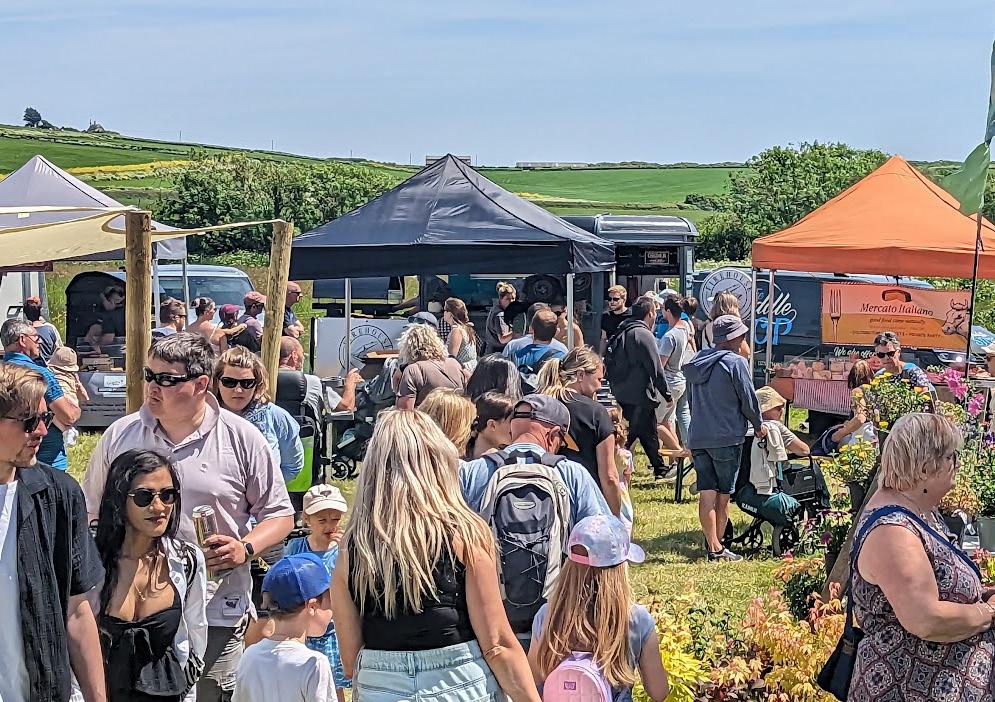
Shaftesbury has a long tradition of food events, festivals, fairs and eccentric competitions – and this year sees the launch of a new annual celebration, Feastival, on Sunday 5th May, from 10am to 5pm on the High Street and Park Walk. Combining food stalls, an artisan market, foraging walks, hot food, cookery demonstrations and the infamous Gold Hill Cheese Run (that’s UP the steep cobbled hill), it has something for everyone and, like the Dorset Food and Arts Festival, entry is free –so you have no excuse not to spend lots of money! For more on Shaftesbury Feastival see the feature from the April issue of The BV
This year’s Royal Bath & West Show runs from 30th May to the 1st June. Each day you can watch a cocktail masterclass, and foodies should definitely make the most of the free cooking demos as the celebrity chef guests will be cooking up a storm in the Great British Kitchen. For years, food lovers have been coming to the show to enjoy the artisan delights they can find in the food tent. As always there will be plenty of street food vendors dotted around the showground, including the Pilton tent, and on the main lawn – ideal locations to sit, eat and enjoy the entertainment.
The re-scheduled Spring Countryside Show is now to take place on 8th and 9th June at Turnpike Showground near Gillingham. It will focus on offering food from the South West, and you will find venison burgers and rare breed sausage rolls. For those into gin or cheese, artisan makers will be showcasing their produce ... and who doesn’t want to ‘sample’ a brownie or a doughnut? You’ll also be able to have a go at crafting, meet heavy horses, delight in a madcap clown stunt show and learn about heritage steam engines …
Some of the other major events in May and June are Gate to Plate at Axminster on 27th May, Christchurch Food Festival on 25th to 27th May, Bridport Food Festival on 14th and 15th June and Swanage Fish Festival on 15th and 16th June.

This simple recipe is perfect for family get togethers, and is so forgiving, endlessly adaptable to include what you fancy or have in the cupboard. This is my personal favourite combination and I think they really complement each other, with the dried cherries balancing the sweetness with a hit of sour. I’ve also found that people love the nostalgia of adding Rolos on the top! But change it to suit: maybe you prefer raisins to cherries, you’d like to use a different biscuit, or you’d enjoy nuts instead. Just keep the ratios of ingredients the same, and substitute with your own favourites. I used to be able to buy dried sour cherries from supermarkets quite easily but they seem to be harder to find (they’ll either be in the baking or the health food section). Waitrose has been reliable so far, but any good health food shop should be able to help you too.
Makes about 12-15 squares
• 500g dark chocolate
• 200g butter
• 300g golden syrup
• 100g dried cherries
• 100g mini marshmallows
• 1 small packet of digestive biscuits
• 2-3 packets of Rolos.
1. Line a 9” x 13” (20cm x 30cm) cake pan and put to one side.
2. In a large saucepan, gently heat together the butter, chocolate and golden syrup until completely melted and combined.
3. Break the biscuits into pieces and add them to the chocolatey mixture, along with the cherries and marshmallows. If you would prefer a less biscuity mixture, just stir in slightly fewer biscuits. Stir really well to combine and make sure all pieces are completely coated in the chocolatey mixture.
4. Pour this mixture into the prepared cake pan and smooth out the top.
5. Scatter the Rolos over the top of the mixture and place the cake pan in the fridge to set (about two hours).
6. Once set, cut into squares or slices to serve

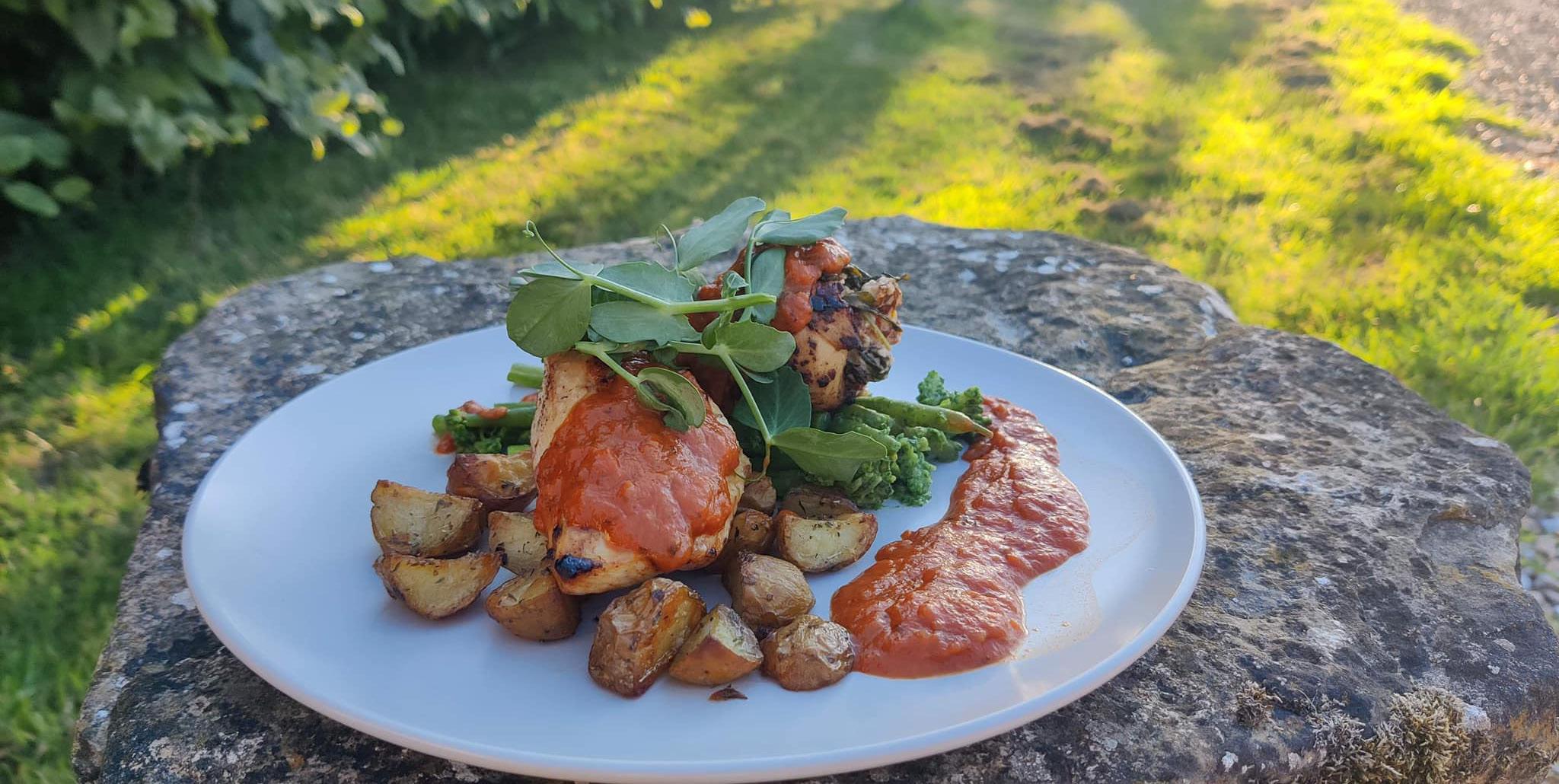
Editor Laura tried the seasonal pop-up which transforms a family home into a sociable culinary destination with Alex Woodhouse at the helm
In 2021, COVID was still rife and the hospitality industry was both tough and highly risky. But Alex Woodhouse was a keen young chef with an ambition to open his own restaurant. A family brain-storming session led to the first season of Supper at

Pleck. It was such an instant hit that this May, the popular popup restaurant comes back for a fourth year, still in Alex’s family home and ’20-year renovation project,’ Pleck Barn. With few overheads, hosting the pop-up in the family’s dining room (the double-height threshing space in the barn) was initially a relatively risk-free first foray into the business. It remains one of their selling points.
Alex has created a destination restaurant with a special atmosphere, providing fine food in a uniquely fun and informal setting, where first time guests are greeted like old friends, and leave feeling as though they have become just that.
A small menu by choice
‘We wanted to create a deeply relaxed dining experience in a beautiful setting,’ says Claire Hundley, Alex’s mother who works front of house for the Supper at Pleck evenings. ‘As the food is sourced, cooked and
served within a 24 hour window, we only offer a small selection of menu choices, usually two per course plus a vegetarian option. And he asks guests to pre order –that means there is no wastage. Alex buys exactly what he needs.’ The cost is £30 per head for a three-course supper, and there are three menus a year, changing every six weeks as Alex reflects local seasonal produce in the menu choices.
He specialises in good quality cuts of meat with well reduced, deeply flavoured sauces. But it’s apprently common for veggie and vegan guests to say theirs was the best they’ve ever tasted! Last autumn, the menu included a chicory and roquefort salad starter which was crisp and fresh, the Roquefort balanced by a deliciously acidic dressing with bursts of sweet grape.
The cod fillet, with an olive, caper and cherry tomato sauce, was meltingly soft and meaty, beautifully cooked with a thick herb crumb, while the sauce was
richly sweet and surprisingly light. The pan-fried chicken breast with a creamy tarragon, chorizo and white wine sauce was moist and buttery soft, with a light sauce full of flavour. The delicious dark chocolate and pecan tart was light and delicate, a delightful finale.
‘I’m completely committed to the “bring your own drinks” idea,’ Alex says. ‘One of the pleasures of eating out is drinking good wine while being cooked for –but it has become increasingly expensive, sometimes as much as 50 per cent of the total cost of the meal. So whether you want cheap plonk or high quality claret, you can buy it at supermarket prices and pair it with your menu choices. We provide plenty of glasses of all types, as well as the ice and lemon!’
Supper at Pleck Barn is faintly reminiscent of a big family get-together, with guests seated on mismatched furniture and garden chairs, wide barn doors opened wide to enjoy the incredible view across the valley from the garden. On warm summer evenings, the tables are outside in the garden itself – ‘We decide about 4pm whether the weather will be kind to us,’ says
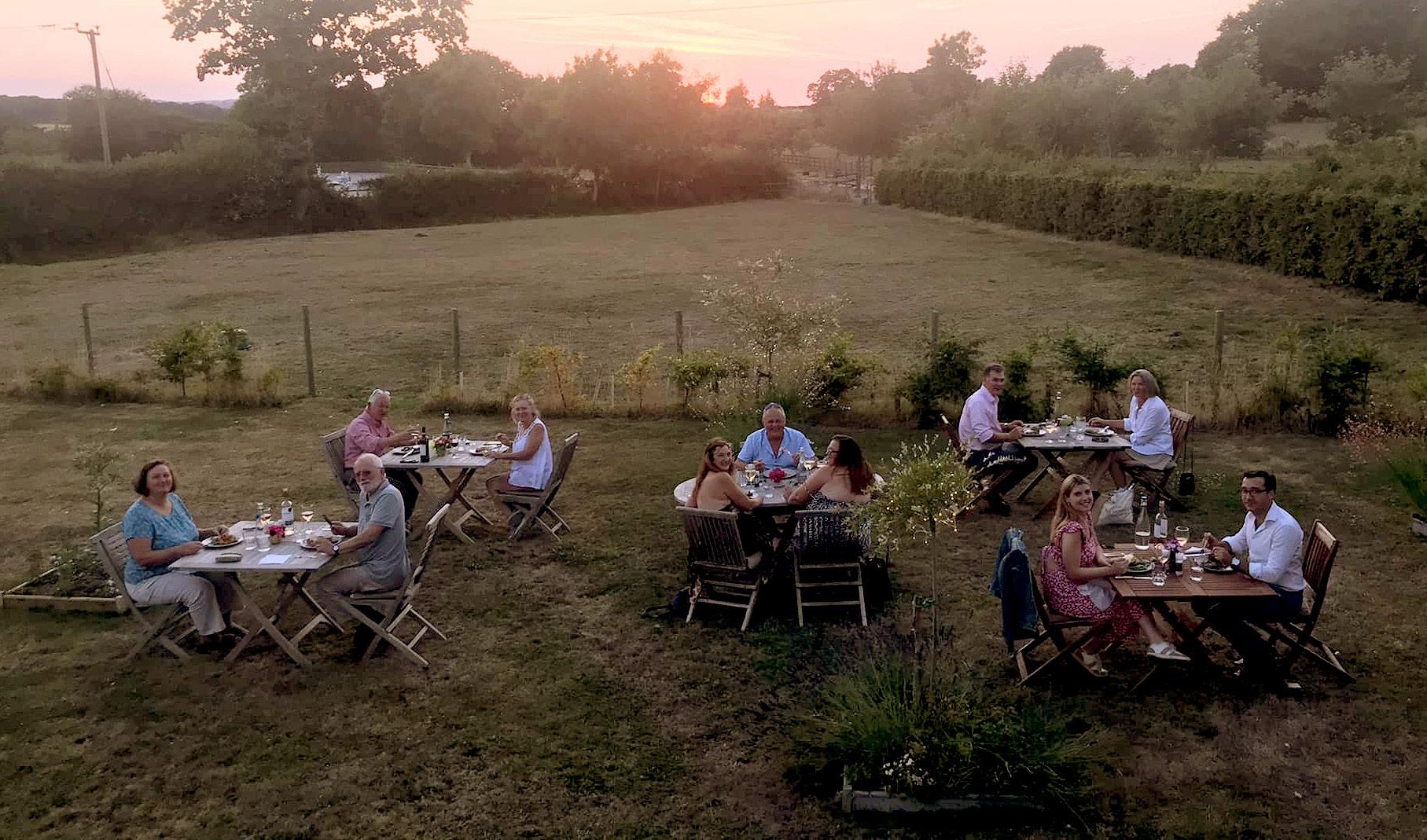
The cod fillet was meltingly soft with a thick herb crumb, the olive, caper and cherry tomato sauce rich, sweet yet surprisingly light
Alex. ‘And an informal sociable atmosphere is encouraged. We only have one sittingand guests are all requested to keep to our “7 for 7.30pm” rule, so there is time to mingle on the lawn and enjoy the garden. Coffee and tea at the end of the meal is self-service, and guests are free to mingle and chat when they have finished dining at their individual tables.
‘This year we will be trying a monthly Sunday lunch special, too. Each will be differently themed, and current plans include a crayfish boil, a marinated meats barbecue and a hoggett Sunday, all with canapé starters and delicious puds,

served on long tables which can seat 20 to 25 people.
‘Where else can you sit with that view, with a private chef-cooked meal, and still afford to drink champagne with it if you wish?’
• The spring menu has just been published – you can see it on the Supper at Pleck Facebook page, or by email pleckbarn@gmail.com

cool or damp evenings

Visiting one of Dorset’s best jam and marmalade producers, Rachael Rowe discovers that A Jar Of’s cookery courses are just as inspirational
The conversation was already flowing as I walked into The Jammery – a converted cowshed at Droop Farm, and headquarters of AJar Of. Founder Tracey Collin’s popular jams and chutneys are a feature in farm shops all over Dorset, but I’m here for the Picnic Season Workshop. Before I’ve even taken a bite of the more-ish homemade oat biscuits, the tips are coming at me thick and fast. The chat
varies from how to find recipes with a useful cookery book app, the difference between a jam and other preserves, to why Black Garlic Ketchup is divine with chips. I’m here to enjoy a day of cookery – to learn about making jam and chutney but Tracey is just as keen to teach how to include them in other recipes: ‘There’s more to jam and chutney than just sticking it on your toast!’
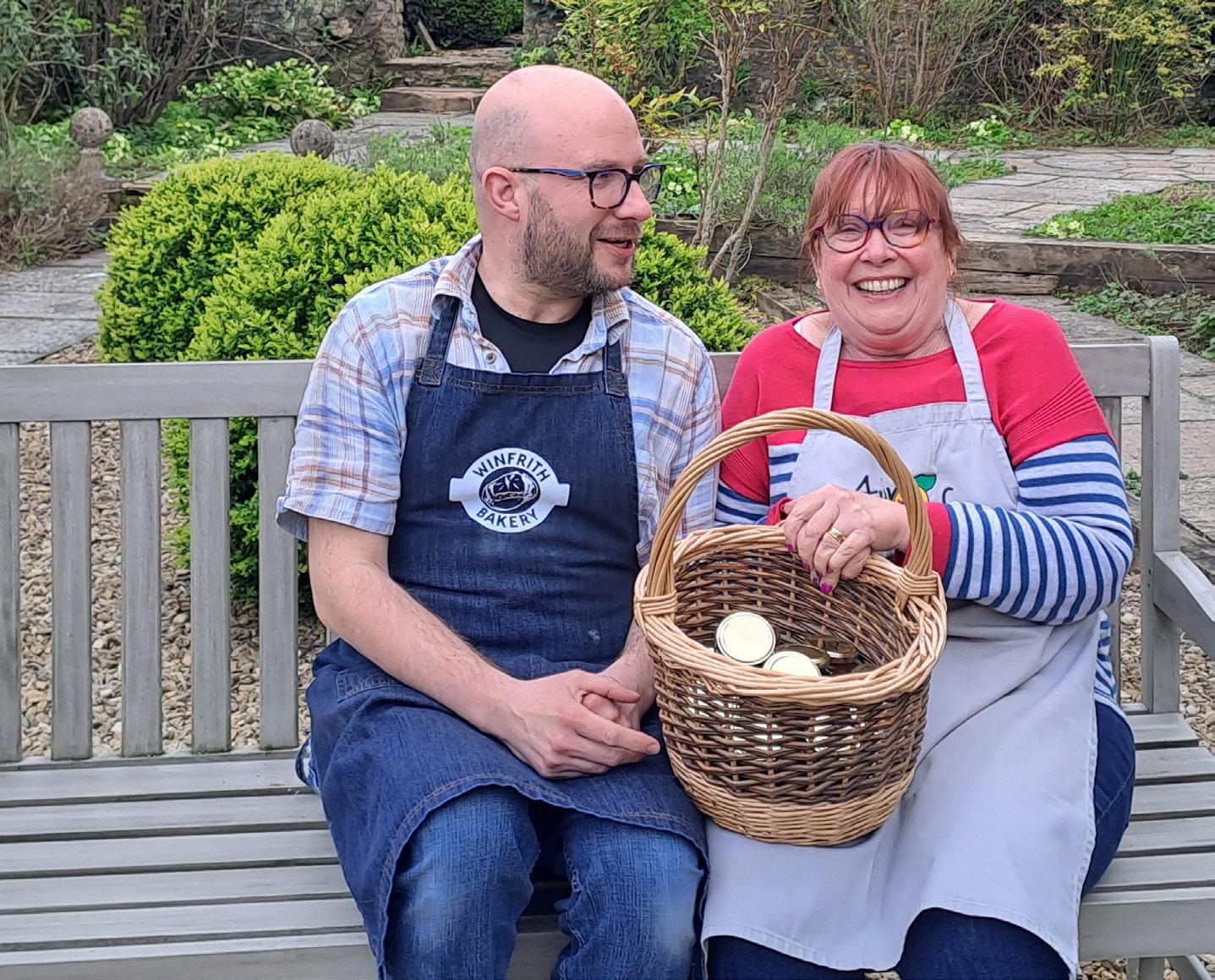
A full recipe list
Tracey and Matt Whiting from Winfrith Bakery run regular workshops at The Jammery. She naturally teaches the jams and chutneys section of the day, while Matt’s expertise is in the baked goods – which always incorporate a preserve into the recipe. The plan for the daylong picnic workshop includes jumbleberry jam, a spicy tomato, apple and tamarind chutney, hand raised pork pies and egg custard tarts.
As you would expect with a chutney making session, we start the day with a LOT of chopping. Safe knife techniques are essential, and, never one to miss a teaching moment, Tracey demonstrates how to chop an onion so it doesn’t make you cry – or lose a finger – and how to smash a garlic clove. It’s at classes like this you learn easier and better ways of doing things. Tracey has been making and selling jams and chutneys for 13 years: ‘I started by making cakes and selling them in a local farmers market in Beaconsfield. One day I took 63 jars of jam and I was left with a handful.
I thought: “Well, that’s OK.”
My husband, who has an accountancy background, was even more impressed because he saw there was no waste. ‘When it came to choosing a business name, we went to the pub to discuss it, as you do. My friend said, “Look, it can’t be that hard. For goodness’ sake, it’s a jar of...” and the rest is history. She’s been claiming royalties ever since!’
As the chutney simmered away, Matt took charge with a sweet pastry making session, using a delayed shortcrust technique to keep the pastry tender. Gluten forms as soon as liquid comes into contact with flour, and this technique delays the gluten formation, involving mixing the butter, sugar and half the flour, followed by the eggs and then the remaining flour. I had to confess it was my first time making pastry from scratch – I expected to get a cone of shame to wear, but Matt just raised an eyebrow with a bemused look. I was soon amazed at how simple and quick it was to produce a decent looking pastry. What a confidence boost!
Chutney making in The Jammery with Tracey Collins of Ajar of

Of course, the expert tuition and supportive environment was a major factor in my success.
I drove home in a warm and fragrant car laden with food –and a mountain of inspiration to cook more
Servings of the hand-raised pork pie and delicious custard tarts filled the table for lunch, and as we chatted over the food I discovered both my fellow students were return attendees. ‘People tend to come back,’ says Tracey. ‘It’s the cooking, but also the atmosphere, it’s so relaxed.’ Richard is obviously passionate about cooking and always enjoys a day in the kitchen: ‘Some people relax with a yoga session or have a long bath,’ he says. ‘Me, I love a

Rachael’s first ever pastry, made into delicious egg custard tarts
day of cooking.’
Time passed by in a swift blur as we made jumbleberry jam with a mixture of soft fruits, constantly absorbing tips and techniques for better cooking. Then another pastry session, this time making a hot water crust pastry for the (proper) pork pies, learning how to hand raise them before filling them with meat and a decent dollop of chutney. Finally, it was time to fill those egg custard tart cases with an extra dose of jam at the base before baking them. I drove home in a warm and fragrant car laden with food –and a mountain of inspiration to cook more. Funnily enough my partner couldn’t wait to help me unload the boxes –or tuck into my pork pie.
Taking part in a cookery workshop at Ajar Of is a relaxed and practical way to learn how to incorporate chutneys and jams into recipes, and also to avoid food waste. My own pastry making really showed me that we live in a convenience world where ready-made is all too easy. Time spent learning to cook recipes from scratch is not only good for life skills, it provides valuable space for reflection and shows us how easy it is to reduce our consumption of ultra-processed foods simply by planning a batch cooking session.
• The next course in June has a strawberry and lemon theme
• ajar-of.co.uk

It’s a slice of wellness in the Dorset downs: Rachael Rowe talks to the sibling duo who have crafted a culinary haven of hearty whole foods
Tucked away in the heart of the Dorset downs at Godmanstone, Feed the Soul is a place where people are passionate about whole foods. It’s a well-kept secret – those in the know have usually found it via another friend’s social media post raving about the wonderful salads. The small cafe south of Cerne Abbas on the A352 is a “chilled out haven of healthy food” run by brother and sister Alex and Nick Beer.
‘I was a trained chef, and Nick and I had both worked in hospitality for years,’ says Alex. ‘One day we just thought “we can do this ourselves!”
Nick was working in a coffee shop in Dorchester at the time, learning to roast coffee beans. I’d returned from Australia, and had a cake stall at
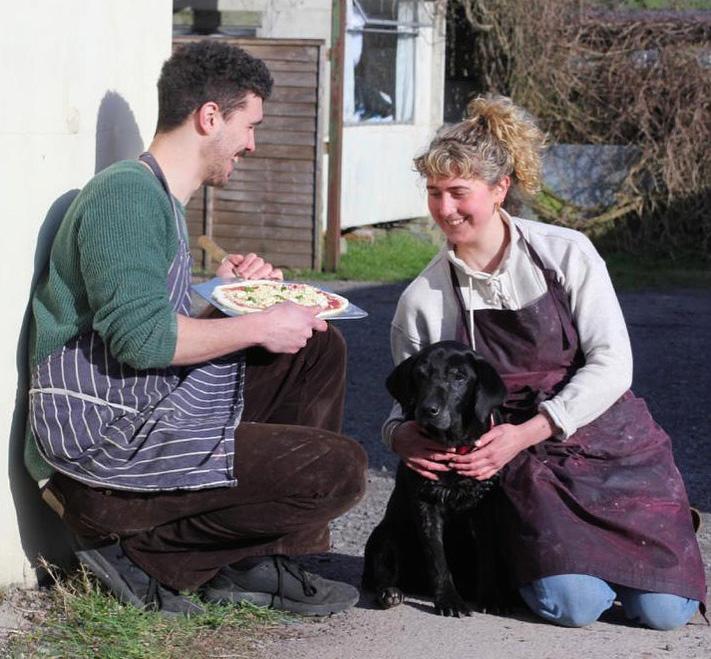
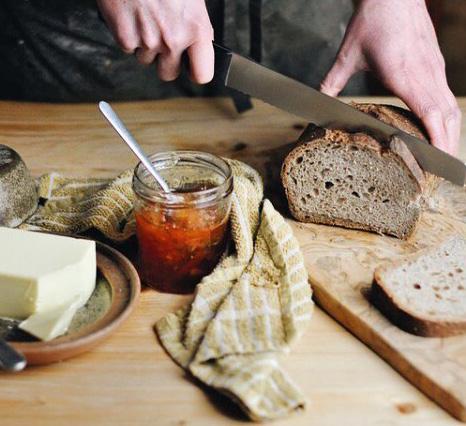
local markets. We had always shopped here at Longmeadow when they had organic fruits and vegetables, so when the cafe came up for rent, of course we were interested.
‘I was 25 at the time, and Nick was 23. It’s a fun location, and we thought: “if we don’t do it now then we never will.” So we took the plunge – that was seven years ago! We started out with a vegan approach, but we have broadened that to simple whole foods and now include eggs and cheese too. We’re both incredibly passionate about organic and whole foods in a healthy diet.
‘In Australia, the whole food scene is really big –Bondai Beach is health food central. I totally got into it, but when I came home there’s just not that
same emphasis here in Dorset.’
Building a community
The eclectic team at Feed the Soul all have other jobs too, Alex says. ‘There’s seven of us altogether – the two of us plus Josh, Nick, May, Lily and Jo, and we’re all really good friends. Everyone has their own business too, and works here part time. May upcycles clothing, for example, and Lily is a market gardener working with her mother.
‘We used to grow all our own food, but as we got busier it was harder to manage everything – and I’ve recently had a baby. Motherhood keeps me very busy! So we’ve stopped growing our own, and instead use suppliers like Lily at Edible Acre and also Riverford Organics.
‘Our bestsellers in the cafe are probably the avocado on toast with homemade sourdough and cashew aioli. We also make kombuchas. Another popular dish is the gluten-free kimchi pancake. We have daily fresh seasonal salad bowls. If you were visiting for the first time I’d definitely recommend a Buddha bowl, every time. Plus one of Nick’s shrubs – delicious and so refreshing.’
A shrub is a traditional sparkling cordial. The method dates back to the 17th century and involves infusing a cider vinegar syrup with fruits, sugar and sparkling water.
‘We’re hard workers,’ says Alex. ‘People have called us workaholics. But we love it. You never know how a day will be here – each one is so different. We make everything from scratch, from the peanut butter and the aioli to our own granola. And there’s a health food shop here as well as the cafe.
‘‘I think we have such amazingly loyal customers. Even through COVID we managed to stay open because of our local customer base. It’s a brilliant, friendly community and we’ve made a little haven where people feel safe and happy.


Regular events such as this Indian Night are held at Feed the Soul throughout the year
‘We’re very laid-back, but we’re always thinking about the business. I’ve been out of it for a few months because of the baby, but we’re planning for the summer to be fun! We cater for yoga retreats and I’ll be back teaching yoga soon. And we run workshops, including fermentation. ‘It is all about getting people to slow down – this place does that I think. When you are here, the sense of time just melts away.’
• Feed the Soul is open Tuesday to Saturday, from 10am to 4pm at Longmeadow in Godmanstone, DT2 7AE.
• feedthesoul.co.uk

‘If you are visiting for the first time I’d definitely recommend a Buddha bowl’
 Parrot tulips are not a species but a group of cultivars with the name Tulipa Parrot Group – they are the result of natural mutations to single late tulips and triumph tulips caused by the tulip breaking virus.
Images: Charlotte Tombs
Parrot tulips are not a species but a group of cultivars with the name Tulipa Parrot Group – they are the result of natural mutations to single late tulips and triumph tulips caused by the tulip breaking virus.
Images: Charlotte Tombs
Gardening has its own large vocabulary, and when you first encounter it, it can feel intimidating, says Charlotte Tombs
Why do most jobs come with their own vocabulary? Wherever you work, you will inevitably encounter a whole new language, with abbreviations and acronyms for things you have no clue about. Slowly all becomes clear as you learn the ropes. I thought it would be fun to compile a basic gardening vocab cheat sheet of the odder words –you hear so many of these being flung about and I wasn’t sure of some myself. Hopefully I can clear some up for you:
Amending: Adding organic matter or other substances to soil to improve its structure, fertility, or drainage.
Biennial: Plants with a two-year life cycle, typically producing foliage the first year and flowers and seeds the second year.
Bolting: Premature flowering and seed production in plants, often caused by stress or environmental factors, usually making them unusable.
Cold stratification: A process of exposing seeds to cold, moist conditions to break dormancy and stimulate germination – home growers do this with a kitchen fridge.
Companion planting: Growing different plants together, including for pest control or nutrient enhancement; planting garlic among roses or chives among chrysanths to deter aphids.
Damping off: Fungal disease affecting seedlings, causing them to wilt and die at soil level.
Direct Sowing: Planting seeds directly into the ground rather than starting them indoors.
Espalier: Training plants to grow flat against a wall or trellis in a specific pattern.
Foliar Feeding: Applying fertiliser directly to plant leaves for rapid nutrient absorption.
Green manure: Cover crops grown and then tilled back into the soil to improve fertility and structure.
Half-Hardy Annual: Plants that are able to withstand light frost and cooler temperatures but may require protection during the harshest weather conditions.
Hardening off: Gradually acclimatising indoor or greenhouse-grown plants to outdoor conditions before transplanting.
Hardy annual: Plants that complete their life cycle within one growing season, withstanding frost and cold temperatures.
Hardscape: Non-living elements in a garden, such as paths, patios and walls, that provide structure and functionality.
Hybrid: A plant variety resulting from the

crossbreeding of two different parent plants, often selected for specific traits.
Marcescence: The retention of dead leaves on trees and shrubs throughout the winter – think beech hedges.
Mulch: Material spread over the soil surface to retain moisture, suppress weeds and regulate soil temperature.
Overwintering: Protecting plants from cold temperatures to ensure their survival until spring.
Perennial: Plants that live for more than two years, regrowing each spring from the same root system.
pH Level: A measure of the acidity or alkalinity of the soil, affecting nutrient availability to plants.
Pricking out: Transferring seedlings from a densely sown container to individual pots to allow for proper growth and development.
Propagation: The process of creating new plants from seeds, cuttings or other plant parts.
Rejuvenation pruning: Severe pruning to remove old or diseased growth and stimulate new, vigorous growth.
Sucker: Shoots that grow from the base or roots of plants, often removed to prevent overcrowding or maintain desired growth.
Thinning: Removing excess seedlings or plants to provide adequate space for healthy growth.
Underplanting: Planting low-growing or shadetolerant plants beneath taller plants to maximize space and visual interest.
See Charlotte’s Insta here to see what she’s picking at the farm near Wimborne (contact her via northcombe.co.uk), or try flowersfromthefarm to find a flower grower near you


Despite the wet ground, there’s been a lot to do on the allotment, and plenty has been achieved this month, says Barry Cuff
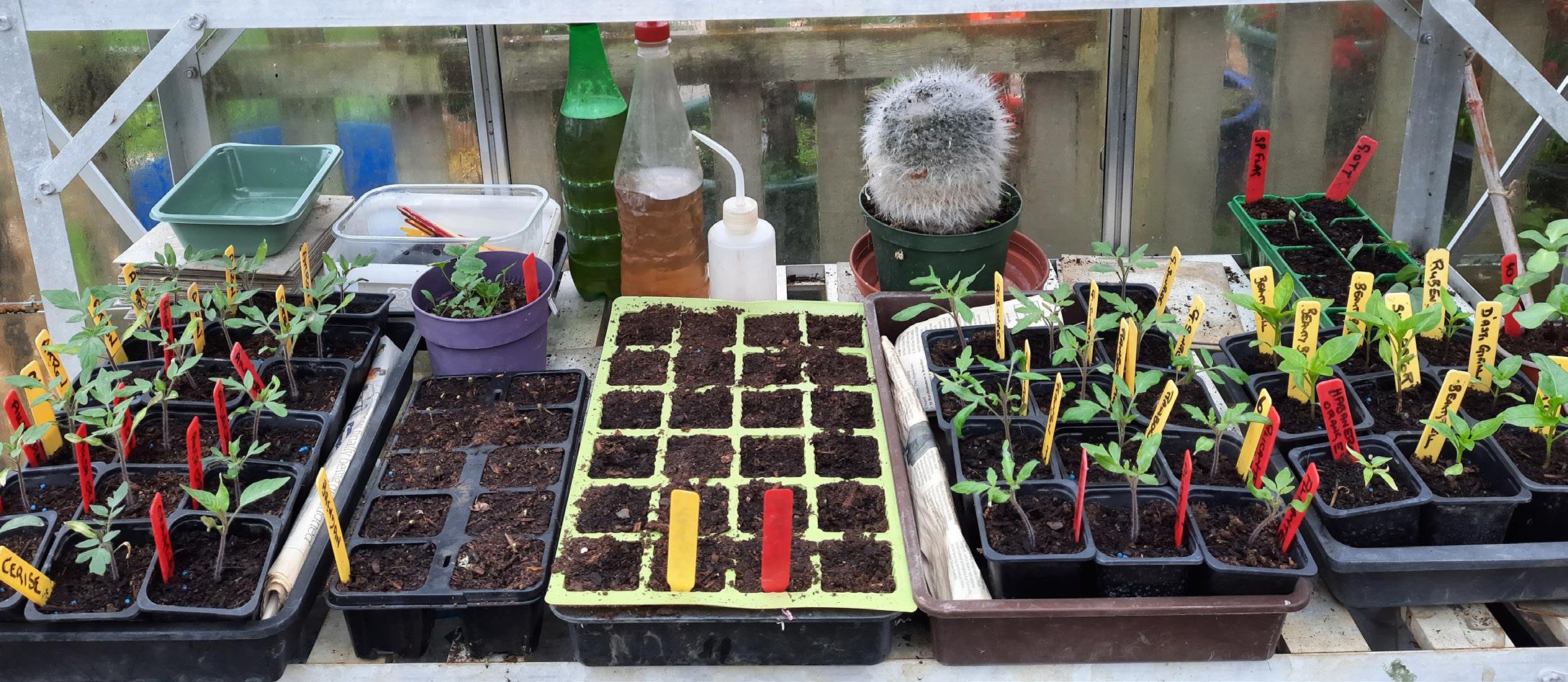
On the last day of March, a line each of Maris Bard and Jazzy potatoes were planted, only possible by working from the path as soil was very wet.
April
1st – Collected leeks and purple sprouting broccoli
2nd – Plug tray of Little Gem lettuce placed outside to harden
5th – Cut spicy salad leaves and pea seedlings for salads (trays in greenhouse)
7th – Planted line of Charlotte potatoes
8th – Sowed plug tray of Brendan Brussels sprouts, planted out lettuce under cloche, sowed patch of radish. Pulled sticks of rhubarb for the kitchen.
Sowed a plug tray of Neon celeriac and two plug trays of Golden Self Blanching celery. Planted six lines of potatoes – Sagitta, Caledonian Rose, Caledonian Pearl, Jazzy and Desiree (made possible by standing on scaffolding boards to avoid soil compaction)
9th – Dug more ground for more potatoes. It dug well, despite being fairly wet
10th – Removed all of last year’s brassicas. The last of the broccoli plants were covered with snails
11th – The forecast finally looks good, with no rain for at least 10 days but still some cold nights. Planted two lines of Desiree, and noted the Conference pear is in full flower
12th – Pumped water on site, mainly to check the
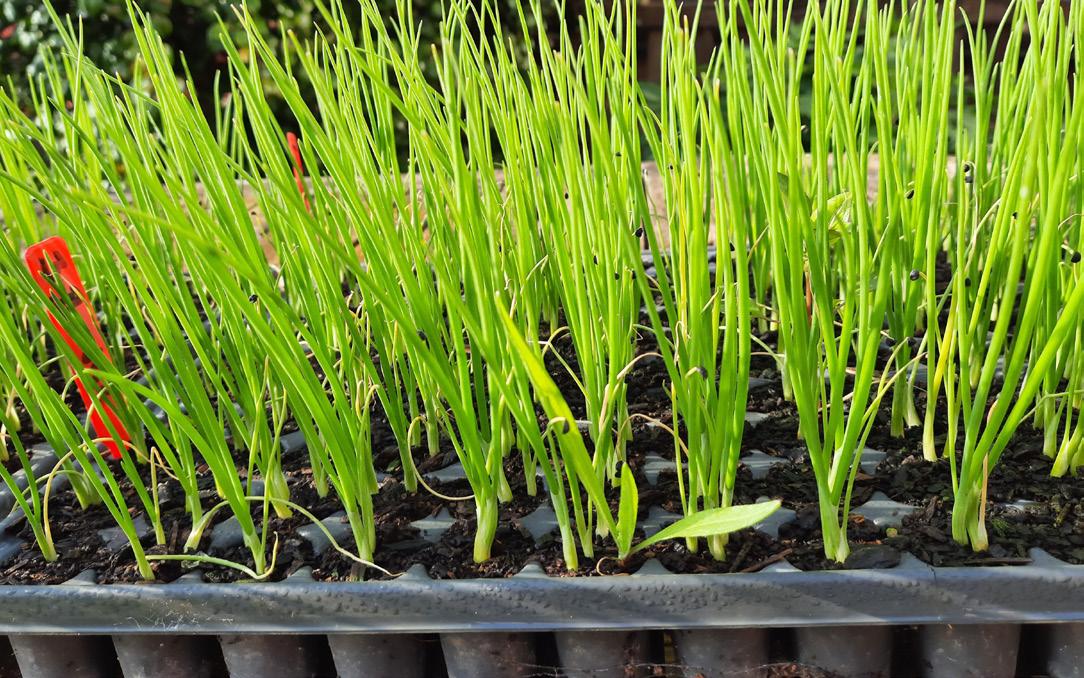
pump as it was last used in September! Planted four rows of Picasso potatoes
14th – Cut the hedge: a mixture of hazel, blackthorn, hawthorn, elder, snowberry, ivy, blackberry and dog-rose. This hedge is on our northern boundary and gives protection from cold winds.
15th – Planted out a line of Red Drumhead cabbage and covered with cloches to protect from pigeons. Pulled more rhubarb.
16th – Sowed two 3-litre pots of Musselburgh leeks. Weeded strawberry bed – the early varieties are in full flower. Broad beans also have their first two sets of flowers.
17th – Sowed part lines of Early Nantes carrot and Boltardy beetroot. Potted up sweet peppers in the greenhouse.

18th – Dug the ground for onions and parsnips. 19th – Tidied the mint area which has spread during the wet winter. Covered the skulkers* with pots and the strawberry bed with fleece to protect from the forecast frosts
20th – Potted up tomatoes in both greenhouses (we have 14 varieties)
21st – Broke down the large soil lumps on the onion and parsnip plot
24th – Planted out four lines of onions from plug trays: about 40 stations per row, with one to three seedlings per station. Have planted Bonus and a few Red Brunswick
25th – Dug out the weeds in the fruit bush area – mostly grass weeds, with some willowherb and bindweed. Planted a line of strawberries from pots (some of last year’s runners).
Depending on the weather, at the time of writing, we hope to sow two lines of peas by 30th April
* Skulkers – a Dorset term for ‘volunteer’ potatoes accidentally left in the ground from the previous year.


One of the easiest and best ways to encourage wildlife in your garden is to leave a patch of lawn to its own devices, says Pete Harcom
I have been thinking about the ‘No Mow May’ campaign that was started in 2019 by the conservation charity ‘Plantlife’. Perhaps we should all consider this again. How about not mowing our lawns for at least the month of May? Apparently we have lost almost 97 per cent of our flower-rich meadows since the 1930s – and with them we have lost the food needed by pollinators such as bees, moths and butterflies. If your lawn is left to grow and set seed, it produces wildflowers, plants and fungi which all benefit your local wildlife. And all we have to do is NOT mow. Or at least, reduce our mowing from May onwards. If you do need to mow, try leaving a large area unmown – that will still help. Longer grass and wildflowers support a variety of insects such as beetles, spiders and grasshoppers. These insects are an important food source for many birds and other animals, and they also help to pollinate plants and break down organic matter in the soil. The only downside for a gardener may be that weed growth can establish if the grass is not mown for an extended period, so monitor and remove individual weeds if they start getting established.
• May should be a lot warmer, but keep an eye on the weather forecast – you may need to wait to plant out bedding plants until the end of the month to guarantee the warmth.
• Sweet peas can be sown direct into the ground during May – and if you sowed into pots a few months ago, it’s time to plant out your sweet pea seedlings during a mild spell.
• Divide clumps of hosta plants as they come into their new growth.
• Trim back aubretia after flowering to encourage
compact growth and repeat flowering.
• Prune penstemons now – cut back all the old shoots to the base.
• If fuchsias and pelargoniums are growing well, take cuttings now to increase them.
• Look out for signs of blackspot on roses. Blackspot is a fungus that presents as round, irregular black spots on the leaves and canes of roses. If discovered, and you wish to avoid using a systemic fungicide, pluck and dispose of the leaves, and try to keep the ground clear of dropped leaves where the fungus can thrive.
• Prune spring-flowering shrubs – such as deutzia, choisya, weigela and philadelphus –after flowering to maintain shape.
• Birds are starting to nest now – please check hedges before trimming them back. It’s possibly best to accept you missed your chance, and to leave the hedges until late summer now.

Even leaving part of the garden unmowed can help your local wildlife

Dorset Chamber CEO Ian Girling encourages local enterprises to shine at the 2024 Dorset Business Awards, and it as a platform for success
This month I’d like to take a minute to talk about the 2024 Dorset Business Awards – they were launched in Dorchester in April, and are open for entries from 1st May to 13th June. The awards are free to enter and open to all businesses in Dorset. The aim is to celebrate the excellence and achievements of Dorset businesses across a wide range of categories. Now in their 27th year, they are widely recognised as one of the leading business awards in the South.
Entering the awards offers a huge range of benefits to any business. Firstly, at its core it’s an extremely useful exercise to go through the application and to self-assess what you are doing well in that particular category –and also what you could improve or build on in that particular area of your business. This in itself is a very useful self-improvement exercise for any business. If you make the shortlist, being a finalist is incredibly exciting for your business and motivational for your team. Just being shortlisted means you and your team should be very proud of your achievements – this can

have an extremely positive effect on morale (even more so if you win!). You’ll feel an incredible feelgood factor in your business. One of the most obvious benefits of being selected as a finalist –and of winning – is the amount of free marketing and PR you will receive for your business. Within the Dorset Business Awards, we promote the finalists in advance of the awards night across our social media channels, and winners can expect to be heavily covered in the local business media – including our own business magazine. Winning, or even being a finalist for an award, builds credibility and trust in your brand. The award recognises your
Ian Girling at the 2023 Dorset Business Awards
achievements in that particular category, and can only improve your business reputation. This in itself is likely to improve customer retention as well as bring in new business.
The Dorset Business Awards are independently judged by a panel of business leaders from within Dorset, and the entry process is very straightforward. Entries are open now – my top tip is to always follow the guidance, and don’t leave it too late to start your entry! The awards Gala Dinner and Presentation will be on 10th October.
What are you waiting for?
• dorsetchamber.co.uk

Wessex Internet has secured a significant new government contract worth £33.5 million to expand ultrafast broadband access to 21,400 homes and businesses in rural South and West Dorset, and South Somerset. This initiative is part of Project Gigabit, the government’s £5 billion effort to enhance digital infrastructure in the UK’s most remote areas, ensuring they aren’t left behind in the rapidly advancing digital age.
This latest contract marks the fourth and largest Project Gigabit agreement awarded to Wessex Internet, emphasising their growing role in national efforts to improve connectivity. It follows closely on the heels of another major project announced in March, where the provider committed to an £18.8 million broadband rollout in South Wiltshire.
Digital Infrastructure Minister Julia Lopez highlighted the critical need for updating the UK’s digital infrastructure, stating, ‘Outdated infrastructure restricts economic growth and reduces quality of life. Our Project Gigabit initiative aims to equip rural areas with state-of-the-art connections, allowing them to thrive in the digital economy.’
Hector Gibson Fleming, CEO of Wessex Internet, expressed the company’s commitment to enhancing rural connectivity. ‘Since our first installations in 2012, our mission has been clear—to ensure rural communities are not disadvantaged by outdated technology. This new project allows us to expand our network organically while maintaining the local, customer-focused service that defines us.’
The planned network expansion will commence

Map showing the new areas to be covered by the latest contract
construction in late 2024, targeting rural areas around Swanage, Isle of Purbeck, Dorchester, Sherborne, Beaminster in Dorset, and areas near Crewkerne, Ilminster, Glastonbury, Shepton Mallet, and Bruton in South Somerset. The project will implement full fibre, or Fibre to the Premise (FTTP) connections, offering speeds up to 10Gbps – significantly faster and more reliable than the older copper wiring systems. The above map shows the new areas covered by the latest contract. Much of rural Dorset is already covered by Wessex Internet (or built in to future plans). Those keen to take advantage of the high speed access, the best advice is to use the postcode checker on the Wessex Internet website, which will show access plans for individual properties.
• wessexinternet.com
Nadder Valley Animal Rehabilitation, based in Dinton, provides specialised treatment for pets with mobility issues. Originally known as Pet Waves, the centre was rebranded following its acquisition by Tori Edwards and Hannah Topping, both trained veterinary physiotherapists who met during their degree studies. The duo saw potential in the already successful enterprise to enhance and expand its services. Under their guidance, Nadder Valley Animal Rehabilitation has flourished, offering comprehensive rehabilitation care that includes hydrotherapy in a pool and on an underwater treadmill, therapeutic laser treatments, ultrasound and more. Their efforts have resonated within the community, leading to a nomination for an industry award less than a year after establishing the new brand, reaching the finals of the prestigious Animal Star Awards as Animal Therapist’s of the year for the southern region. The centre’s commitment to quality care and customer satisfaction has strengthened its reputation
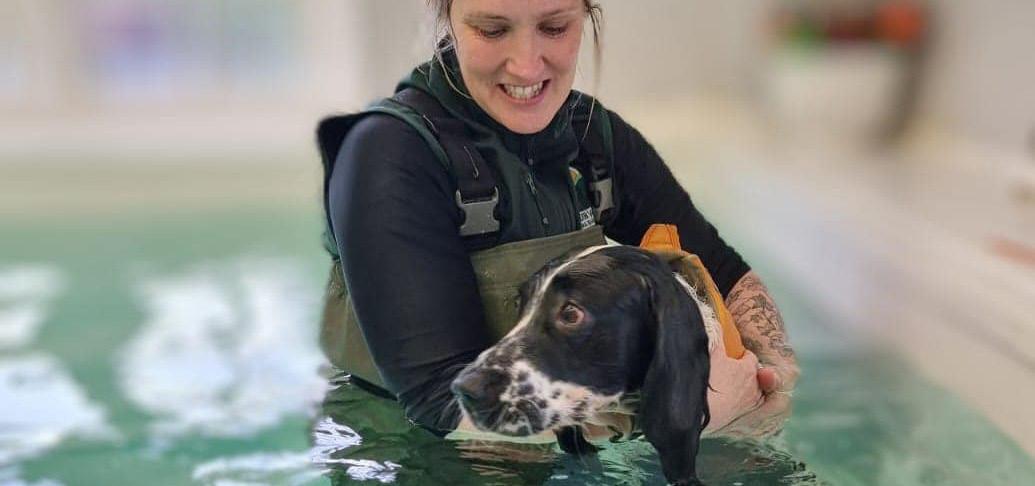
among pet owners, helping their canine companions return to active, happy lives.
Looking ahead, Tori and Hannah are excited about the future, with plans to expand their service offerings and continue supporting more animals through their recovery journeys in 2024 and beyond. Their mission remains focused on providing tailor-made care that addresses the unique needs of each pet, ensuring optimal outcomes for all their patients.
• NadderValleyRehab.co.uk
Rose Engineering, a familyowned construction company based in North Dorset, recently clinched the prestigious title of Construction & Engineering Family Business of the Year 2024 at the Business Awards UK. Renowned for their robust family values and commitment to quality, Rose Engineering distinguished themselves among numerous entries from across the UK, many from significantly larger companies.
Business Awards UK commended Rose Engineering, highlighting that their success is ‘a testament to the power of family values and a shared commitment to quality.’ These principles have not only earned them award recognition but have anchored the company’s operational ethos since its founding by Mervyn and Sue Rose. Today, the company is spearheaded by their son, Tom Rose, who continues to drive the company’s commitment to excellence and flexible customer service. Tom expressed pride in their recent accolade, stating, ‘We are very proud to have won another national award. It’s a fantastic start to 2024 and celebrates the hard work of our

teams who strive to be the best in our industry. We’re excited for the upcoming projects this year.’
With over 38 years of experience, Rose Engineering specialises in a variety of construction across the south west, including agricultural and industrial structures. Their skilled teams manage projects from design to completion, ensuring high standards of quality and customer satisfaction.
Anita Beaumont, Finance & Marketing Manager, remarked on the significance of their national recognition, ‘Being a small family-run company and winning
such awards demonstrates our capability to create outstanding structures and deliver awardwinning service.’
The Business Awards UK described the 2024 awards as a spotlight on the industry’s future, ‘illuminating the landscape of British construction and engineering.’ They praised awardees like Rose Engineering for not just building structures but for shaping a more innovative, sustainable, and customer-focused future for the construction and engineering sectors.
• rose-engineering.co.uk
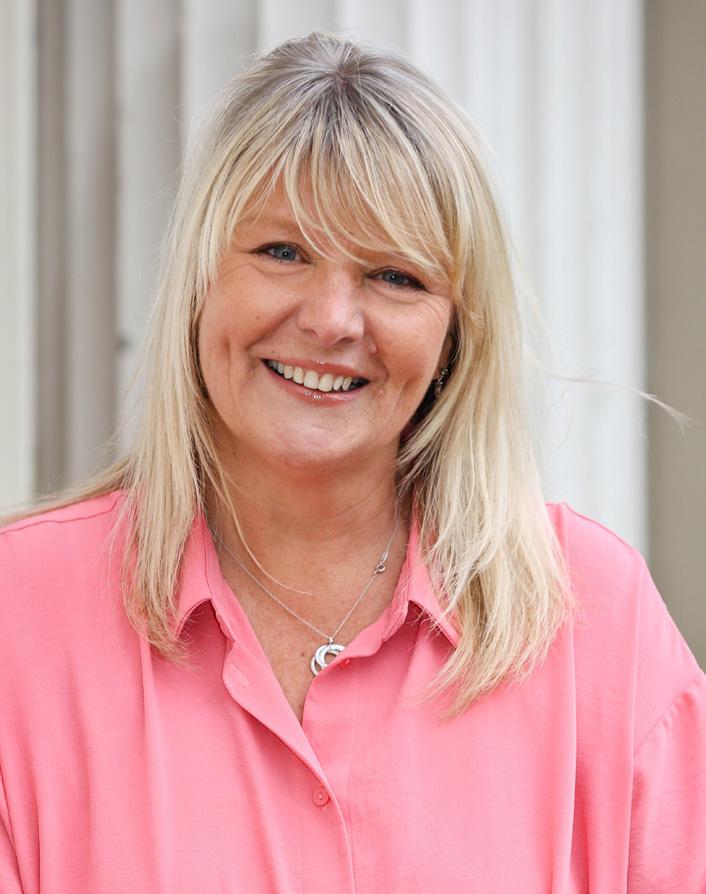
Wimborne Minster has proudly maintained its status as a Fairtrade town, reflecting the dedication of the local business community to promote ethical trade practices and support global sustainability.
John Spatchet, Chair of the Wimborne and Colehill Fairtrade group, expressed delight at the renewal: ‘We are thrilled that so many outlets in our communities support Fairtrade, and we in turn are supporting farmers and producers in the developing world to get a fair deal.’
The Fairtrade Communities Team lauded the local campaigners for their contributions toward advancing workers’ rights and fair compensation globally. Fiona Harwood, Chair of Wimborne BID, also applauded the local Fairtrade steering group for their efforts. ‘Businesses in Wimborne really support initiatives that promote a sustainable and fair future,’ she said.
Wimborne BID sees an ongoing role in promoting important global issues like trade and climate justice.
Wimborne’s oldest independent home electronics store, Dacombes, is now harnessing the newest technology, with solar energy powering its extensive array of domestic appliances and home cinemas in its spacious Dorset showroom. The familyrun business, which was founded in 1920, has been working with Low Carbon Dorset, the green grant initiative run by Dorset Council for local business.
Matt Renaut, Dacombes’ managing director, noted the significant electricity demand of their operations, likening it to ‘three kettles on the boil all day long.’ With energy prices constantly climbing, Renaut pursued a green solution by securing a grant from Low Carbon Dorset – the process took five months from application to project completion.
Steven Ford, Dorset Council’s corporate director for strategy, performance and sustainability, said: “Officers from our Low Carbon Dorset programme
worked closely with the team at Dacombes to help them make significant strides in reducing their environmental impact and boosting their energy efficiency.’
A total of 99 solar panels, creating a 41kw system, were fitted by Ringwoodbased Empower Energy. Mark Wingrove, business development manager for Empower Energy said: ‘This was a complex project utilising five roof elevations.” But the challenge was worth it. Matt Renaut says that even through the poor spring weather, the panels have been generating enough energy to power the store during its opening hours.
Mark Wingrove said; ‘Unlike domestic users, there’s no price cap protection for businesses – managing the recent soaring costs of energy bills is a huge strain on cashflow.
A greener future
Dacombes is now in control of its own energy usage and costs, as well as reducing their
Installation of the 99 panel, 41kw system was a complex project utilising five roof elevations

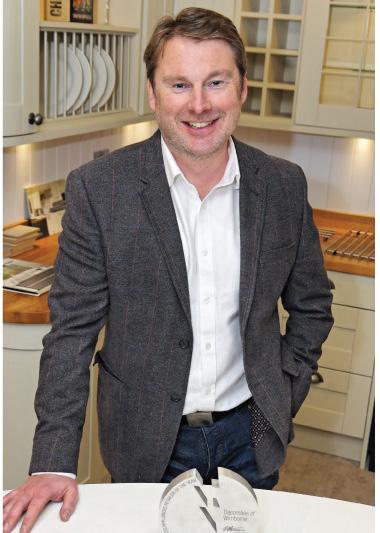
environmental impact.’
The solar panels are simply the latest in Dacombes climateconscious technological developments. Matt Renaut has also installed two EV chargers and a Tesla battery, the firm uses a heat pump and energy-efficient lighting and devices throughout its operations. Looking ahead, he is eyeing ‘phase two’ of their green energy initiative, which includes transitioning to electric delivery vehicles.
Dacombes’ commitment to sustainability recently earned it a nomination for Best Independent Retailer Focused on Sustainability Consumer Electronics at the upcoming Innovative Electrical Retailing Awards. Locally, the store supports the annual Planet Wimborne Green Festival.
‘Our aim is total energy self-sufficiency, despite the substantial investment,’ says Matt. We’re committed to a sustainable and responsible future, prioritising environmentally-friendly practices for long-term benefits to the planet alongside the significant savings to our business model.’
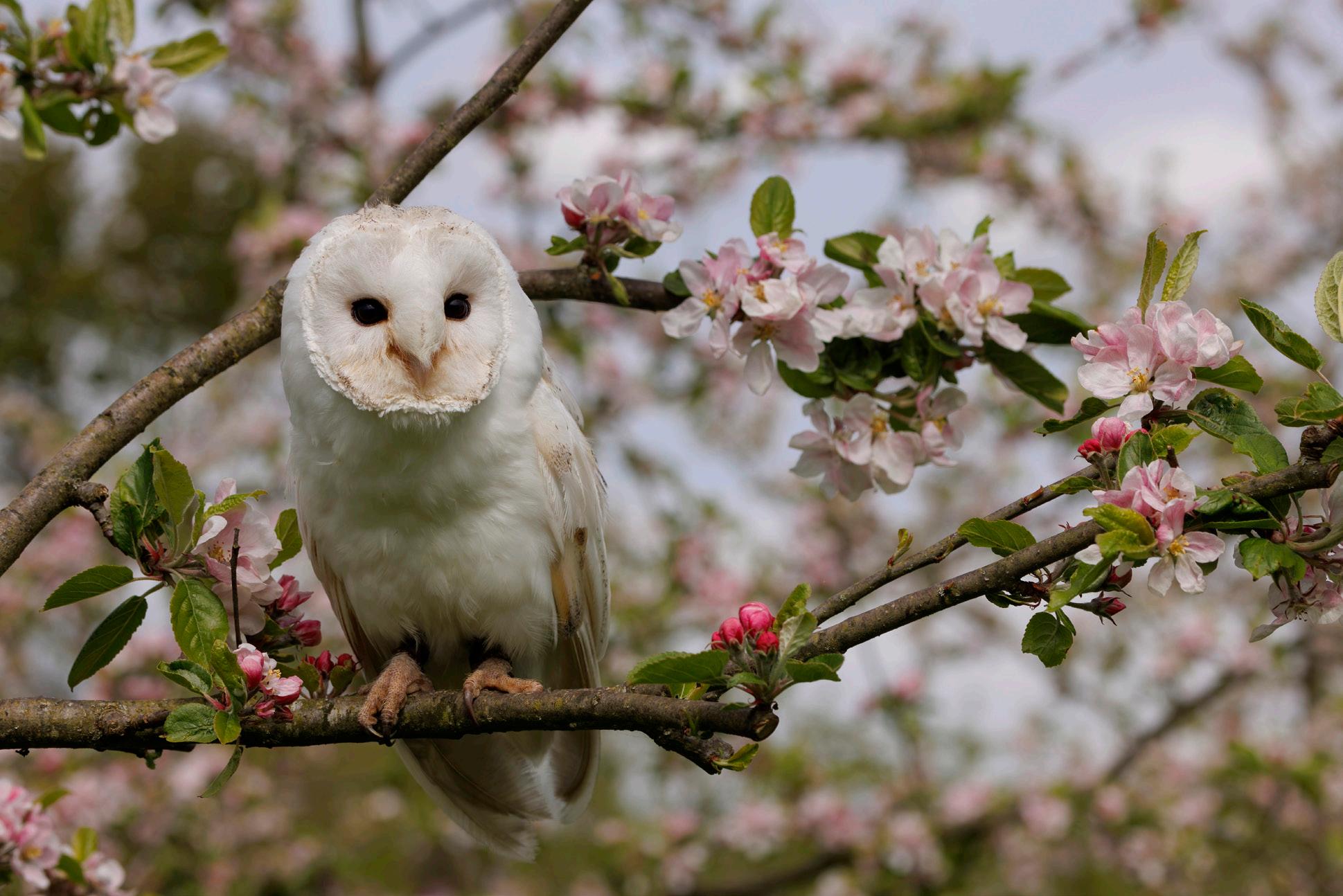
 Winston the Barn Owl
Claire Norris
Winston the Barn Owl
Claire Norris


Busy
Dave Taylor
Peek a boo goslings
Julia Rosser
We welcome photography submissions from readers – the only rule is that they must have been taken locally in the last month. Our cover shot is always selected from our submissions pile. If you’d like to join in, please share it in The BV community Facebook Group or simply email it to us on photos@bvmagazine.co.uk


 Swooping Mike Howson
A wet spring
Swooping Mike Howson
A wet spring

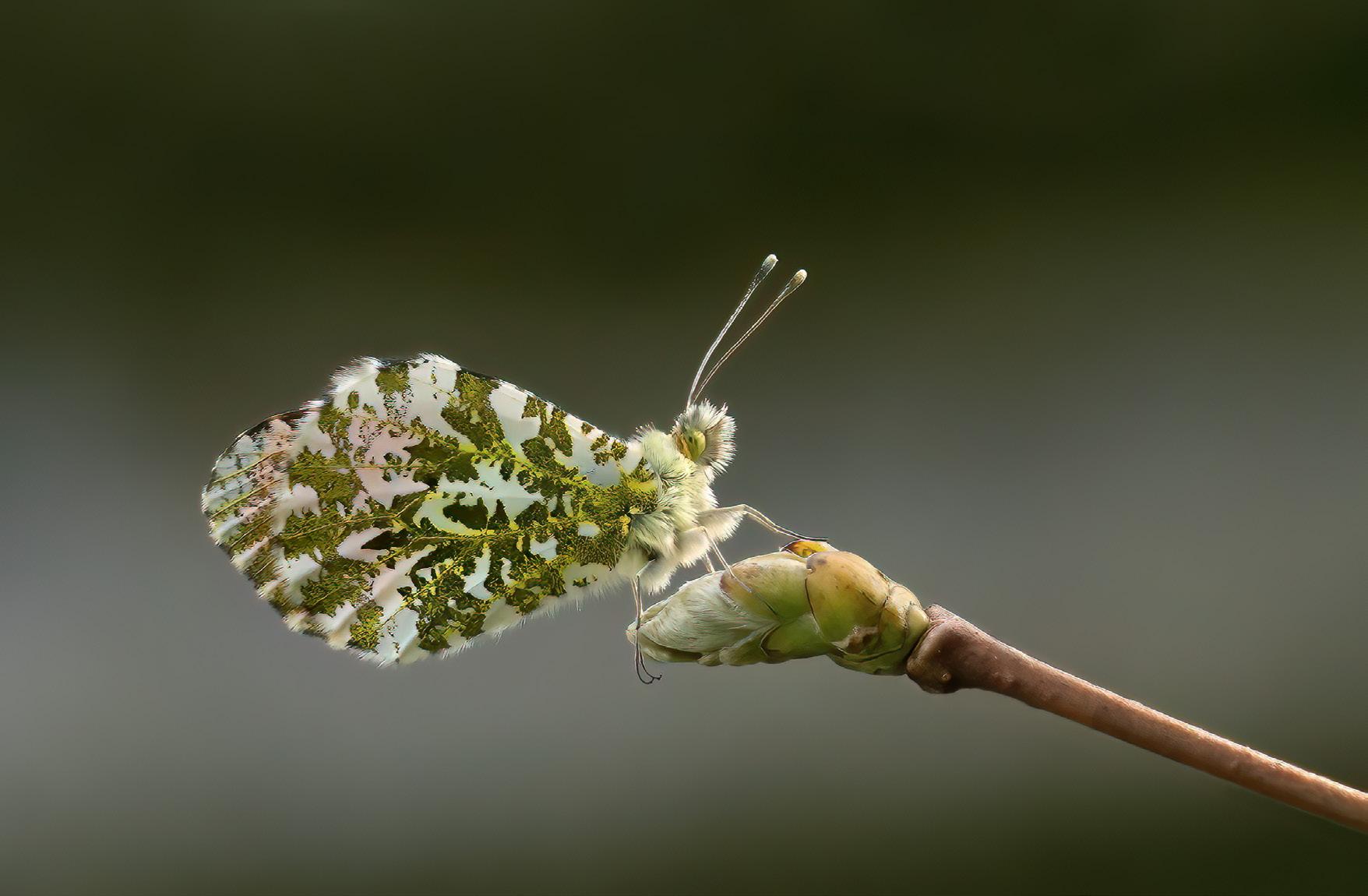 Ian Nelson Evening hover
Orange tip butterfly
Ian Nelson Evening hover
Orange tip butterfly

 Checking the wind
Tina Dawkins
Doves in the Blossom
Checking the wind
Tina Dawkins
Doves in the Blossom
Rob Nolan captures a fleeting, once-in-a-lifetime glimpse of the elusive Pons-Brooks comet – and what to see under the Flower Moon
This month’s image was intended for last month ... but as I was so excited to share my Aurora image from my surprise trip to Finland, this rather special comet got bumped a few weeks. Sorry 12P/PonsBrooks!
This comet last passed us here on Earth in 1954. During its flyby this year, it will reach perihelion (the point in the orbit at which it is closest to the sun) on 2nd June, when it will be 232 million kilometres from Earth.
However, our best views of the comet – with our telescopes and the naked eye – were back in March and April. Due to its low position on the horizon and our swiftly receding dark nights, the comet becomes increasingly difficult to see in the Northern Hemisphere as the year progresses, even though it is yet to reach its closest distance from us.
It will continue to be visible in the Southern Hemisphere, but will become less bright as it travels away from the Sun. This comet is also known as the Devil Comet. Its a cryovolcanic comet – literally an ice volcano flying through space. From time to time it erupts, sending bursts of ice and gas into space which cause it to appear much brighter for a few days. This
apparently happened around the 29th February, and again in early April, making the comet much brighter in the sky for a time.
This image was likely a one-off chance encounter for me – the Pons-Brooks comet won’t be visible in our night skies again for another 71 years, so it’s pretty unlikely that I’ll see it again, making it rather special. This image was taken during 2 nights in March using my Altair 70EDQR Refractor and Dedicated cooled mono astro camera. I was struggling with this data, so my friend Rick Voss who is an extremely talented Software Developer and Astrophotographer offered to help me out. He spent considerable time processing this image from my raw data and was able to create something quite special! Rick creates fantastic astro photographs – head over to rsastro.com to see more of his work!
Also known as the Devil Comet, it’s a cryovolcanic comet –literally an ice volcano flying through space
The night sky, May 2024 – Rob’s guide for your stargazing this month:
This month there aren’t many local objects to observe in our night sky, apart from the passing meteor shower, so it’s a good time to explore the universe through the pinlit curtain of endless stars and enjoy those later dark night skies. Constellations such as Boötes, Scorpius, Libra and Virgo are all great constellations to go hunting for this month if the mood takes you.
On 4th May, just before dawn, you’ll be treated to a view of a narrow crescent Moon with Saturn to the upper right at twilight. The big event this month is the annual Eta Aquarids Meteor Shower, peaking the evening of 4th/5th May – and we’re in for a great display this year, if the skies allow, as the Moon will not hinder our view. The Eta Aquarids are tiny pieces of Halley’s Comet, crashing into Earth’s atmosphere as we enter the comet’s trail of debris.
Halley’s Comet itself last appeared in our night
skies in 1986, and will next appear in 2061 (that’s a date to put in your diary!).
Two bright stars will be clearly made out next to the Moon on 12th May – these are Castor and Pollux, the twin stars in the constellation Gemini.
Watch the full Moon (May’s full Moon is also called the Flower Moon, or Milk Moon) sail under the bright star Antares on the night of the 23rd/24th May, though you’ll need to wake up early to watch this crossing.
Antares is the massive ruby-red star that is brightest in the constellation Scorpius. It is one of the largest known stars, about 700 times larger in diameter than the Sun and about 10,000 times brighter.
To close the month off on the 31st, before the dawn Saturn sits to the left of a crescent Moon, but Mars will also be shining bright close by. Until next time, clear skies!
 by Karen Geary, Nutritional
by Karen Geary, Nutritional

There are some questions that come up time and again, says expert Karen Geary – so she’s decided to tackle them head on
This month I decided to tackle the questions I get asked most frequently, both in clinic and online. If you have a question about health and nutrition, do feel free to ask on my Instagram or Facebook feed or email me at karen@amplifynutritionaltherapy.com.
Which diet is the best for weight loss?
This one’s simple: the diet that you can do most consistently is the best one for you. If you check the research, all diets work, whether it’s keto, fasting, low carb or low fat. And there is often very little between them in terms of resulting weight loss over time. Most of them work because they have a calorie deficit of some kind – and no, that’s not a fashionable view in some circles. It is true that some people struggle to lose weight for medical reasons, even though they are counting calories; it is unusual, but it can happen. Many clients come to me as a last resort for weight loss and only very occasionally do we find an underlying medical reason getting in the way. It is easy to over-estimate calorie intake. With most weightloss clients, I’ll get them to weigh their food at the start of working with me to get a proper handle on portion control. One way to see if you can estimate a portion size is to weigh your food ‘blind’ –with the scale covered up, add the portion you plan to eat – and then look at the weight. Try it!
What do you think of the Zoe app?
On the positive, I appreciate anything that raises

awareness about gut health, which is precisely what the Zoe team has achieved. I particularly like their advice about the importance of fibre in the diet –the vast majority of my clients do not eat their 30g daily requirement (you can check that yourself by looking at the fibre score using a free app such as Cronometer or My Fitness Pal).
On the other hand, you should absolutely not consider the Zoe app if you have a history of disordered eating. The app encourages people to eat food by colour code, and I have seen people become quite obsessed by it, leading to disordered behaviours. Personally I don’t want to be told what to eat by an AI algorithm. If your interest in Zoe comes from suffering with an underlying gut issue, my message is that there
are more comprehensive gut tests available. They don’t come cheap – but they’ll cost far less than the Zoe test and annual subscription. It can be a revelation for people who have suffered for years to finally see objective data as to what might be driving their discomfort.
What supplements do you recommend?
I don’t recommend supplements generally to the public, which is why you do not see me recommending them on socials. Supplements need to be tailored for need and condition.
A simple example is vitamin D3, which behaves like a hormone in the body, but is commonly referred to as a vitamin due to its role in calcium absorption and bone health.
Tests don’t come cheap –but they’ll cost far less than the Zoe test and annual subscription
Nearly everyone should take D3 over the winter, and some people should take it throughout the year. However, the dose needs to be targeted (by measuring current levels in the blood) and then tailoring accordingly. Additionally, I always like to recommend that D3 is taken in conjunction with vitamin K2, to ensure that calcium is properly absorbed into the bones. However I do not recommend it if someone is taking blood thinners, as K2 regulates blood clotting.

Many supplements can be contraindicated with medications, and I always undertake a full analysis of this before recommending any supplement. You can calculate your own vitamin D3 needs here, but it is always better to consult a healthcare professional if you are considering supplementation.
What is the most important universal diet advice?
1. Protein and plants with every meal
2. Don’t snack (unless you are an athlete or have an underlying medical condition).
Plants are essential for fibre and nutrient density –30g a day roughly translates to seven cups of veggies and two cups of fruit. People over-rely on grains and potatoes for their fibre, so try and diversify with different colours and types of plants to encourage optimum gut health.
Protein quantity depends on age, goals and overall health. However a decent amount of protein with each meal fuels brain, bone and muscle health and keeps you full for longer.
Breakfast is the meal where most people under-eat protein. A bowl of porridge or muesli isn’t enough! It’s why you will see me posting a lot of breakfast recipes on Instagram.
Three meals a day are sufficient for most people. However, individual dietary needs do vary, and some people – especially those with certain medical conditions or specific fitness goals – may benefit from more frequent, smaller meals.

Incorporating movement into your daily routine can really lift your spirits and sense of wellbeing, says Dorset Mind volunteer Annabel Goddard
For the 2024 Mental Health Awareness Week, from 13th to 19th May, we\re focusing on movement and how it can affect the way you feel. Many of us take how our body moves for granted, but dayto-day life can take a huge toll on us if we don’t regularly check in with how our bodies feel. Despite what the current weather would have you think, summer is just around the corner, so now is a great time to start practising tuning in to your physical body. No matter how small the movement, it can benefit you to get active.
Mindful moving
If you’re a fan of exercise, you probably already know how great you feel after a good workout. But some of us are restricted by mental or physical issues, so if, for whatever reason, you can’t go to the gym, the next best thing is stretching or moving mindfully. This can be done however you like – but the focus should be on your body and how it feels in the moment. Yoga is perfect for this, but you can start with some simple stretches. Focus on how it feels to be able to move, and try to think of things about yourself that you’re grateful for. You’ll feel much lighter and more relaxed afterwards! It’s also a great opportunity to address any aches and pains you may have not noticed before.
It’s no secret that going outside and spending time in nature boosts your mood – don’t ever underestimate it! Even on cloudy days, taking in fresh air and

looking at trees will help you feel more connected to yourself and the earth, especially after the winter months.
Having a short walk or run outside to disconnect from work and your phone will benefit your mental health massively. Not only will it boost your energy and wellbeing, but a gentle bit of sun will help you appreciate and feel grateful to be outside. Pay attention to how your body wants to move – some days you may not feel up to something energetic and it’s fine to honour your body by listening to it. You could also ‘stack’ your activities by doing some yoga or other exercise outdoors in the garden.
If you feel like going a bit further, a fun way to get yourself moving is by putting on some music and having a dance! You could do it while ironing, making

dinner, whenever – it’s a surefire way to release your happy hormones and energy, without feeling like a big effort. Moving your body for fun helps you relax and, most importantly, feel better!
Prioritising and appreciating your body’s ability to move will undoubtably boost your mood and keep you mentally healthy. Getting Active is one of the proven steps of the ‘Five Ways to Wellbeing’ that you can find out more about here.
• Visit Dorset Mind for local mental health support and ways to keep mentally healthy
• The Samaritans are there to listen 24/7, call them for free on 116 123
• Call Dorset’s mental health helpline Connection for support on 0800 652 0190


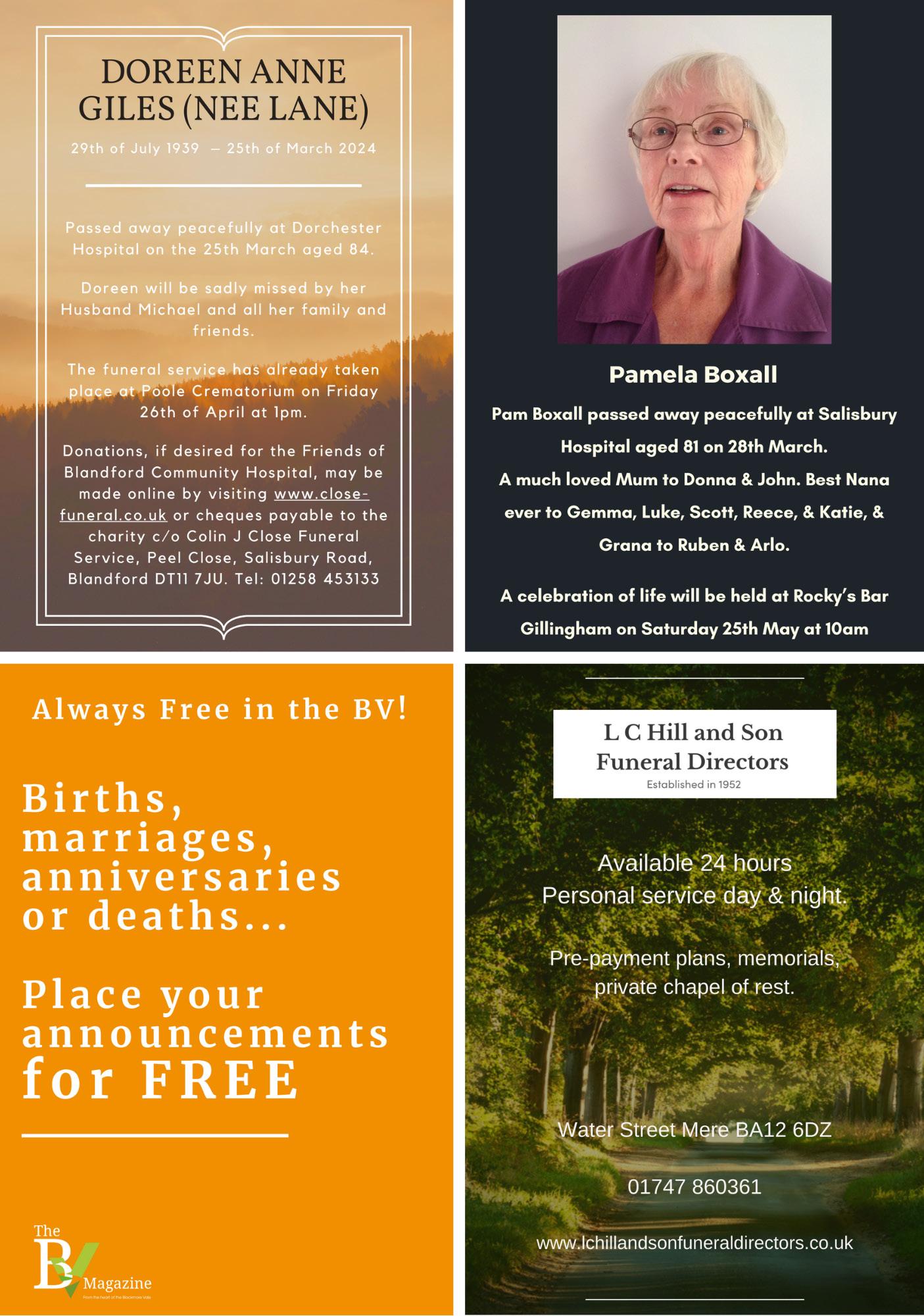

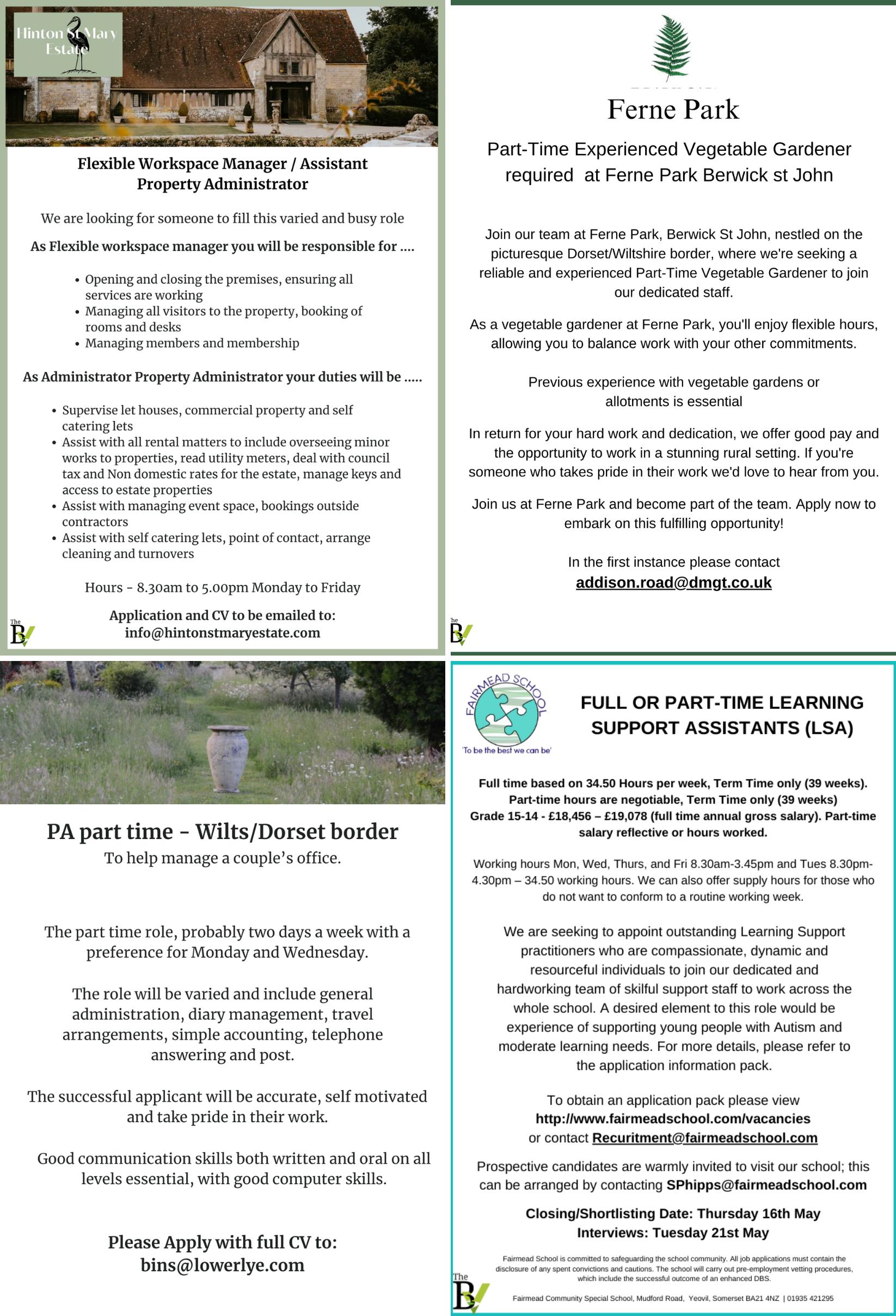


A n d t h e M a y m o n t h
f l a p s i t s g l a d g r e e n
l e a v e s l i k e w i n g s ,
D e l i c a t e - f i l m e d a s
n e w - s p u n s i l k .
– Thomas Hardy

G O T S
D o y o u t h i n k a l o c a l ( o r y o u r
o w n ) b u s i n e s s w o u l d m a k e a
g o o d p r o f i l e f e a t u r e ?
K n o w s o m e o n e d o i n g g o o d
t h i n g s t h a t w e s h o u l d t a l k a b o u t ?
S e n d a q u i c k e m a i l t o L a u r a :
e d i t o r @ B V m a g a z i n e . c o . u k
G e t i n t o u c h w i t h C o u r t e n a y t o c h a t
a b o u t w h a t y o u ' r e l o o k i n g f o r - w e ’ r e
a l w a y s k e e n t o t a l k t o l o c a l b u s i n e s s e s
l o o k i n g f o r n e w w a y s t o b u i l d t h e i r
p r o f i l e a n d r e a c h :
a d v e r t i s i n g @ B V m a g a z i n e . c o . u k
0 1 2 5 8 4 7 2 5 7 2
N e x t P u b l i c a t i o n D a t e :
7 t h J u n e
( d e a d l i n e 3 1 s t M a y )
T h e B V p u b l i s h e s o n t h e f i r s t F r i d a y
o f t h e m o n t h , a n d t h e a d v e r t i s i n g
b o o k i n g d e a d l i n e i s a l w a y s t h e
F r i d a y p r i o r t o p u b l i s h i n g